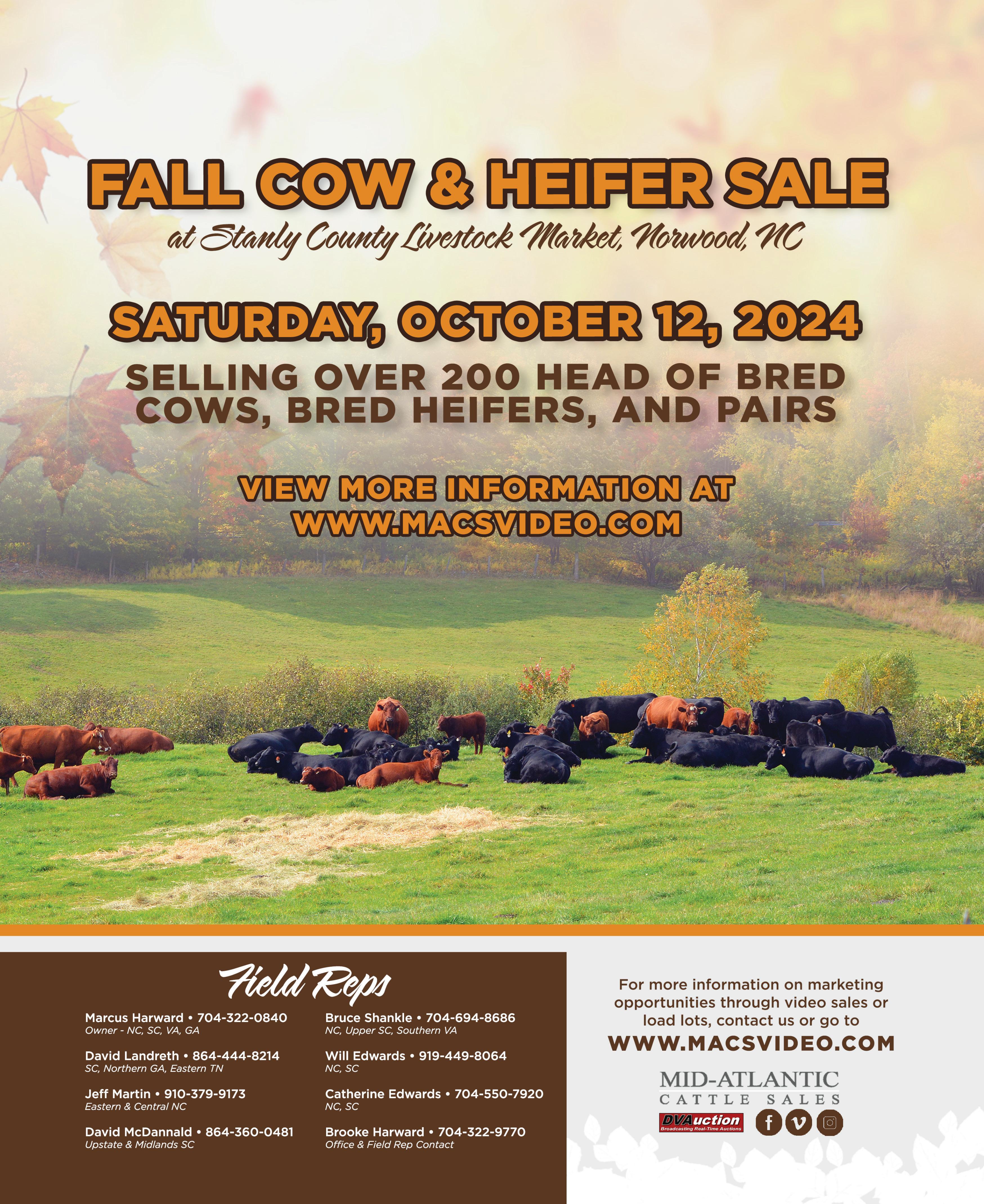




2024 South Carolina Sale Barn Cattle Receipts ...................................................................................................... page 94
2024-2025 Clemson Bull Test Program Kicks Off ................................................................................................... page 83
A Message from the CEO — Nothing Beats the Real Thing, by Colin Woodall ............................................... page 102
Amazing Grazing — Managing to Prevent Dallisgrass Staggers, by Dr. Matt Poore ........................................ page 22
American Angus Association News ......................................................................................................................... page 43
American Red Angus Association of America News ............................................................................................. page 51
American Angus Association President’s Update — September 2024 Board Meeting Highlights, by Barry Pollard ........................................................................................................................................................ page 48
Are Your Genetics Working for You on Sale Day? ................................................................................................. page 55
Ashley’s Beef Corner — Little League World Series and Beef Partnership, by Ashley W. Herring .............. page 20
Beef Checkoff News .................................................................................................................................................... page 84
Beef Cuts and Recommended Cooking Methods ................................................................................................. page 88
BioZyme News ............................... page 92
Boehringer Ingelheim News ..................................................................................................................................... page 68
Carolina Cooking — Cheesy Beef Artichoke Dip .................................................................................................. page 82
Cattle & Carbon — Storage of Soil Carbon in the Carolinas, by Alan Franzluebbers ......................................... page 30
Cattlemen’s Beef Board Update — National Beef Checkoff ROI Study Proves Value, Provide Benchmake for Current and Future Programs, by Ryan Moorehouse .......................................... page 90
Certified Angus Beef News ......... page 44
Clemson Corner — Andrae Named Director of Edisto REC ............................................................................... page 82
Cultivating Future Beef Industry Leaders — Insights from the PNC Feedlot Nutritionist Boot Camp, by Benjamin Rajo ...................................................................................................................................................... page 79
Director’s Report — Wrapping Up a Busy Summer, by Milo Lewis ...................................................................... page 3
E.B.’s View from the Cow Pasture — Size Matters, by E.B. Harris ....................................................................... page 26
Evaluating Fitness for Transport Decisions — Preparation and Training Opportunities, by Julia Herman, DVM ........................................................................................................................................... page 100
Fall Armyworms in Hayfield and Pastures, by Blake Layton ................................................................................ page 96
Federation of State Beef Councils Update ............................................................................................................. page 87
Five Tips for Weaning and Receiving Calves, by Dr. Shelby Roberts ................................................................... page 52
Forage News — Connecting Land and Livestock Managers
- A Community of Practice for the Carolinas, by Miguel S. Castillo & Liliane Silva ........................................ page 28
Ground Beef Thawing Tips ......... page 101
Have You Herd — Sheep and Goats in the Cow Pasture, by Makayla Holloman ................................................ page 32
Heeding the Cattle Call, by Lara Ivanitch .................................................................................................................. page 78
How Trace Mineral Status Affects Reproductive Efficiency in Bulls, by Laurentia van Rensburg .................. page 62
Hubbard News ................................ page 61
James W. “Pete” Patterson Passes ........................................................................................................................... page 77
National Cattlemen’s Beef Association News ..................................................................................................... page 102
National Cattlemen’s Beef Association President’s Report — Inaction on Traceability on Unacceptable, by Mark Eisele ......................................................................................................................................................... page 107
National Institute for Animal Agriculture News ................................................................................................... page 65
New NCCA Members for 2024 .................................................................................................................................. page 77
North American Limousin Foundation News ........................................................................................................ page 61
North Carolina Cattle Receipts, Trends, and Prices .............................................................................................. page 16
Pasture Management Systems, Inc. “Mile of Fence” Program Update ............................................................. page 75
Public Lands Council News ......... page 107
Purina News ................................................................................................................................................................. page 70
Red Angus Association of America News ................................................................................................................ page 51
Renovo Seed News ........................ page 95
Ridley Block News — A Simple Solution to Mineral Suppementation ............................................................. page 59
S.C Charolais News, by Georgeanne Webb ............................................................................................................... page 63
South Carolina Cattle Receipts, Trends, and Prices .............................................................................................. page 83
The Chaplain’s Corral — As Far as the East is From the West, by Tammy Burton .............................................. page 52
The History of Aberdeen Angus in the U.S., UK, and Worldwide Available Now! ............................................... page 38
The MVP — Most Valuable Protein .......................................................................................................................... page 91
The Simmental Trail, by Jennie Rucker ...................................................................................................................... page 67
Trending in Food and Media ...................................................................................................................................... page 89
Understanding Beef Quality Grades ....................................................................................................................... page 97
Why the Bull Matters?, by Nicolás Negrin Pereira, DVM ........................................................................................ page 81
You Decide, by Dr. Mike Walden ................................................................................................................................. page 34
Zoetis Quick Tips ............................ page 94
N.C. Cattlemen’s Association
President RYAN CLARK
5250 NC 772 Hwy. • Madison, NC 27025
Vice Presidents BRANDON BOWMAN
2346 Ann Street • Claremont, NC 28610
JIM LEDFORD
260 Mulberry Lane • Otto, NC 28763
JOEY CARTER
250 Penny Road • Beulaville, NC 28763
Immediate Past President SCOTT WEST
489 Panacea Springs Road • Littleton, NC 27850
NCBA Policy Division Director - JOHN LANGDON N.C. Beef Council Director BROOKE HARWARD
Beef Board Director - BRIAN WARREN
Secretary/Treasurer - EVERETT JOHNSON
Directors At Large
MATT POORE • NEIL BOWMAN • TODD SEE
Executive Director - MILO LEWIS 2228 N. Main Street • Fuquay-Varina, NC 27526
N.C. Cattlemen’s Beef Council
Director of Consumer Information
ASHLEY W. HERRING
Administrative Assistant - KIM BURDGE
S.C. Cattlemen’s Association
Executive Director - TRAVIS MITCHELL
P.O. Box 207 • Saluda, SC 29138
Phone: 803-609-2828
Email: twmitch@clemson.edu
Website: www.sccattlemen.wildapricot.org
Executive Committee
President - Joe Oswald IV
1st Vice President - Gene Crim 2nd Vice President - Ashley Mills
Secretary - Carol Hendrix
Treasurer - Eric Seymour
Past President - Timmy Benton
John Lewis, Chester • Joe Oswald, IV, Allendale
Ryan Whitehead, Union • Terry Kirkland, Batesburg
Lloyd Baxley, Georgetown • Joe Davis, Westminster
Michael Hall, Abbeville • Richard Sox, Lexington
Carol Hendrix, Westminister • Jamie Driggers, Hamer Bonnie Cann, Abbeville • Ashley Mills, Blair
Haskel Sexton, Sparanburg • Gene Crim, St. Matthews
Al McClain, Anderson • Eric Seymour, Columbia Timmy Benton, Walterboro
S.C. Beef Council
Executive Director - ERIN DOLL
P.O. Box 11280 • Columbia, SC 29211
Phone: 803-734-9806
Email: edoll@scda.sc.gov
Website: www.sccattle.org
Vol. 38, No. 10 OCTOBER 2024
Sales & Publication Office
2228 N. Main Street
Fuquay-Varina, NC 27526
Phone: 919-552-9111
Fax: 919-552-9216
Email: mail@nccattle.com
Website: www.nccattle.com
The Carolina Cattle Connection is printed on 30 lb recycled newsprint by BN Printing in Benson, N.C.
STAFF
Manager, N.C. MILO LEWIS
Manager, S.C. TRAVIS MITCHELL
Editor & Advertising Director
CASEY L. HINNANT
Assistant Editor & Proofreader KIM BURDGE
N.C. Circulation KIM BURDGE
S.C. Circulation TRAVIS MITCHELL
Material in The Carolina Cattle Connection is not to be reproduced in total or in part without the written permission of the Editor. All submissions become property of The Carolina Cattle Connection, but we make every effort to return items such as photographs and artwork as requested.
The Carolina Cattle Connection, the official publication of the N.C. Cattlemen’s Association and the S.C. Cattlemen’s Association is published monthly by the N.C. Cattlemen’s Association.
A complementary subscription is included with membership to each state’s association. Nonmember subscriptions are $30 per year.
All address changes for NCCA members to: The Carolina Cattle Connection 2228 N. Main Street • Fuquay-Varina, NC 27526
All address changes for SCCA members to: The Carolina Cattle Connection P.O. Box 207 • Saluda, SC 29138
The Value of Participating in a Wagyu Buyback Program, by Heather Smith Thomas … page 18
Wagyu — The Journey from Japanese Roots to American Plates, by Nicole Correa … page 11
Wagyu Beef Have Multiple Health Benefits, by Heather Smith Thomas … page 16
Wagyu Cattle Becoming Popular in the United States, by Heather Smith Thomas … page 6
Wagyu the WILD Way — A Memorable Stop on the AWA Post Conference Tour … page 12
What Are Wagyu? … page 4
Wilders On-Farm Store, by Heather Smith Thomas … page 14

By MILO LEWIS Executive Director, NCCA
The school buses are back on the road, signaling that summertime is coming to a close. From experiencing both extreme drought conditions and flooding in one season, many of you are likely thankful to have summer 2024 in the rearview mirror. While these extreme conditions could have a long term negative effect on your operation, I would like to share a few bright spots from this summer.
As many of you are aware, the youth livestock program in our state is thriving! Under the leadership of Brent Jennings, NCSU Youth Livestock Specialist, and his dedicated team, alongside the many livestock and 4-H agents, parents, and many more, numerous events are offered throughout the year for youth development. Alongside Ashley, we were able to participate in the Beef Chargrill Contest at 4-H Congress. It was impressive to see the level of food safety, nutrition, and general knowledge these participants had about the beef industry and grilling. It did not hurt that everything we sampled was also delicious!
One of the highlights from my time in the program years ago was the livestock judging and skillathon program. I always enjoyed the friendly competition and, more importantly, having the chance to see friends from across the state. Many of whom I am still friends with today and work alongside in my professional role at the association. It was rewarding to attend this year and witness the excitement of all those involved and learn about the expansion of all the great contests, which now include not only livestock judging and skillathon, but also quiz bowl. You would be absolutely amazed to witness the level of comprehension of our industry that the youth have at such an early age!
The N.C. Junior Beef Round-Up was also another blast from the past event that took place. It was incredible to see how members from the NCDA Livestock Marketing and Vet Division, NCSU Youth Livestock, and area livestock agents,

along with our staff at the Cattlemen’s Association, work together to provide such a laid back, fun, and educational opportunity. Contests provided ranged from graphic design, team fitting, judging, and a skillathon to the actual livestock shows. I would be remiss if I didn’t mention the dedication from those individuals, businesses, and county Farm Bureaus who generously sponsored this event.
Outside of all the fun youth programs, this summer has been jam packed with engagement opportunities to promote our industry. We have hosted congressional staff members on farms, engaged with delegations from the Ministries of Agriculture of Botswana, Zimbabwe, and Malawi, and a delegation from the United Kingdom, just to name a few. We have also worked alongside other commodity groups in the kickoff stage of developing research priorities for both the Plant Science Initiative and the Food Animal Initiative at N.C. State University. Connecting your needs on the farm with applicable research is a priority for the association.
As we go into the fall, we have a full calendar of events that focus on the promotion of your industry. We are also in the early stages of planning for the 2025 N.C. Cattlemen’s Association Annual Conference that will be held February 21–22 in Hickory.
I look forward to seeing many of you at the upcoming field days, county meetings, and youth livestock events!
Assessment Vote Reminder – On October 30, there will be a North Carolina Cattle Industry Assessment Referendum, which takes place every six years. With the passage of the referendum, which was first established in 1957, the N.C. Cattlemen’s Association would continue to collect $1.00 per head sold within the state.
All cattle owners who are at least 18 years of age as of October 30 will be eligible to vote. Voting will take place at
the N.C. Cooperative Extension offices. All eligible voters must vote in their county of residence. Absentee ballots may be obtained by contacting your N.C. Cooperative Extension office.
It is evident through past results that
when we all work together, we can do big things! I encourage each of you to visit your local extension office to participate in the referendum on October 30. Feel free to reach out for additional details on voting procedures or funding priorities.


Wagyu – a Japanese beef cattle breed –derive from native Asian cattle. ‘WAGYU’ refers to all Japanese beef cattle, where ‘Wa’ means Japanese, and ‘gyu’ means cow. Wagyu were originally draft animals used in agriculture and were selected for their physical endurance. This selection favored animals with more intra-muscular fat cells – ‘marbling’ – which provided a readily available energy source. Wagyu is a horned breed, and the cattle are either black or red in color.
Wagyu Breed History in Japan - There is some evidence of genetic separation into the Wagyu genetic strain as much as 35,000 years ago. Modern Wagyu cattle are the result of crossing the native cattle in Japan with imported breeds. Crossing began in 1868 after the Meiji restoration in that year. The government wanted to introduce
Western food habits and culture. Brown Swiss, Devon, Shorthorn, Simmental, Ayrshire, and Korean cattle were imported during this period. The infusions of these British, European, and Asian breeds were closed to outside genetic infusions in 1910.
The variation of conformation within the Wagyu breed is greater than the variation across British and European breeds. The three major black strainsTajiri or Tajima, Fujiyoshi (Shimane), and Kedaka (Tottori) evolved due to regional geographic isolation in Japan. These breeding differences have produced a Japanese national herd that comprises 90 percent black cattle, with the remainder being of the red strains Kochi and Kumamoto. For more information on the genetic diversity of the breed, visit wagyu.org/breed-info/wagyu-origins

In Vitro Fertilization (IVF) & Embryo Transfer (ET)
* On-farm aspiration of oocytes via Ultrasound Guided Ovum Pick-Up (OPU).
* Embyos come back in 8 days for placement or direct thaw freezing on-farm.
* Can do on donors aged 8 months and older, up to 120-150 days pregnant Doesn’t interfere with pregnancy.
* Pregnant cows work really well, so the cow doesn’t get out of her production group.
* Can do a donor every 2 weeks.
* NOW AVAILABLE * Small Ruminant Laparoscopic Artificial Insemination (AI) & Embryo Transfer (ET)
Oocytes fertilized at BoviteqUSA in Madison, Wisconsin. www.boviteq.com

For more information, contact: PAT COMYN, DVM P.O. Box 555 Madison, Va. 22727 540-829-3625 (cell) • 540-948-5238 (office/fax) pcomyn@verizon.net Visit us online at www.vhhms.com.
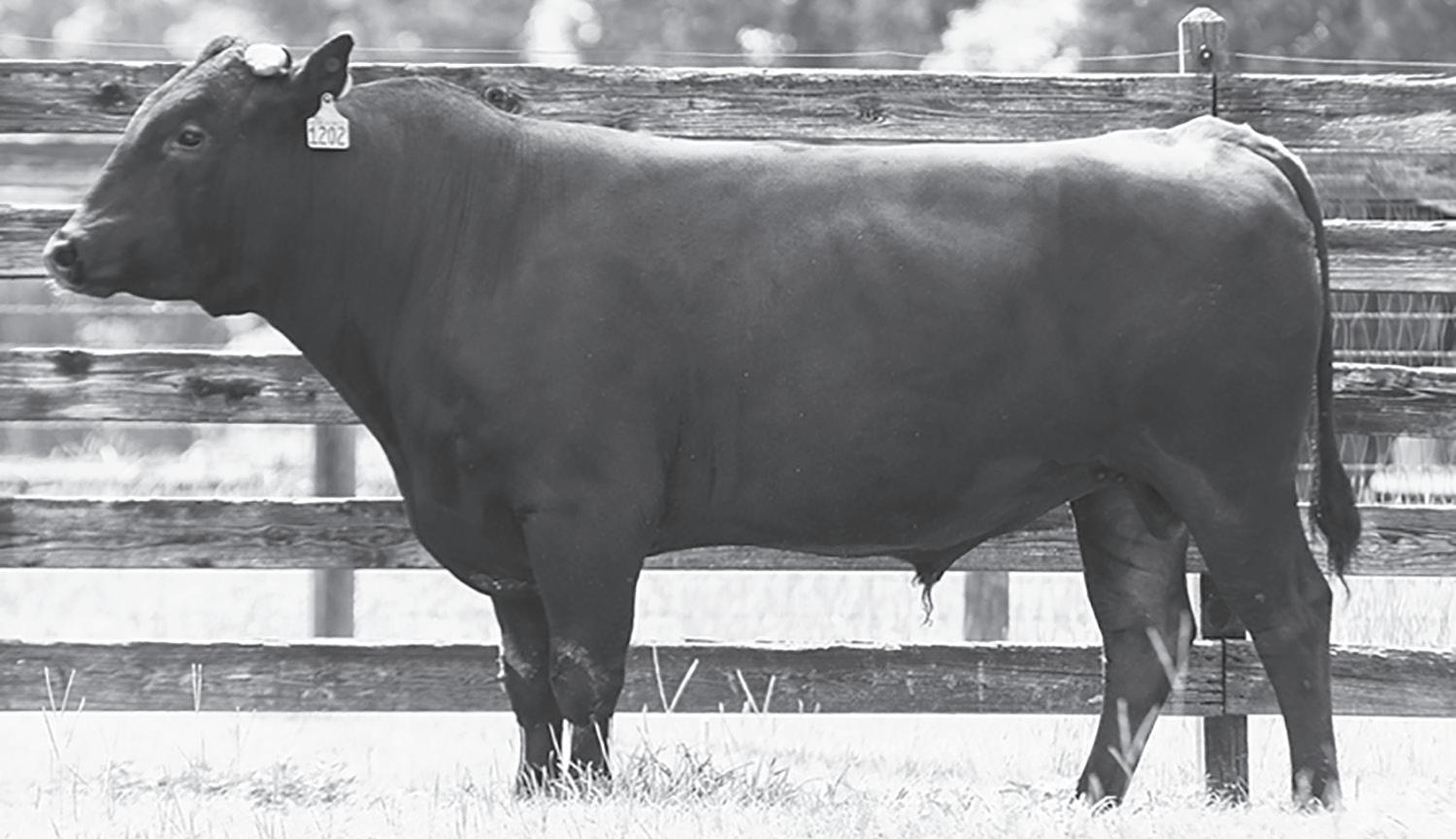
In Japan, there are four breeds that are considered Wagyu, and those are the Japanese Black (the predominant Wagyu exported to the U.S.), Japanese Brown (In the U.S. referred to as Red Wagyu), Japanese Polled, and Japanese Shorthorn. There are no Japanese Polled or Shorthorns being bred outside Japan. Wagyu strains were isolated according to prefecture (state), and breeds imported for crossing were not the same in each prefecture.
The production of Wagyu beef in Japan is highly regulated, and progeny testing is mandatory. Only the very best
proven genetics are kept for breeding. Realizing the value of their unique product, the Japanese government banned the export of Wagyu and declared them a national living treasure. Zenwa is the government held entity in Japan that oversees the Wagyu registry for Japanese Black, Brown, Polled, and Shorthorn. Wagyu Breed History in U.S. - Wagyu cattle were first imported in 1975 when two black and two red bulls were imported by Morris Whitney. In 1989 the Japanese began to reduce their tariffs on imported beef, which encouraged U.S. producers to

produce a high quality product for Japan. In the 1990s, there were several importations of quality Wagyu. Most were black, but a few were Red Wagyu. These cattle have the greatest influence on the U.S. herd and those in many other countries.
Most U.S. production was exported to Japan until 2003 when BSE was discovered, and Japan and other countries stopped the import of beef for the United States. However, chefs and others in the U.S. were aware of the superior eating quality of Wagyu and the domestic market then and now utilize much of the U.S. production.
Wagyu Beef — Delicious and Healthy - The unique taste and tenderness of highly marbled Wagyu beef makes for an unrivaled eating experience. That is why Wagyu beef is finding its way into the repertoires of gourmet cooks and fine restaurants across the United States.
Not only is it a gastronomic delight, but it’s healthy for you too. Health experts have discovered the mono-unsaturated
to saturated fat ratio is higher in Wagyu than in other beef, and the saturated fat contained in Wagyu is different. Forty percent is in a version called stearic acid, which is regarded as having a minimal impact in raising cholesterol levels. The profile of marbled Wagyu beef is more beneficial and healthier for human health.
Wagyu is also higher in a type of fatty acid called conjugated linoleic acid (CLA). Wagyu beef contains the highest amount of CLA per gram of any foodstuff – about 30 percent more than other beef breeds – due to higher linoleic acid levels. Foods that are naturally high in CLA have fewer negative health effects.
U.S. Wagyu Today - The American Wagyu Association was incorporated in Texas on March 14, 1990, and serves to register Wagyu cattle in the U.S., Canada, and other countries. The Association headquarters are based in Post Falls, Idaho. The Association has a vibrant membership base and continues to promote and develop
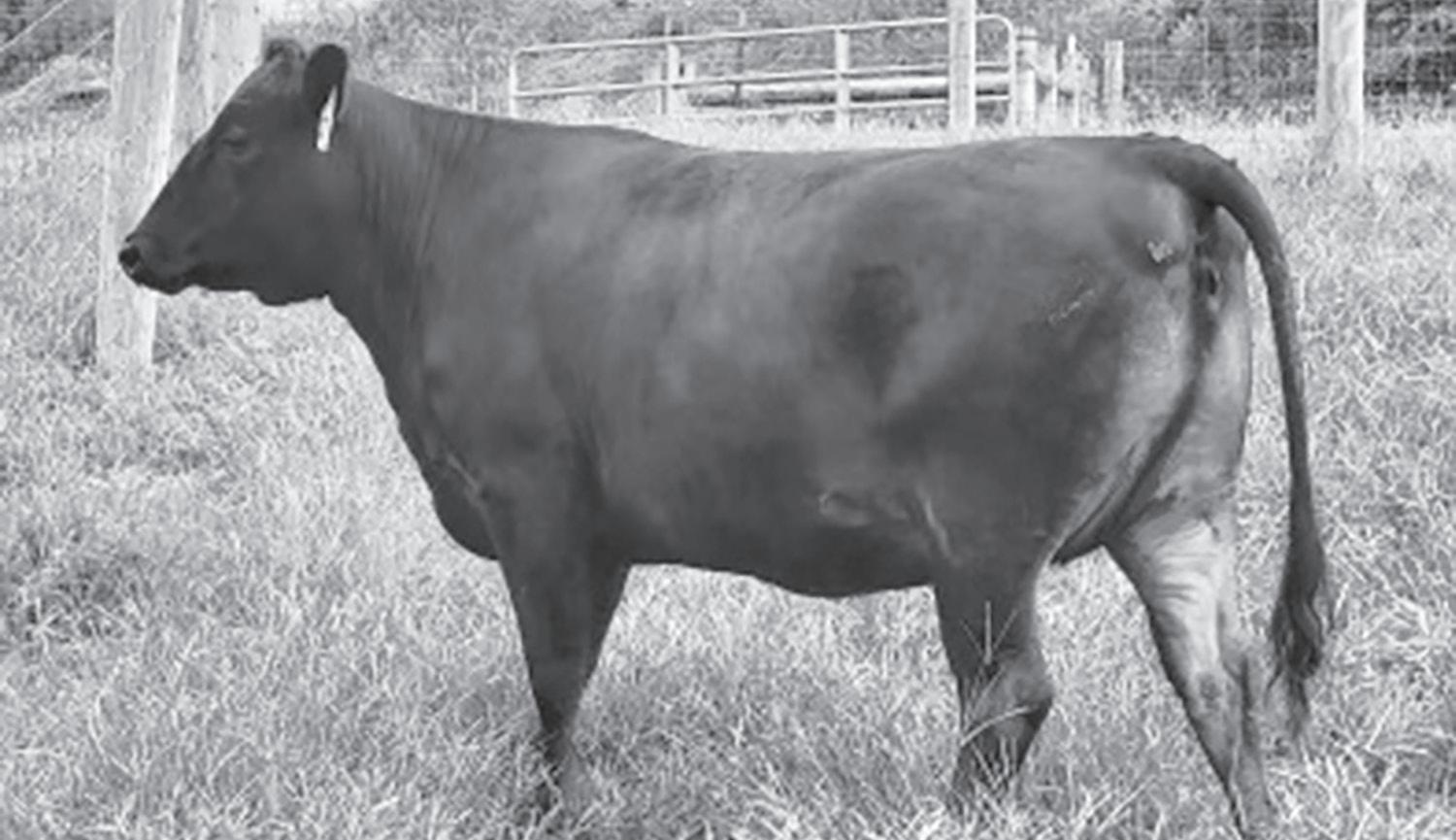
a sustainable industry here in the United States.
The opportunities Wagyu beef can offer are endless. This industry caters to the breeder/feeder targeting the high end restaurant trade with highly marbled beef to the bull producer supplying the cow/ calf rearer a crossbred alternative that will
offer calving ease ability and premium carcass quality in a single cross which no other beef breed can come close too.
The Wagyu breed has a vital role to play in the U.S. to increase the quality of red meat produced in the U.S. that our health conscious consumer of the 21 st century is forever seeking.

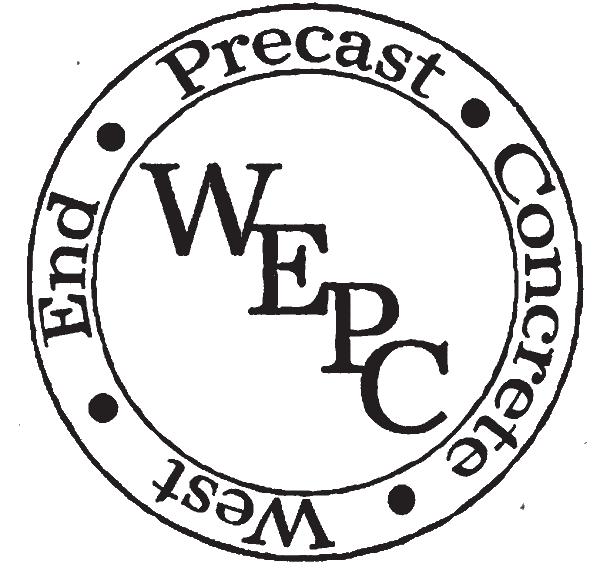

By NICOLE CORREA Clemson University
As we feature Wagyu as our breed of the month, it’s the perfect time to delve into the fascinating history of Wagyu in the United States. To shed light on this subject, I reached out to Michael DuPonte, a former extension agent at the University of Hawai‘i. Known for his pivotal role in introducing Wagyu genetics to the Hawaiian Islands, Michael’s connection with Washington State University played a crucial part in bringing these esteemed cattle to the United States. Additionally, Dr. Jerry Reeves, professor emeritus of Washington State University and influential ranch owner, provided valuable insights into the introduction of Wagyu cattle into the American market.
The journey of Wagyu cattle to the U.S. began in 1975, when a modest shipment of four Wagyu cattle was brought to the United States. These early imports marked the start of a long and complex process of integrating this prized breed into American agriculture. By 1989, the potential of Wagyu had caught the attention of the academic and agricultural communities. Faculty from Washington State University were granted a unique opportunity to visit Japan to explore Wagyu genetics and discuss the
possibility of exporting live animals.
This pivotal visit led to a historic import permit being issued in 1993, allowing the entry of approximately 30 bulls and 200 cows into the United States. The promise was to supply high quality F1 meat to the Japanese market. For a time, the U.S. and Australia became significant suppliers of meat to Japan, with most of these animals being Wagyu x Angus crosses called F1s. Unfortunately, this promising venture faced a severe setback in 2003 due to an outbreak of Bovine Spongiform Encephalopathy (BSE), commonly known as mad cow disease. The outbreak halted the export of meat to Japan and devastated the market, leading to the sale of this unknown product at significantly reduced prices into the U.S. marketplace. This crisis severely impacted the U.S. Wagyu market for about 18 months, or until the restaurant trade realized the superiority of this product. Many producers managed to preserve their genetics and help develop the U.S. market.
Understanding the types of Wagyu cattle is crucial for appreciating their impact and adaptation in the United States.
There are four primary breeds of Wagyu, each with unique traits, but only two of

those breeds are used outside of Japan.
• Kuroge Washu (Japanese Black)
– Renowned for its exceptional marbling and rich, buttery texture. However, Kuroge Washu cattle are also known for their slower growth rates, which can be a consideration in commercial production.
• Akaushi (Japanese Red) – Recognized for its marbling and growth patterns, Akaushi is one of the two Wagyu breeds that have been integrated into U.S. breeding programs.
• Mukaku Washu (Japanese Polled)
– This breed is naturally hornless and less common. It has different traits compared to other Wagyu types but is not used outside Japan.
• Akage Washu (Japanese Brown) –Known for their distinctive coloration and unique characteristics, Akage Washu are another breed found only in Japan.
The integration of Wagyu into U.S. cattle herds posed several challenges. Japanese Wagyu breeds, such as the Kuroge Washu and Akaushi, had to be adapted to the American environment, which included differences in climate, feed, and breeding practices. Some key considerations when selecting genetic lines include:
• Tajima Strains – These are known for their superior marbling but also exhibit lower growth rates. While they produce high quality beef, their slower growth can be a drawback in commercial contexts.
• Totori/Shamani Strains – These strains offer better growth rates and are more suited to balancing quality with efficiency. They are often chosen by breeders who seek to optimize both marbling and growth.
In the U.S., the highest beef grade is USDA Prime. In contrast, Japan has a more detailed grading system with 12 levels, including the prestigious A5 grade. Japanese A5 beef represents the pinnacle of yield grade and marbling, but this grading system is unique to Japan and does not directly translate to American standards. American consumers have specific preferences that influence how Wagyu is bred and marketed:
• Consumer Preferences – In the U.S., beef that exceeds USDA Prime is
often sufficient, provided it meets size expectations (12-16 oz. or more). This has led to a focus on breeds that are optimized for feed efficiency and growth.
• Hybrid Breeding – Many American breeders have adopted a hybrid approach, combining Japanese Wagyu genetics with domestic breeds. This strategy aims to achieve a balance between high quality marbling and efficient growth, catering to both traditional Japanese standards and American market demands.
Today, Wagyu beef enjoys significant acclaim in the U.S. and is valued for its luxurious marbling and adaptability. American breeders have successfully integrated Wagyu genetics with local cattle breeds, creating a product that meets the expectations of both Japanese and American consumers. This evolution reflects a blend of heritage and innovation, showcasing the ability to adapt a cherished tradition to new market realities.
In summary, the history of Wagyu in the U.S. is a testament to the challenges and successes of integrating a beloved Japanese breed into American agriculture. From its origins in Japan to its status in the U.S. and worldwide, Wagyu beef continues to offer a premium product that resonates with consumers, honoring its rich heritage while adapting to contemporary tastes and needs. As Michael DuPonte has stated, “Wagyu genetics still plays a pivotal part in the grass finishing of Hawaii’s cattle.” Given the importance of grassfed cattle to the success of the South Carolina beef market, introducing Wagyu to local herds seems like a promising opportunity. For those interested in incorporating Wagyu genetics into your herds, you can visit www.wagyu.digitalbeef.com for more information or, as always, contact your local livestock and forages agent.
References
Dr. Jerry Reeves, Interviews JanuaryAugust 2024
Michael DuPonte, Interviews JanuaryAugust 2024 www.texasmonthly.com/bbq/historyof-texas-wagyu




By HEATHER SMITH THOMAS
As more people discover the advantages of Wagyu for producing high quality beef, a growing number of cattle breeders are raising this unique breed. Some people who have never raised cattle before are also giving it a try.
Dr. Jerry Reeves (retired from the Animal Science Department at Washington State University) was one of the first Americans to become familiar with this breed. Today he runs a large herd of black Wagyu that winters along the Snake River in Washington and summers in the Idaho mountains.
Reeves was part of a team sent by WSU to Japan in 1989 to assess the Japanese beef industry. “We knew the Japanese were going to take quotas off imported meat in 1991, so the university sent us over there to figure out how our state could capitalize on sending meat to Japan. Here on the West Coast, we are closer to Japan than beef producers in the Midwest. Any advantage we might have over the corn fed beef in the Midwest would be helpful,” he explained.
“We hadn’t seen Wagyu before, and when we saw their carcasses, we realized the Japanese beef was superior to ours. We thought the best way to attract Japanese buyers would be to bring some of those genetics to the U.S. to produce high quality carcasses. Our competition for this export market would be Australia, and if we could send a better quality meat into Japan, we’d have more of the market,” said Reeves.
“The Japanese government let us bring some Wagyu into the United States. At that time, my wife and I had Angus and Simmental and decided to try Wagyu,” he said.
They have some unique traits that are different from American beef cattle, and they were the first imported breed that wasn’t brought in with a goal of trying to make our cattle bigger. “They are smaller than our typical beef cow; we were trying to increase quality rather than growth and production traits,” said Reeves.
The first Wagyu breeding program in the U.S. was focused on producing bulls that could be bred to cattle here
(especially Angus) to produce crossbreds for the Japanese market.
“For a while, all the half blood Wagyu meat produced was exported to Japan. The best thing that happened to our market was Mad Cow Disease. We couldn’t export meat to Japan; it all had to go into our restaurants. Americans were finally able to try Wagyu. They got it pretty cheap that first year because cattle feeders needed to find a home for the meat,” explained Reeves.
After the American people tried it, they wanted more. Now there’s a bigger market for this meat in the U.S. than in Japan. Introduction to Wagyu started the evolution of a new concept in beef production in the United States.
“It is a superior product, more highly marbled, with more tenderness and flavor. These cattle don’t look like our cows, and cattlemen have to learn about these unique animals. Now many large ranches in the Western U.S. breed their heifers to Wagyu bulls for ease of calving and receive a premium for the calves.”
Wagyu Has a Lot to Offer the Beef Industry – “Wagyu carcasses are superior to what we see in other cattle,” said Reeves. Some ranchers are producing half blood animals as a terminal cross for beef.
Bob Estrin, Lone Mountain Ranch near Golden, N.M., feels this breed has moved from a small niche industry to a nationally recognized and thriving enterprise. Calves are small at birth, and this factor, coupled with premiums at market, is attractive to many ranchers. Wagyu sired calves often bring more money per pound than other calves when they enter the feedlot.
“They weigh in a little lighter, but if the heifer didn’t have calving problems, this is a plus,” said Reeves. The producer generally has a higher percent calf crop and fewer losses. A heifer experiencing an easy birth has a quicker recovery and a better chance to rebreed on time.
“We work with some producers who breed 100–700 heifers a year. They can’t afford calving problems,” said Reeves. Using Wagyu bulls on heifers eliminates risk.
Importance of Marketing – Estrin says these cattle don’t fit the market for commercial beef cattle. You can’t just take Wagyu to a sale barn. “Wagyu cattle look so different that buyers of commercial cattle who are unfamiliar with this breed won’t give top dollar for them. Yet, marketed properly, Wagyu bring substantial premiums,” he said.
There are many factors to consider, according to Charles Gaskins, a Washington cattle breeder and animal scientist retired from the faculty at WSU. “Lighter calves bring more money per pound, and if you get a premium because of higher carcass quality, and have easy calving and better breedback on the heifers, it’s a win-win,” he said.
“The people who can take advantage of these benefits are producers with enough cattle to sell by the truck load. If you only have six or eight calves, the advantage isn’t that great unless you figure out a way to market them — through a co-op, directly to consumers, or to the restaurant market,” said Gaskins.
“Most people want to maximize marbling. This may or may not be a good thing, depending on your market. These cattle are fed at a relatively slow rate in the feedlot, eating less, finishing slower than typical beef animals, and eating a lot less grain. A daily gain of about two pounds is standard for cattle that will be 1,600–1,800 pounds final weight. Because of lower energy requirements, their lower rate of gain is not detrimental.

In conventional cattle feeding, people try to maximize the rate of gain in the feedlot, but in this case, you don’t need to,” Gaskins explained.
“Anyone who wants to cross Wagyu with other breeds to improve meat quality needs to think it through, regarding a market plan. Some of my colleagues say it won’t work because you lose on the growth side. Others think this is the way we need to go in the future — incorporating Wagyu into other breeds to improve meat quality,” he said.
It is important to understand the difference between a fullblood and a purebred. Some also feel it is important for consumers to know whether the product they are eating is 100 percent Wagyu or a percentage animal. “The consumer wants higher quality in terms of marbling and is entitled to accurate labeling,” Estrin said. Some half Wagyu beef is passed off as Wagyu, and even though it is very good eating, it is not as highly marbled.
In most breeds, a “purebred” is an animal that is 100 percent, whereas a 100 percent Wagyu is referred to as a “fullblood.” A purebred Wagyu is any animal having 93¾ percent or greater Wagyu blood, requiring at least four generations of crossing with fullblood genetics. A fullblood Wagyu, to be registered, must be DNA tested, verifying that it is the offspring of a fullblood sire and fullblood dam and tracing the ancestry back to the original Japanese lineage.
Our advertisers are “Champions” too. For expert A.I., superior genetics, the best in purebreds and outstanding farm supplies, check the Classifieds in this issue!
On September 15, Wilders Wagyu in Turkey, N.C., had the distinct honor of hosting the first stop on the American Wagyu Association’s post conference tour. The farm welcomed over 45 attendees from around the world, including participants from the United States, Mexico, Costa Rica, the United Kingdom, Japan, and Colombia. After wrapping up a multiple day conference in Williamsburg, Va., these guests were eager to experience Wagyu production firsthand and see what sets Wilders Wagyu apart.
The tour kicked off with an authentic Eastern N.C. shrimp boil, hosted by the Wilders farm team. Attendees were treated to a taste of seafood, highlighting the farm’s proximity to the coast — just
an hour away in Sampson County. This culinary introduction not only offered a warm welcome but also showcased the rich flavors of the region, setting the tone for an immersive and flavorful experience on the farm.
Following this coastal feast, guests embarked on an insightful farm walkthrough, highlighting the unique practices and commitment to quality that define Wilders’s approach to Wagyu and Berkshire pork production. Attendees had the chance to observe the farm’s fullblood Wagyu operation as well as the Berkshire hog operation, gaining a comprehensive view of Wilders’s dedication to diversified, high quality livestock farming.
One of the standout moments of the
day was a live OPU (Ovum Pick Up) session, facilitated by Vytelle, Wilders’s reproductive technology partner. This demonstration offered an up close look at advanced breeding technologies and sparked engaging discussions about the future of Wagyu genetics. Attendees also witnessed a thrilling cutting horse demonstration, showcasing the versatility and skill of Wilders’s performance horse program, which plays an essential role in the farm’s operations.
Culminating the event was a culinary presentation by the Wilders team. Local chef Luis Zouain, from Raleigh, N.C., and Dampf Good BBQ, from Cary, N.C., crafted an exceptional culinary experience that celebrated the rich flavors of Wagyu beef. This demonstration not
only delighted the guests’ palates but also emphasized the superior quality and taste of Wagyu raised the WILD way.
The visit to Wilders was part of a larger tour, with attendees set to explore other Wagyu operations in Virginia over the next few days. However, the time spent at Wilders set a high standard, providing a memorable blend of education, innovation, and culinary excellence.
Wilders Wagyu expressed its gratitude for the opportunity to host such a distinguished group and share its passion for Wagyu with a diverse audience. It was an afternoon filled with learning, connection, and a shared appreciation for the Wagyu breed, leaving a lasting impression on all who attended.



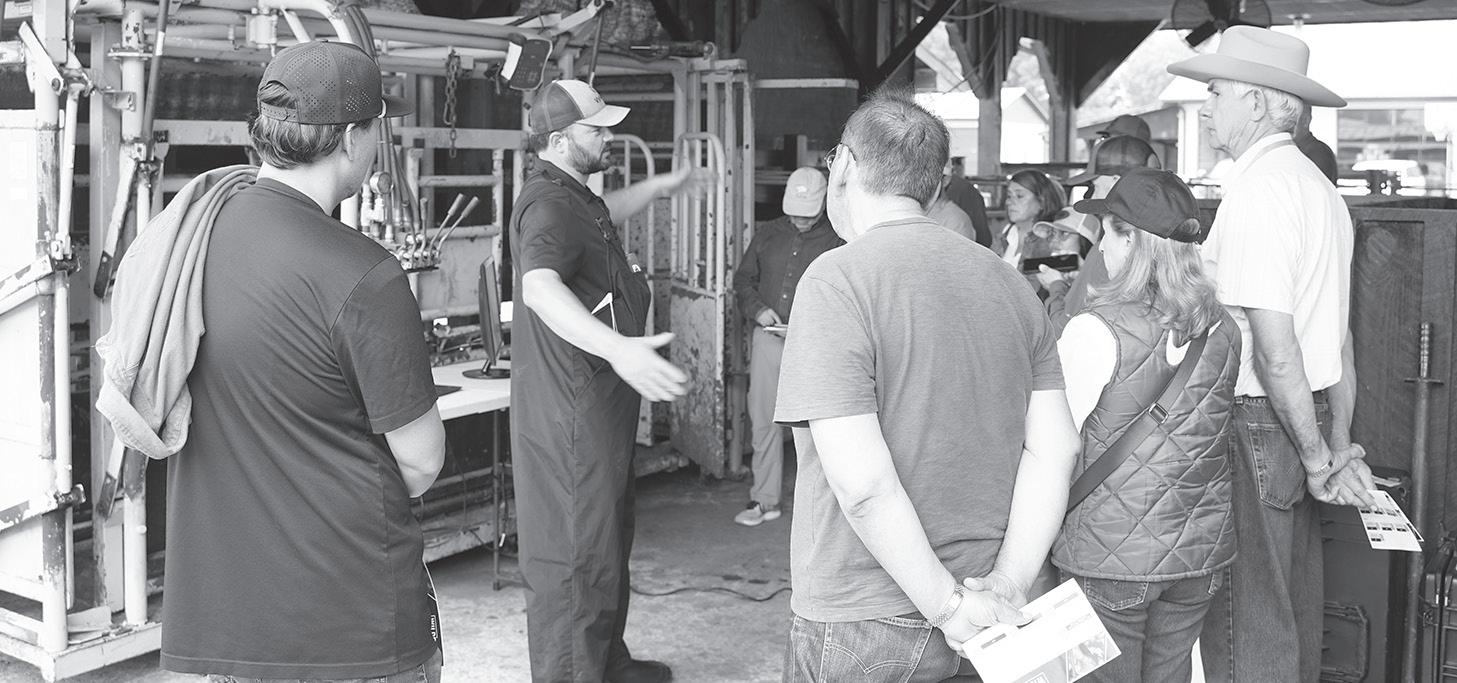

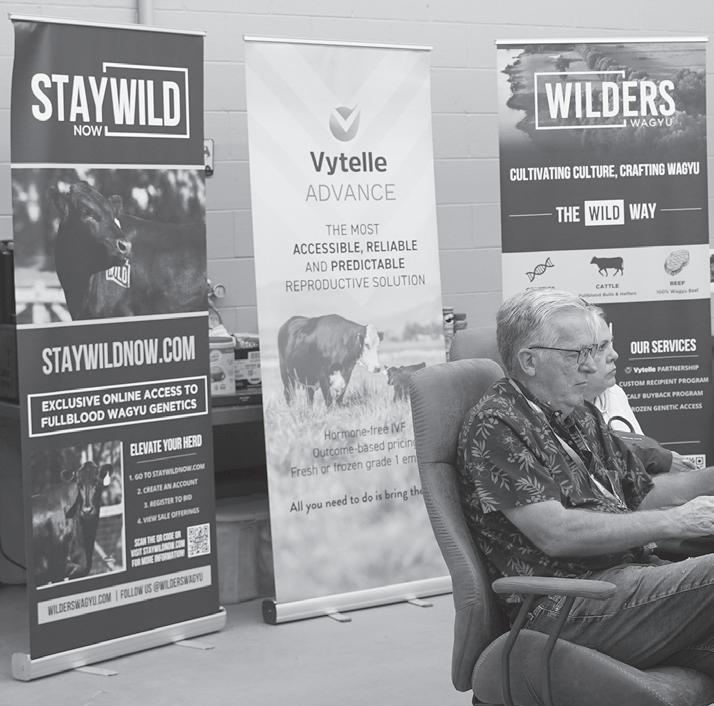


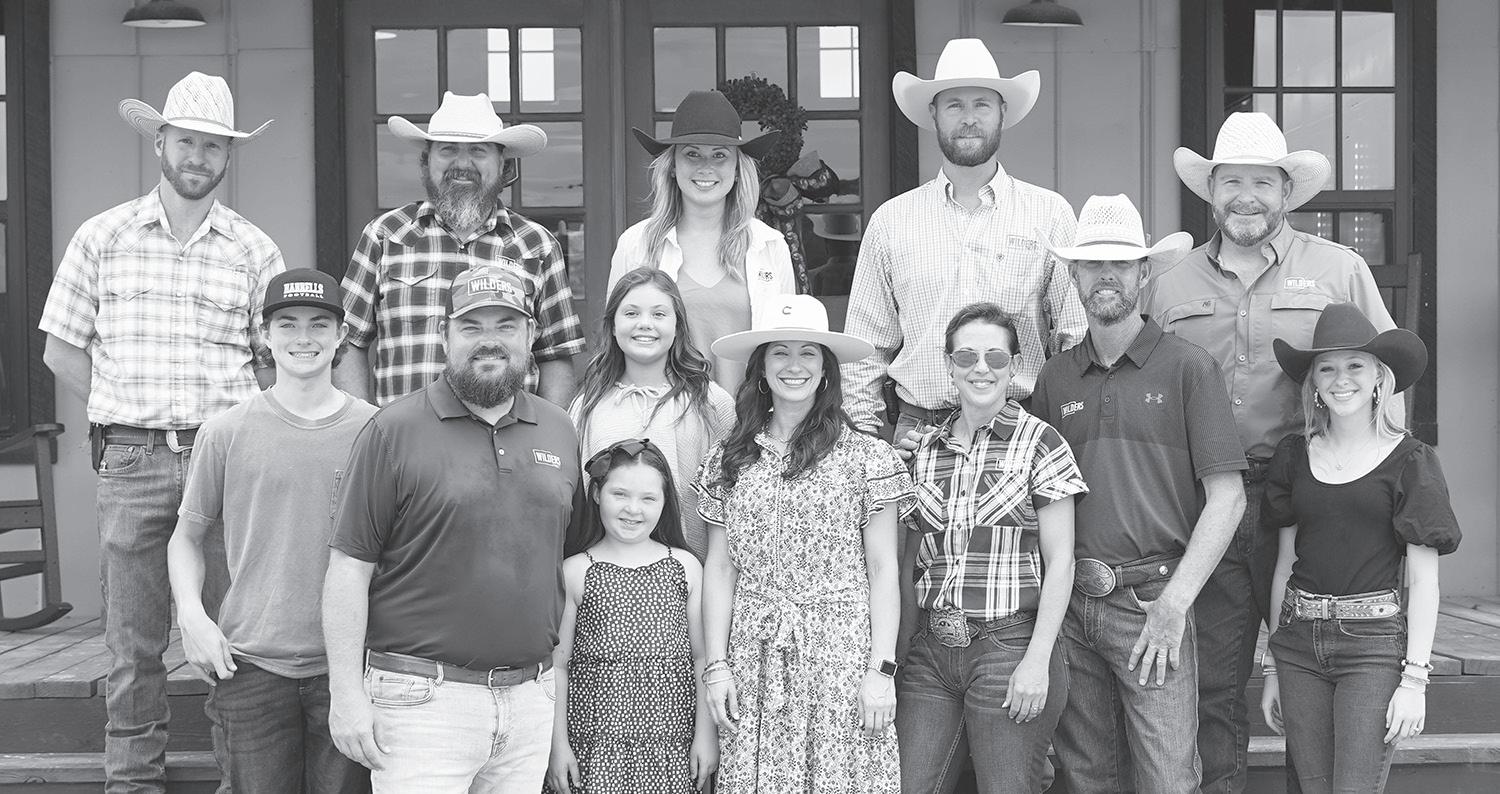


By HEATHER SMITH THOMAS
Wilders Wagyu in Sampson County, N.C., was founded by Reid and Jaclyn Smith, who originally started a business in real estate, construction, and development. The Smiths founded the RiverWILD family of brands (their real estate development company in Clayton, N.C.) nine years ago, and their new venture with Wagyu was their first agricultural business. Their mission is to build the local economy through a program that offers products people can count on.
The name “Wilders” comes from the name of the township Reid grew up in. He grew up around SimAngus cattle and developed a passion for agriculture. When the pandemic came along, he and Jaclyn wanted to find ways to get their family outside and involved in agriculture. Wagyu cattle grabbed their attention. They already had Angus cows on their small farm and added some Wagyu as they learned more about this breed and genetics.
“We fell in love with Wagyu and so did our team — the people in our company — and they all rallied around this breed,” Reid says. “A key thing with our company is that our purpose is to impact and develop people. So from the beginning, we’ve seen the farm as an opportunity to bring
as many people along for the agriculture ride as possible. This is a big part of what we try to do every day — to try to include people. We are raising cows, but to us, it’s even more important to enjoy doing it with the people we’re doing it with,” he says. It was an opportunity to introduce people to Wagyu in eastern North Carolina and also bring the best beef in the world to people in the local community.
“We opened a general store on the farm at the beginning of November 2023,” says Danielle Lantz, Vice President of Brand and Operations for Wilders Wagyu. “We timed this opening to be the same weekend as our first production sale on the farm. Our Wagyu cattle customers were therefore the first folks to come shop at our store,” she says.
“Our farm is in eastern North Carolina, in the small town of Turkey. Sampson County is the largest agricultural county in North Carolina. It is well known for hog farming and row crops, and we are one of the largest cattle operations. The farm itself was once an old cutting horse farm, built by Jeffrey Matthews. He created an awesome program and an awesome farm to house those horses. When he moved out a few years ago, we purchased the farm and


switched it from a horse to a cattle operation. There are some beautiful buildings and facilities that were already here, and we didn’t need to build much; he already had it wonderfully set up, and we didn’t need to change it very much,” Danielle says.
“He had some old tool sheds and buildings like tobacco barns and hay barns, and we renovated one of the tool sheds into a general store so we could have a beef outlet right here on the farm for consumers. It was important to us to be able to have a place where people could come shop and experience the farm. It is a beautiful place, and we wanted to be able to share this with our customers and people in our area,” she says.
“Our hope is that we can offer farm tours on Saturdays so the people who come to shop can also tour the farm. They can then see what we are doing and how we raise our cattle. We also pasture raise Berkshire hogs here on the property. Our main goal is to educate consumers and get them excited about agriculture. This is our passion and focus, in connecting to the local community by allowing people to come and see how their food is raised. They can experience North Carolina agriculture. This was the purpose behind opening the store.”
The beef program has been tremendously scaled up and is now an e-commerce Wagyu beef business. “We sell beef and pork directly to consumers through our online website at www. wilders.com , but we never had a true retail space. With the general store, we can now allow our customers to come pick up orders. We do some special in-store only
bundles and discounts to encourage people to shop in person. All of our beef is frozen, so we have several freezers in the general store; people can come shop and pick out their individual cuts,” says Danielle.
The biggest thing she noticed is that people really love to buy the bundles. “We try to offer a different bundle every other week, and our customers get excited about that. We tell them to come back again because we will be switching out the bundle, and they can come back and try something different. This is a good way to help move cuts that people might not normally buy, and we can educate them about different parts of the cow. Not everyone knows what a flat iron is, or a hanger steak or flank steak. By putting those in the bundle, it allows us to sell the entire animal and get people to try those lesser known cuts. They come back and tell us they never knew about those, but love the flat iron and want to buy one of those again separately,” she says.
“We try to keep our bundles under


$100 so they are an easy price point, allowing people to come in and try a variety of things that aren’t really expensive. This is also a great way to move ground beef. We always include some kind of ground product in the bundle as well, and this helps us move the ground beef quicker,” Danielle says.
“We are fullblood Wagyu beef producers, and we use this in all of our branding and messaging. I think the biggest hurdle for us is to educate the customers about why we are charging so much for beef compared to what they are used to. By having face-to-face interaction at the store, they can ask questions, and we can help them learn more about it and overcome those hurdles. By contrast, people buying beef online don’t get the full story or picture,” she explains.
Currently, the store is only open on Fridays and Saturdays, but during the summer, the plan is to expand the hours. The farm is in an ideal location for people to come by, between a big city area and a popular beach town. “We are right off the interstate highway that connects Raleigh and Wilmington. There is a lot of traffic, especially during the summer when people are going back and forth to the beach. This is a prime spot for people to just pull off the highway and grab something they want on their way in and out of town,” says Danielle.
“We hope to expand our hours as we go into spring and summer to help accommodate the people traveling back and forth. We also offer more than just beef and pork in our general store. We have a lot of awesome branded items with our farm name, like T-shirts and hoodies, cups and stickers, cutting boards, hats, keychains, etc., that have our logo on them for our cattle brand,” she says. It’s a place where farm meets flavor and fun.
“This all connects back to our core values as a company. That’s what WILD stands for — doing business the WILD way, which stands for our core values: with a Will to win, we Intentionally adapt while Living compassionately with Disciplined execution. We try to live by this every day, regardless of what we are doing — whether in agriculture or in our day-to-day business,” she says.
“The way we do business is basically driven by relationships. We are glad to offer a space where we can connect with our customers in a way that goes beyond just a transaction. This means a lot to us, along with being able to educate people about agriculture, and specifically Wagyu beef, since there’s a lot of misconceptions
about it.” The interaction with customers really helps.
“We just started offering some cooked products like summer sausage and snack sticks. We hope this will take off and become popular; it gives people something to instantly try, as opposed to buying a frozen steak that they can’t really try right there on the spot,” she says.
“Maybe on down the road, we might be able to offer more than just our own products in the store. We have met many great producers across the state at farmers’ markets. Being able to eventually offer some of their products in our store would be our ultimate goal. This could help connect consumers and producers,” she says.
“Our success at the store thus far is due to a great relationship with our local county extension office and our state department of agriculture. Both have helped promote our store and beef program extensively, and we are lucky to live in a state that values agriculture as much as we do,” Danielle says.
“We focus on relationships and customer experiences, which is important when you are offering a high quality product, such as locally raised, 100 percent fullblood Wagyu beef. We want people to feel like they’re buying into something that’s more than just buying meat — that they understand where it comes from and that they’re excited about the brand that we’ve built.”


By HEATHER SMITH THOMAS
Some Wagyu breeders sell bulls to commercial cattlemen to use on their cow herds, especially for their heifers for ease of calving, and utilize a buyback program to purchase all the F1 calves produced. This gives the Wagyu breeder a wider group of progeny from which to obtain performance and carcass data to evaluate various Wagyu sires and more F1 calves to feed out for beef if they are in that kind of marketing program. It gives the commercial producer a guaranteed market and premium for those calves and can be a beneficial partnership.
Colon Roberts has a large chicken farm in North Carolina and also runs cattle. “I purchased Wagyu bulls from Sakura Wagyu Farms in Ohio and they buy back my calves,” Roberts says. Sakura buys back calves from farms all over the country. The cooperator farms can retain ownership of the cattle if they wish, or Sakura buys the calves and puts them on feed.
“I’ve also sold F1 Wagyu calves to Renew Livestock, originally in Iowa but now located in Texas — but still has some feedlots in Iowa,” says Roberts. Renew Livestock markets and manages value added programs for buyers and producers — helping buyers source the livestock that fits their needs and helping producers reach their goals in producing livestock for the value added market.
“I’ve also hauled F1 cattle to some retired dairy people in Ohio to feed. Renew Livestock was hiring people who were getting out of the dairy business — to feed out their animals — because dairy people know how to feed cattle and do a good job of it. For the past two years, I’ve sold to Renew, but this year, I’ll probably go back with Sakura because I now have one of their high dollar bulls, and they want the calves. If the producer can find a Wagyu operation to work with to buy back the calves, it can be profitable for both parties. The companies I work with want me to be certified, to make sure the calves are dehorned, wormed, vaccinated, and weaned; they want everything done correctly and also prefer that you have Angus cattle to cross with,” Roberts says.
“I have 425,000 chickens and we use the litter from our chicken houses to spread over pastures, so we don’t have to buy any fertilizer.” He also feeds out a small number of fullblood Wagyu and sells meat directly to individual customers, selling it by the quarter. “Most of our customers, after they start eating Wagyu — whether the F1 or fullblood beef — they always want more!” Roberts says.
“It’s nice to be able to produce meat that everyone enjoys.” As more stockmen learn about Wagyu and the value of these calves, they might consider buying a Wagyu bull to use on their herd, or at least on heifers (for easy calving) and have more valuable calves. An easy way to do this is to enter into a buyback program with a Wagyu breeder to supply the bulls.
Jake Newbold, Director of Agriculture for Wilders Wagyu in Sampson County, North Carolina, says there are many ways to do this. Wilders Wagyu has its own program, but there are a number of other breeders — and commercial producers — in the Carolinas who do some kind of partnership.
“Sampson County and our neighboring counties have a lot of hog producers and a lot of cattle. Hog producers can put the effluent from the hog houses onto the grass pasture and it is great fertilizer,” he says.
“The potential we see, for a lot of Carolina cattlemen and other cattlemen up and down the East Coast, is the opportunity to add value to their calf crops. This is one of the main reasons we started our own buyback program at Wilders Wagyu — not only to help our fellow cattlemen but also to put more calves on the ground from our bulls. We can collect a lot of data from the bulls we sell to local cattlemen,” says Newbold.
Wilders is a beef company first, selling meat directly to customers, and genetics and seedstock second. “Our beef program is our bread and butter and also gives us the information we need to be cutting edge on the genetic side. For us to be able to get those calves back is
important because that information adds a lot of value to our program.”
Even though Wilders is a beef company, they don’t sell F1 or commercial Wagyu beef themselves. They only sell fullblood beef. “For our buyback program to work, we network with other producers who are selling F1 beef. Ultimately, it’s not a profit gaining enterprise for Wilders on the buyback. Our main purposes are to gain data, help local cattlemen, and build a bull market in our area,” says Newbold.
They were pushed into finding a market for F1 cattle early on because they have such a large recip herd. “After we get done with our embryo transferm we clean up with a fullblood Wagyu bull on our Angus based recip cows so we end up with quite a few F1 calves each year. Our main program is pasture-to-plate beef, and if these don’t go into our own beef company we have to find another market for them. Since we already had to find a market for ours, we can help other people market theirs, and find a home for those calves,” he says.
Wilders has the facilities to handle this. “If a producer needs to drop off a calf crop at our farm, we can coordinate a truckload from our facility, since we have corrals and a loading ramp.”
As more producers learn about this type of opportunity to get more money for calves, they might decide to go this route.
“There are several ways to structure a buyback program. Some people use a straight per pound or perhundredweight premium on the calves, above the Southeastern Cattlefax index number on prices. Other buyers have a different premium structure that fits their own feeding operation,” says Newbold.
“The neat thing about the various models is that they are either based on market pricing or the Cattlefax index, with the premium added to that. Maybe a neighbor really wants to do this and asks us what the price would be. I’d tell that producer that I can lock in the premium price, but I cannot predict the cattle market and tell what that price would be 18 months from now, but the producer
would still know what his premium would be, over the market.” This can be a comfort to know the calves would be worth a little more.
“Here in the Carolinas, it’s tough for smaller producers to market calves if they don’t have a full truckload. Unless you are selling a truckload, you rarely get top market price. This is why we help people combine their calves and put truckloads together. Even if it isn’t accomplished by putting theirs with our own calves here at the farm, we can still get it done within our network.” This can really help producers market their calves effectively with the best prices — plus the buyback premium on top of that.
A Wagyu bull is a great option for breeding heifers. Wagyu calves are generally smaller at birth than other breeds, and many producers like to run Wagyu bulls on their heifers for calving ease. More producers are doing this to save labor and not have to pull calves and enable the heifers to recover faster and breed back.
This is a great option, especially when there’s a good market for the F1 calves from those heifers. The premium for being half Wagyu can make up for the calves being a little smaller since heifers’ calves tend to be smaller than calves from older cows.
The demand for Wagyu and Wagyu influenced beef is extremely high. Fullblood registered Wagyu producers cannot meet the demand, and the F1 market helps with that, but there’s still not enough supply. “Fullblood Wagyu producers need the commercial Wagyu producers to strengthen bulls markets, and the commercial Wagyu producer needs the fullblood producer so he can source bulls,” says Newbold. There is plenty of market for everyone because of the wide spectrum of what customers want, and having a market for F1 calves is very important so more producers will buy Wagyu bulls.
The F1 calf from a first calf heifer weans a little lighter than the average beef calf, but these F1s do catch up. “We backgrounded some for 60 days and they
just exploded with growth; you can put a lot of weight on them quickly,” says Newbold. This is another reason people can offer a premium on these calves on a buyback program. It makes it worth doing for producers who want to breed their heifers to Wagyu bulls.
If commercial producers buy a bull, they have more invested in this enterprise and are more committed, and this can actually make a stronger relationship. “This is one reason we’ve stuck with
doing that, rather than leasing,” he says.
“Our philosophy is simple: when you are a Wilders Wagyu customer, you do not have to do it alone. We will do everything in our power to help any of our customers be successful. This makes for great relationships,” says Newbold.
“We often talk about the ‘what’ and the ‘why’ in our business. Wagyu is ‘what’ we do, but it’s not ‘why’ we do it. The people and relationships we form are ‘why’ we do it,” he says.
Commercial cattlemen all around the country are now discovering the advantages of using Wagyu bulls in their herds, especially for heifers. Jerry Reeves, Ph.D. (retired from Washington State University), raises Wagyu on his ranches in Washington and Idaho (Bar R Cattle Company and BR2 Wagyu Genetics). “We have fullblood and percentage cattle but run them like commercial cattle,” he says. He sells and leases bulls to commercial cattlemen.
“Several large ranches in the Western U.S. are using Wagyu in their programs, breeding heifers to Wagyu bulls for ease of calving, and receiving a premium on the calves, from companies like AgriBeef, Masami Foods, A-Z Feeders, JDH, Premium Beef, and other Wagyu feeders and marketers. The half blood Wagyu calves are in high demand,” says Reeves.
Some of these programs, like AgriBeef, sell or lease bulls to cooperating producers in order to have a good supply of F1 calves to feed out and market the meat.
Wade Small, President of the Livestock Division of Agri-Beef, says their Snake River Farms program started in the mid-1990s after purchasing Wagyu genetics.
“It took a while to get the feeding lined out and figure out the best way to feed and manage them. Our feeding program slowly grew over time. It’s been a good program for people who breed a lot of heifers. This has been our main focus for commercial cow/calf producers with good Angus or English based cow herds who are looking for a solution for heifers,” says Small. The Wagyu provides ease of calving, plus a very marketable calf.
“This has worked well for commercial producers because they don’t have to try to select and manage heifer bulls. It simplifies a lot of things. We have a lot of long term relationships now, including producers who have been sending us calves for more than 20 years. This program continues to grow, and pricing is very transparent; we base our price off an index plus an agreed upon premium. Everyone knows how the cattle are sold, where they are going, and how they will be priced,” says Small.
This makes things simpler for many ranchers, especially for calving. “They don’t have to keep heifers confined during
calving, to check them so closely, so this reduces input in feed and labor. We also work with producers to set up vaccination programs to help on their end and our end of the management. Typically, the health is excellent on the Wagyu cross calves from the producers we work with,” he says.
The goal is to build long term relationships. “As we make plans on what we will be breeding (in terms of numbers in our program) and anticipate what our beef demand will be four years down the road, we send bulls to some of the ranchers. It’s 9-10 months later that they get their heifers calved out, another six months before those calves come to us, and another 550 days before we ship those finished cattle. So you are looking a long way out in the future to try to predict where you want to be,” he explains.
“We look for long term producers because we want this to be a consistent product year after year. We value the relationships we have with the ranchers we do business with. Everyone works together. Our goal is to make sure our genetics work better for them, year after year, and for us,” says Small.
Chase Hibbard of Sieben Livestock Company in central Montana has been using Wagyu bulls for more than 20 years and is pleased with this crossbreeding program for first calf heifers. “Our use of Wagyu genetics came about through acquaintance with Dr. Jerry Reeves and his partner at that time, Gerry Pittenger,” Chase explains.
“It made sense to breed heifers to bulls that would produce a smaller calf — which is easier on the heifer. You have all the benefits of a smaller calf which include easy birth and fewer calving problems (less work during calving season), less recovery time for the heifer, etc. The hybrid vigor of the calf is also a plus,” he says.
The calves are contracted before they are born. “We dealt with Jerry for a long time, selling our calves to him. Now we work with Agri-Beef at Snake River Farms. It works well, with the premium, and raising them is very profitable.”
As the Wagyu industry evolves, there will be more opportunities for people who want to become a part of this — either producing the genetics or purchasing them for use in commercial herds in buyback programs that guarantee a premium for those calves.
By HEATHER SMITH THOMAS
Wagyu cattle are quickly gaining a reputation for producing the ultimate eating experience for folks who like beef. The good news is that Wagyu beef is also a very healthy food. Dr. Quentin Emerson has a farm near Owensville, Ind., and became interested in Wagyu cattle about 16 years ago and started a Wagyu breeding program. “I always liked a good steak, and then discovered that Wagyu meat is also good for you because it contains unsaturated fat, the healthy fat. It actually helps a person lower bad cholesterol. It’s also high in omega 3 fatty acids. This makes sense medically. The medical journals tell you not to eat red meat because it’s unhealthy, and that’s just not true,” he says. As a doctor, he is now promoting healthy meat.
Most Wagyu breeders know the healthy aspects of the meat they are producing and are trying to help spread this good news. Les and Cindy Slatter and their three sons own Clearwater Ridge Wagyu in Washington State. One of Cindy’s goals is educating people about the health benefits and advantages of Wagyu meat. She says, “100 percent fullblood Wagyu beef contains higher concentrations of MUFA’s (mono unsaturated fatty acids) and oleic acid — which is an omega 9 fatty acid.”
“It contains more than wild caught salmon. The marbling in Wagyu beef is also rich in omega 3 and omega 6 fatty acids which are essential fatty acids that our bodies cannot produce, and have these in proper balance —
which can lower the risk for cancer, Alzheimer’s, cardiovascular disease and other unhealthy conditions. I am a cancer survivor and have become much more conscious of healthy, natural foods; these are very important to me,” Cindy says.
Clydene and Gary Bultman are enjoying the peaceful beauty of the mountains and pastures on their ranch in northwestern Montana after being involved with big cities and a fast paced life. Clydene is a Stage 4 cancer survivor. After being diagnosed in 2009, she went to battle using traditional Western techniques and Eastern medicine, utilizing diet and lifestyle philosophy. “When you try and balance the two medical philosophies, it is very interesting. My Eastern doctor was adamant that breast cancer occurrences are much higher in affluent areas. He called it ‘the rich woman’s diet’ because of the increased quantities of bad fats in our diets. This was a huge wake up call for me, and I realized that we have a real opportunity in meat production to make an impact in a very healthy way. I think it is extremely important for everyone to know the source of their food and get to know the rancher, the farmer, the fisherman – they play an important part in your life and your health.”
Wagyu beef, if raised properly, is high in good fatty acids. Clydene knew Wagyu was healthier than some other kinds of meat and started focusing on making their Wagyu even healthier by taking control of the entire process —
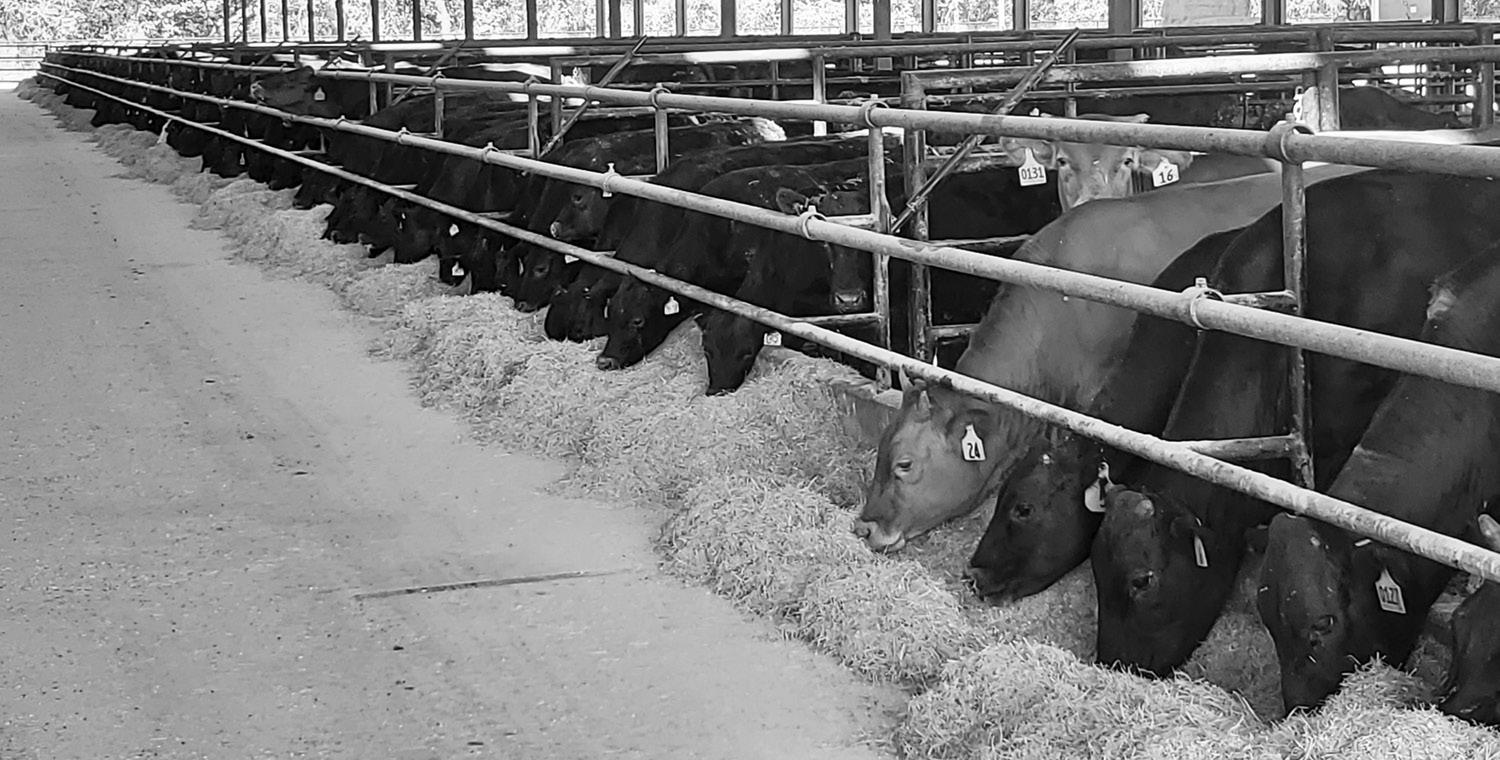
raising and feeding them from start to finish — and testing the fat profiles.
“It takes 26-36 months for these cattle to reach maturity for slaughter (almost twice as long as other beef cattle in the U.S.), partly because of the meticulous and careful combination of grain and grass. We see a huge swing in the fatty acid profile of beef by what they eat and how long they are fed. We’ve done quite a few studies with different feed programs, and I’m delighted that the AWA has decided to launch an official fatty acid profile research project. This is an area with a lot of potential to differentiate the breed, and it needs to be done in a scientific way to be credible. I believe people will be pleasantly surprised with the results,” says Clydene.
The Bultman’s feed program is focused on maximizing two things — fine marbling and a healthy fatty acid profile. “We perform a fatty acid profile at each slaughter, on the highest grade and the lowest graded animals. We try to hit a mid-range of marbling, combined with a healthy fat profile. We don’t think the U.S. palette and diet necessarily favor the ultra high marbled product like they have in Japan. We’ve been backing off on the quantity of conventional grains to create a healthier product. We are looking for a great tasting and very healthy end product — the best of both worlds.”
Bob Estrin, Lone Mountain Ranch near Golden, N.M., has always been focused on herd performance and carcass evaluation, but another passion has been to educate people about the health benefits of this highly marbled beef. “I was introduced to the concept of fat being good for one’s health; this was dealt with at length in a book called Good Calories, Bad Calories by Gary Taubes. He then wrote another book titled Why We Get Fat and What To Do About It. Gary introduced me to Peter Attia, a physician who is now devoting his life work to nutrition,” Bob said.
Peter Attia is a Canadian-American physician well known for his expertise in researching life extension and enhancing people’s overall health. After graduating in 2001 from the Stanford University
School of Medicine, he specialized in Surgical oncology at the Johns Hopkins Hospital in Baltimore, Md., and did research at the NIH (National Institute of Health) in Bethesda, Maryland. He focused on melanoma treatments based on harnessing the power of the immune system. Later, he founded a private clinic dedicated to extending life expectancy and enhancing general health.
In 2012, Dr. Attia co-founded the Nutrition Science Initiative with Gary Taubes, with a primary focus on promoting research in nutrition and tackling the growing health challenges linked to obesity, diabetes, and metabolic diseases. In 2013, Attia was one of the speakers at TEDMED, where he shared insights on longevity. In March 2023, he published his book Outlive: The Science & Art of Longevity (with Bill Gifford), which was a runaway best seller.
“Peter gave a wonderful TED Talk a few years ago about the currently held belief that fat is evil,” Bob Estrin said. “Nina Teicholz, another investigative journalist, has written a marvelous
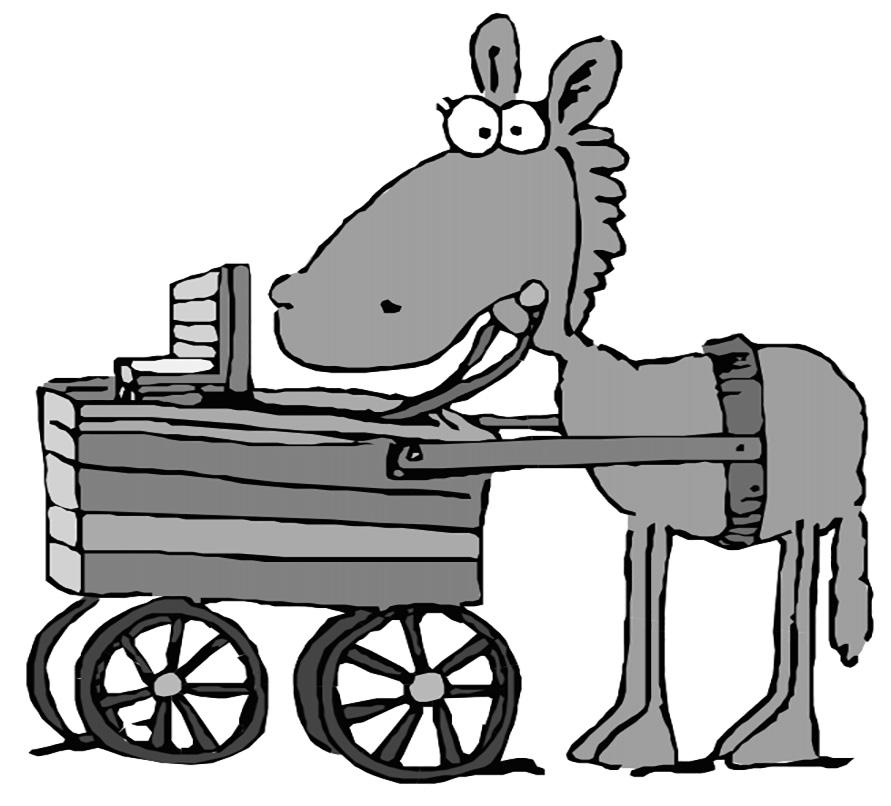
Don’t put your cart before your horse...advertise that sale ahead of time! You’ll see positive results.
book documenting how we’ve all been programmed to think of fat as evil, that everything we think we know about dietary fat is wrong. This has been a problem for Wagyu producers who are trying to sell highly marbled beef because of the widely held notion of fat being unhealthy — even though it is a very important part of our diet,” said Estrin. The plus side is that Wagyu beef is rich in healthy fats.

“In our Wagyu program, we always test one carcass at each harvest, to see what the fatty acid profile is. We find that 55-60 percent of the beef is monounsaturated fat, the same kind of fat in olive oil and salmon. In three years of testing, we found that Lone Mountain Fullblood Wagyu, in comparison to wild caught salmon, has almost ten times as much monounsaturated Fat and ten times as much oleic acid (omega 9 fatty acid). We made a chart for infographics and pamphlets we generated, showing this comparison. We verified these findings with our nutritional consultant, Dr. Jimmy Horner.”
Dr. Horner, a ruminant nutritionist who founded Protocol Naturals in Bridgeport, Tex., has been researching the health benefits of Wagyu beef for several decades. He is one of the foremost nutrition consultants for producers who raise Wagyu. “Our company has been collecting data on fatty acid profiles in the beef of some of our customers for more than ten years — having carcasses analyzed for fatty acid composition,” he says.
“Research on this has also been done
elsewhere, especially in Japan, Korea, and Vietnam, as well as Texas A&M and other universities around the country. It is obvious that Wagyu have a superior fatty acid profile, compared to any other beef breed. There is a genetic component, with the SCD (Stearoyl CA Desaturase) gene being expressed at a higher intensity and duration in Wagyu, and this is the gene responsible for converting saturated fat to monounsaturated fat,” he explains.
“We, and several of our clients, have also compared Wagyu beef to other beef, such as Certified Angus Beef (CAB), commercial beef at the grocery store, etc. Wagyu has a better fatty acid profile. If you look at the monounsaturated fatty acids versus saturated fatty acid ratio, Wagyu is about 3 times higher than any other beef. Data from Washington State University, Texas A&M, Penn State, and some of our clients’ data, looking at the amount of cholesterol in Wagyu beef, show there is also a very favorable aspect, even compared to salmon, chicken, turkey, bison, etc. — the meat sources people feel are lowest in cholesterol.”
The oleic acid (omega 9) content, considered a good fatty acid, is higher in Wagyu than in other breeds. “Often, it will be as high as 50 percent or more in fullblood Wagyu. There have been studies that show oleic acid reduces coronary heart disease. A few studies showed it had no impact, but even that is a positive. This beef can benefit heart patients. If you want to consider just one component, oleic acid is a good one to focus on because it is the one fatty acid most correlated with health, in a positive way,” Horner says.
“It also has the highest correlation with the good taste and smell of meat. We need to be touting this in Wagyu beef, and looking at ways to get higher levels, even though it is already higher than in any other beef. We know it is heritable, so if people start collecting fatty acid data on carcasses, they could start selecting cattle with the highest oleic acid,” he says.
“We can certainly make the claim that Wagyu meat is healthier and tastes better. The Japanese have what they call the Go-Go 55 Program they launched several years ago that awards producers who have more than 55 percent oleic acid in their beef. They get a premium for the meat, because the Japanese have identified the fact that oleic acid is very
important for health and flavor,” he says.
People in the U.S. are becoming more health conscious. “We need to get the word out about this beef. The naysayers will say that even though Wagyu has a better fatty acid profile and less cholesterol, it has so much fat that how can we say it’s healthy?” Many people still have a phobia about fat because we were taught for so long that it’s not healthy.
“Even the saturated fat in Wagyu is higher in stearic acid, which has also been shown to have a beneficial effect on cholesterol and fatty acid. Even though Wagyu does have some saturated fat, it is still a healthier saturated fat because of its fatty acid profile. People don’t realize this,” he says.
Humans always need some fat in their diet, but for more than half a century, we’ve been told that it is not healthy. “A lot of the folks who early on recommended cutting out fat in the diet now have egg on their face because that early data didn’t pan out. Fat is important, but like anything else, it’s best to eat in moderation. None of us need a 12-15 ounce Wagyu steak! In Japan, typically 4-8 ounces is the most a person would eat at a restaurant. Anything we eat should be in moderation, but there is no question that Wagyu is the healthiest beef and even healthier than other meat choices like poultry or fish. This fat is totally different, and when consumed in moderation, it is very good for us.
“We have the most flavorful beef, but also the healthiest. We will be collecting more data as time goes on, and continue looking at ways to improve the fatty acid profile even more, but we already have a substantial amount of data that we are not utilizing enough, to show people what we have. We need to get the word out,
especially to the media and some of the medical community,” says Horner.
“Many folks already realize this beef tastes better, but we need to do a better job of touting health benefits. We will be doing research here at our farm, looking at another feed additive that can hopefully directly impact fatty acid profile and elevate oleic acid content in Wagyu beef above and beyond what it is already,” he says.
Many breeders keep looking for an advantage, an edge over the competition, and this is a way to do it. “We know that the way we feed these animals can influence marbling — not just more marbling but also finer marbling. We’ve learned that farther out in the feeding phase the marbling doesn’t stop; toward the end it starts to differentiate and proliferate. The fat globules start breaking up into finer particles. There is also a correlation with higher oleic acid content. The longer these cattle are on feed, on a high energy diet, this can impact the final product. There are other ways we can beneficially impact this, too, so we are constantly looking at these possibilities.”
The good news is that more people know about Wagyu now, compared to ten years ago, and more people have tried the meat. “We just need to do a better job of advocating the health benefits. We know there is a genetic component and a nutritional component, and we are doing a better job identifying bulls for various traits like marbling, growth, feed efficiency, etc. We also need to take a closer look at fatty acid profile — especially the monounsaturated fats and oleic acid. The breeders who commit to selecting for this will be ahead of the pack; I think this could very well be the most important component in the product we are selling,” he says.

By ASHLEY W. HERRING Director of Consumer Information N.C. Cattlemen’s Beef Council
This year, the Beef. It’s What’s For Dinner. brand, funded by the Beef Checkoff, is excited to announce the perfect partnership between beef and baseball/softball as a proud partner of the Little League World Series.
A favorite at the ballpark and at home, beef makes dinner easy. As the official sponsor of the Perfect Home Plate with Little League, the Beef. It’s What’s For Dinner. brand will make mealtime even easier with delicious, balanced recipe inspiration, perfect for the busy sports family navigating a hectic schedule.
Beef at dinner time is always a home run on taste, but that’s not enough when fueling a young athlete. Nutrition is key to supporting growth and development, and beef’s unmatched nutrition package


What’s for Dinner website. From 1986 until now, the Beef Checkoff has led the creation of the brand BIWFD and helped in growing the brand equity.
covers all bases with high quality protein and ten essential nutrients. The partnership with Little League will help busy families keep their young athletes fueled from the classroom to the practice field and all the way through game day with nutritional information and recipes.
I’ve enjoyed visiting groups to speak about the Beef Checkoff and how beef is promoted. Duplin County invited me to their first fall meeting after summer break, and we visited about the history of the Beef Checkoff’s advertising campaigns in a video you can find on YouTube called The Beef Checkoff – 35 Years. It goes through the early beginnings of the Cattlemen’s Beef Board and how producers direct the programs.
The wrap-up is the current social media and engagement on the Beef. It’s
Also on the schedule was a visit to N.C. State University’s Animal Science Club. The club is actively involved both on and off campus with livestock events. They manage the milking booth at the upcoming N.C. State Fair. This year’s booth will be different; a photo booth will be in place.
The Animal Science Club is eager to learn about the cattle industry in our state, as well as the role the Beef Checkoff has played in promoting beef. We discussed our favorite cuts of beef as well as how the Beef Checkoff has marketed our product to consumers over the years. It’s encouraging to see interest from young adults in the field of agriculture and how our organizations collaborate.
Summer may be winding down, but we’re entering peak grilling season because the weather is finally turning cooler and losing humidity. It’s pleasant

to be outdoors and use the grill to prepare meals with friends and family. We’re also pulling out slow cookers that save time and utilize a variety of cuts to create a memorable meal with fewer steps.
The Mountain State Fair beef cooking contest “Classic Comfort Food” showcased amazing original recipes from home chefs. This year’s winners and recipes are:
1st Place – Bronwyn Blenn
Sandy Mush Beef Cottage Pie
4 lb beef shoulder arm roast
1 au jus packet
1 ranch dressing packet
5 medium carrots (sliced)
2 small onions (chopped)
½ cup baby peas
6 medium russet potatoes
¼ cup evaporated milk
¾ package cream cheese
½ cup sour cream
¼ cup flour
1 cup chicken broth
1 cup butter
1 cup water
Garlic salt, salt, and pepper (to taste)
Combine beef, au jus, and ranch packets, then add water. Put in a crock pot and cook until the roast is falling apart.
Remove the contents from the pot, except for the gravy. Add broth, flour, and water to thicken, then set aside.
Sauté the carrots and onions with butter in a sauce pan until soft and caramelized. Add the baby peas and set aside.
To make the potato topping, dice the potatoes, put them in water, and boil until done. Drain the potatoes, then add cream cheese, sour cream, butter, evaporated milk, salt, and pepper. Whip with a blender.
Slice the beef into bite size pieces. Combine the beef, vegetables, and gravy mix in a baking dish. Top with the whipped potatoes.
Bake at 350ºF for 20–30 minutes until bubbling hot.
Makes 8–10 servings.

2nd Place – Sharon Gates
Game Day Cheeseburger Braid
1½ lbs ground beef chuck
½ cup onion (minced)
1 tsp garlic powder
½ tsp salt
½ tsp black pepper
2 Tbsp yellow mustard
3 Tbsp ketchup
½ cup dill pickle slices (minced)
1 large sheet prepared puff pastry (room temperature)
4–5 slices of cheese (cheddar or pepper jack)
1 egg, beaten, mixed with 1 tsp water
1 tsp sesame seeds (optional)
In a large skillet over medium high heat, cook ground chuck and onion until beef is cooked through and onion is softened, 5–7 minutes. Stir in spices, mustard, ketchup, and chopped pickles.
Preheat the oven to 400ºF. Roll out puff pastry on baking parchment, and using a pizza cutter or sharp knife, cut slits 1” wide along the longer sides ⅓ of the way down each longest side. Add cheese slices down the center third of the pastry, and spoon the beef mixture on top of the cheese. If desired, add extra cheese on top as well.
Starting at one end of the pastry, alternate bringing pieces of the pastry across your cheeseburger mixture to form a braid. Once everything is covered, use your beaten egg and water mixture and a pastry brush to coat the braid with egg wash. Sprinkle with sesame seeds, if using.
Bake for 20–25 minutes, until golden brown. Slice and serve to hungry football fans or your family. Makes 6–8 servings.
3rd Place – Justin Pegg Stuffed Meatloaf Cupcakes
1½ lbs ground beef
½ cup Italian breadcrumbs
1½ tsp Worcestershire sauce
1 clove garlic (minced)
1 tsp salt
1 small container of premade mashed potatoes
(can be substituted for homemade)
½ block pepper jack cheese (cut into 1” blocks)
2 eggs
½ cup beef stock
½ small onion (diced)
½ yellow bell pepper (shredded)
1 small jalapeño pepper (shredded)
3 Tbsp chives (chopped)
Topping
½ cup ketchup
2 Tbsp brown sugar
½ cup BBQ sauce
Cupcake liners
Preheat the oven to 375ºF and grease a muffin pan. In a large bowl, combine the ground beef, breadcrumbs, beef stock, onion, jalapeño pepper, bell pepper, Italian seasoning, Worcestershire sauce, garlic, salt, pepper, and eggs until all ingredients are well combined. Let it rest for 5 minutes.
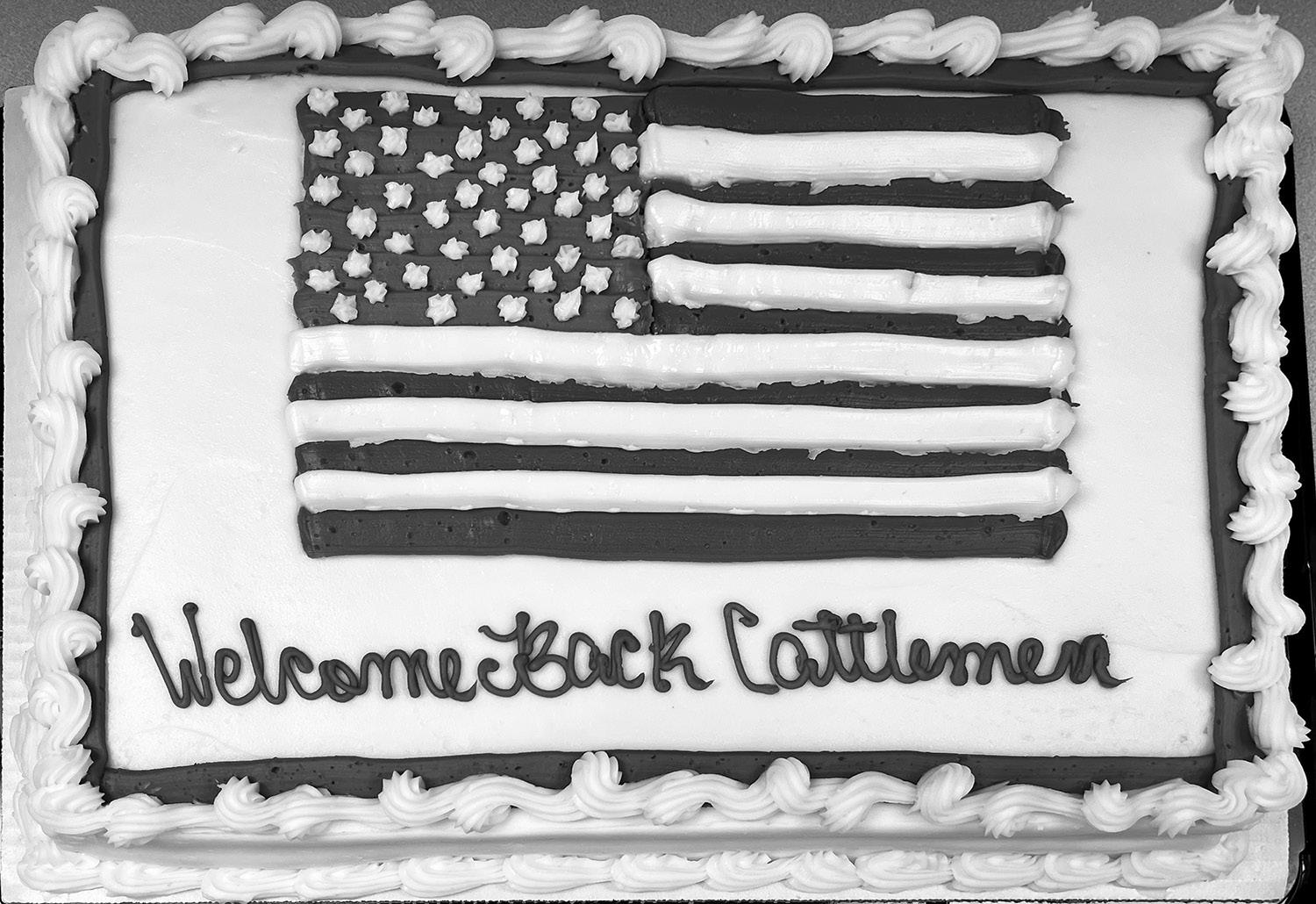
Divide evenly into the muffin pan. Insert 1 piece of pepper jack cheese into the middle of each meatloaf and ensure it is covered.
Mix BBQ sauce, ketchup, and brown sugar until well combined. Spoon some of the topping onto the top of each muffin.
Bake for 20–25 minutes until the thermometer reaches 160ºF.
While it is baking, heat the mashed potatoes according to the package instructions.
When the muffins are done cooking, remove them and allow them to rest for 10 minutes. Remove from pan and place into cupcake liners. Use mashed potatoes as icing, sprinkle the tops of each muffin with chives, and serve hot.


Most of the breed associations in North and South Carolina have stepped forward and renewed their contracts for Spotlight sections in The Carolina Cattle Connection for 2024. If your breed is not featured as a Spotlight section and you would like to inquire on any open months please feel free to contact me. Below is the tentative schedule for the upcoming year.
JANUARY CHAROLAIS FEBRUARY FORAGES MARCH ANGUS APRIL PIEDMONTESE MAY BRAHMAN JUNE HEREFORD JULY GELBVIEH
AUGUST SIMMENTAL SEPTEMBER SANTA GERTRUDIS OCTOBER WAGYU NOVEMBER BRANGUS DECEMBER RED ANGUS
For more information about your breed’s Spotlight Issue, contact: The Carolina Cattle Connection 2228 N. Main Street • Fuquay-Varina, NC 27526 919-552-9111 • mail@nccattle.com
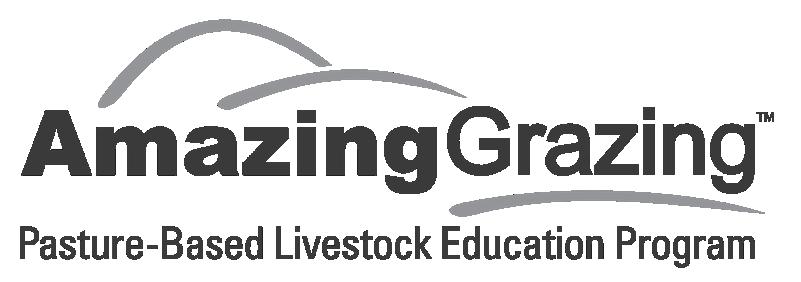
By DR. MATT POORE N.C. State University
Dallisgrass ( Paspalum dilatatum ) is a high quality summer forage that is naturalized across the Southern and MidAtlantic regions of the United States. It is becoming more widespread across the region because of its broad adaptation, its ability to withstand short grazing, and its ability to compete with other forages during the summer.
Few people have planted dallisgrass, but it is a prolific seeder that has primarily spread naturally. It mixes well with tall fescue and clovers, resulting in pastures that give both cool and warm season grazing. Producers blessed with natural stands of dallisgrass have learned to favor the growth of dallisgrass on some fields by fertilizing with nitrogen in early summer and to favor the growth of fescue on other fields by fertilizing in the fall and/or early spring. It is probably also important to let dallisgrass make a seed crop every several years to maintain stands long term.
Dallisgrass has a unique role in many forage systems. Its most important attributes are that it produces a lot of high quality summer grazing, and dilutes the cow’s intake of our endophyte infected fescue. It is adapted to a wide range of soils, and it is especially well adapted to

heavy soils. The one disadvantage is that in late summer it can cause a condition called dallisgrass poisoning or Dallisgrass Staggers. It is common for farmers to hate dallisgrass due to the potential for this problem. However, managers with dallisgrass can learn to prevent this problem and still use this very productive grass as part of their system.
Dallisgrass Poisoning (also known as Dallisgrass Staggers) occurs several days after cattle ingest a significant amount of dallisgrass seedheads infected with an “ergotlike” fungus called Claviceps paspali . The seedheads are typically infected with the fungus in late summer and early fall, as the seedheads age. Rather than flat ear drop shaped seeds on the heads, the infected heads have gray to black swellings that have a sticky sap material on them. Some observers say it looks like little popcorn (see photos of normal and infected seedheads). Sometimes the heads may be orange or red colored. Usually, not all the herd is affected, and it appears that it occurs when some animals develop a preference for the tips of the seedheads. This problem can also occur in horses and, presumably, any other mammal that might consume the infected seedheads.
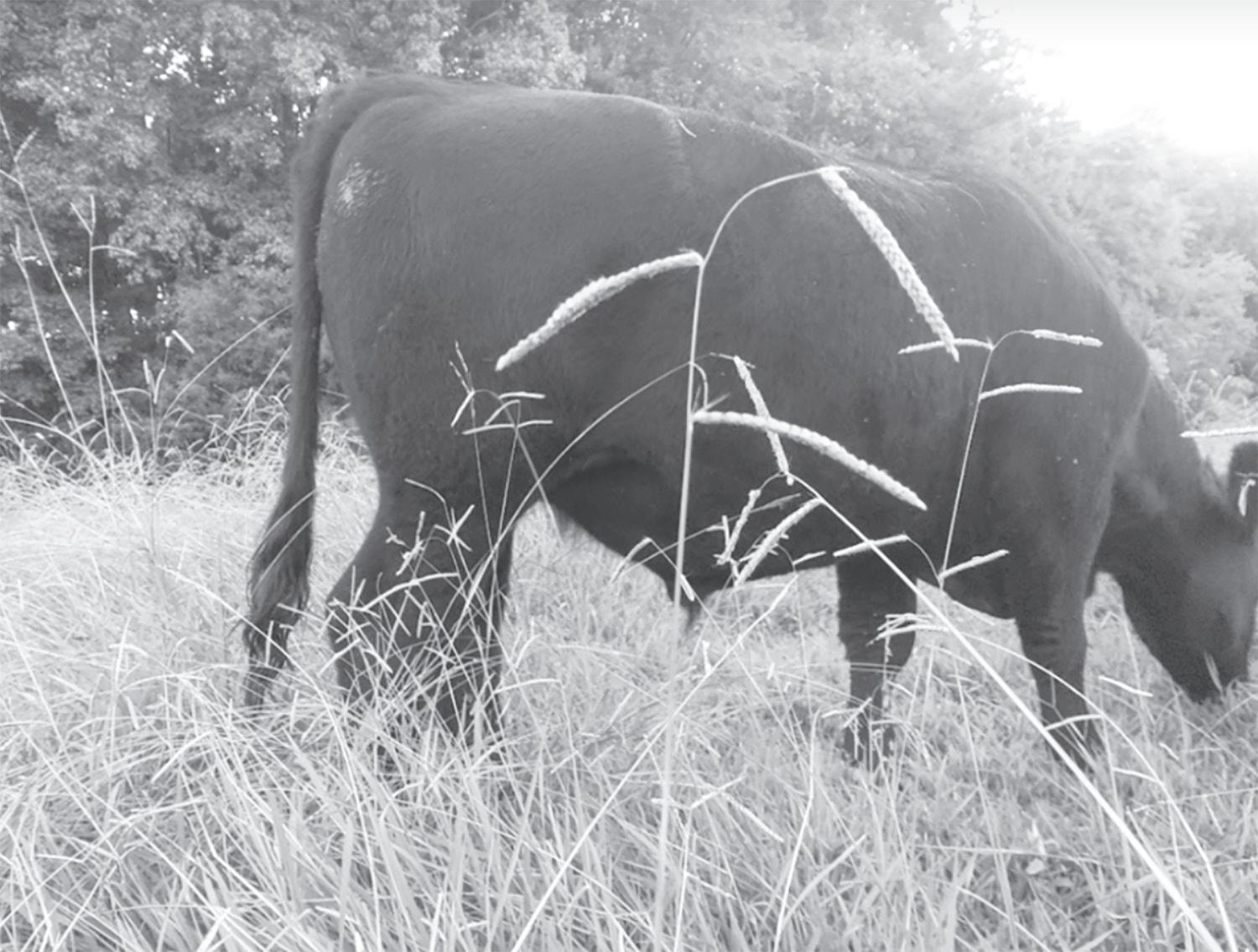
The infected seedheads contain three primary toxins — paspalinine, paspalitrem A, and paspalitrem B, which are alkaloids that cause muscle tremors (tremorgens). The affected animals show neurological symptoms, including trembling of the major muscles and jerky, uncoordinated movements. Affected animals may be spooky and sometimes (rarely) aggressive. The animals will startle and run, and they will often fall in unusual positions. In bad cases, the animals will go down and may stay down for several days. The symptoms are somewhat like grass tetany, but cattle don’t show the sudden death characteristic of grass tetany and don’t immediately respond to treatment for grass tetany.
There is no treatment for Dallisgrass Staggers except to get the cattle off the affected grass and to provide them with high quality forage. If possible, they should be put in a field with no ponds, steep slopes, creeks, etc., as they commonly stumble around and may end

up injuring or drowning themselves. Usually, cattle completely recover from the poisoning.
In late summer and early fall, we often have reports of dallisgrass poisoning, and it seems to be getting more common now because there is more dallisgrass in pastures in North Carolina. Toxicity is usually reported on farms with rank, aged dallisgrass seedheads and the fungus visibly present. In many cases, producers had stayed off the pastures, hoping to let the grass get a little more growth on it, and as a result, the seedheads got old. In other cases, there are only a few cattle in large pastures, so the dallisgrass grew faster than the cattle could consume it, and eventually, they started eating seedheads. Rarely do we get a report of a case where there were deaths of the affected cattle.
If you have dallisgrass on your farm, you should learn to identify the fungus infected seedheads and then scout your pastures for them starting in midsummer. This is especially important when moving into a new field or when fields are lightly stocked. Early in the infection process, the seedheads develop “honeydew” that will be apparent on your pants when you walk through the stand. After the honeydew stage, the fungal bodies will develop over the next several weeks in place of normal seeds.
If the seedheads do become infected, clip them off at about 12” before grazing. This generally eliminates the problem. Hay with high amounts of seedheads can also be a problem, so feeding dallisgrass hay along with other hay is advised, especially if infected seedheads are present.
For more information concerning Dallisgrass Poisoning contact your extension agent or veterinarian.
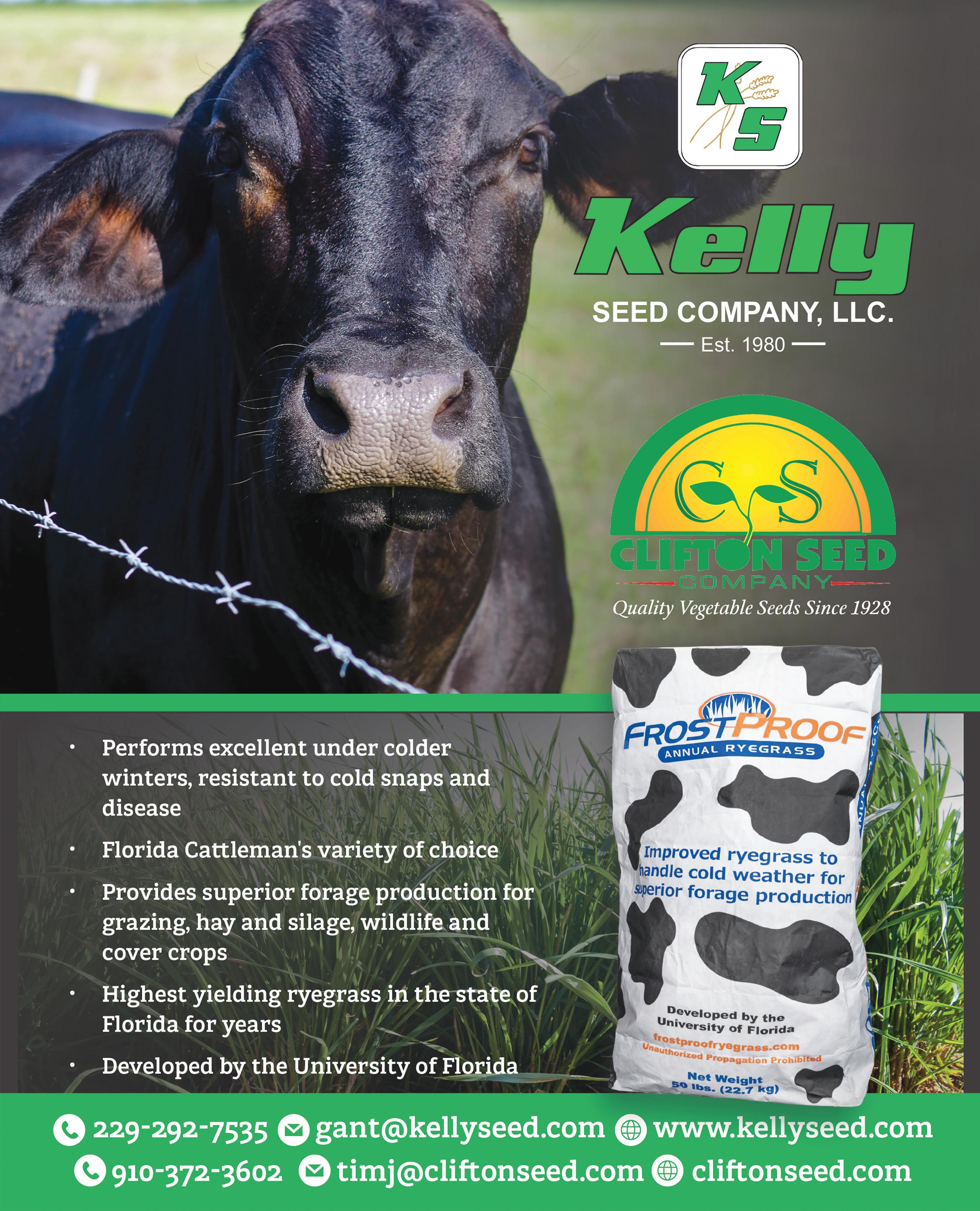


By E.B. HARRIS
Shane and his family had left on Sunday for the beach, and Anne and her sister left, going down on Wednesday. Usually, the last thing Anne will say to me is, “Don’t stay out late,” and her sister even said the same thing as they were leaving because they know I have been known to stay out around the farm too late.

Some of those times when I am out late, I like running the skid steer with the mulching head on it. First thing you know, the sun has set, and then it’s dark. On Wednesday evening, I was running this machine at the place we call the Longbranch. Some of you who went to NCSU might know what was called the Longbranch as a nightclub in Raleigh.
This Longbranch where I was working is a small creek in Warren County. It heads up to where we have the cow pasture sale and runs several miles before dumping into Fishing Creek.
I call it a little bit more than a branch. I call it a small creek. In my opinion, a branch is usually a place you can step across or jump across. With a creek, you very seldom find a spot to get across without getting wet.
I was down there running the mulcher head, and I came up on a little slough that feeds into the Longbranch. I looked at it and thought I could make it through. It was probably four to five feet wide. The mulching head is on a skid steer with tracks. I don’t know how many of you have run one with tracks, but it’s the next thing to walking on water. They will go where a wheeled machine won’t.
I made it through the first slough, and probably about five to six yards away was the second little slough. I could see
daylight out on the other side of that slough, where I wanted to come out on an area that I had already mulched, which was probably 20 yards away.
I tried the second slough, but it was not going to let me through. I took the head, pushed it down, and worked my way backwards out of that slough. I thought since I had come through this one, I would be able to come through the other slough. So I backed to the first slough and was not paying good attention and backed up on a little sapling tree right on the edge of that slough, about the size of a coffee can. I could not go forward or backward, so I was stuck.
I could not put the mulcher head down to get out of the door of the cab. Every time I went to put it down, it would not give me enough clearance to get out. There was nothing to do but push the head up and push the lock button to lock it, then leave it overnight.
I just left it and planned to get back

All forage based cattle • Fall and winter calving • All cattle EID
This is a sale with a readily available guarantee service year after year. Longest continuing commercial sale in the country and it continues. Buyer has option to sell first year offspring back to E.B. and Shane with a $50 premium on heifers and a $25 premium on steers.
• 20 First Calf Heifers with October Calf at Side - Angus, BWF, Simmental X, and Santa Gertrudis - all bred to Angus CE bulls
• 40 Fall & Winter Calving Angus Based Bred Heifers - all bred to Angus or Wagyu bulls
• 37 ‘17 Model Proven Commercial Matrons Coming with 6th Calf
- consists of Angus, Angus X, Red Angus, Simmental X, Santa Gertrudis X, and Profit or Prestige
- the highest percentage body weight weaned for percentage of cow weight that we own - all bred to Angus bulls
* All mature cows and heifers to start calving the week after the sale *
• 2 11-Month-Old Purebred Angus Bulls
• 2 4-5½-Month-Old Jacks
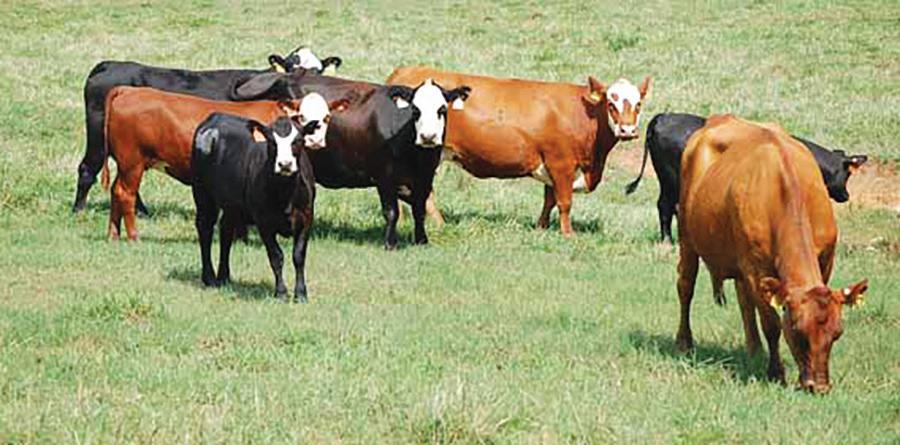


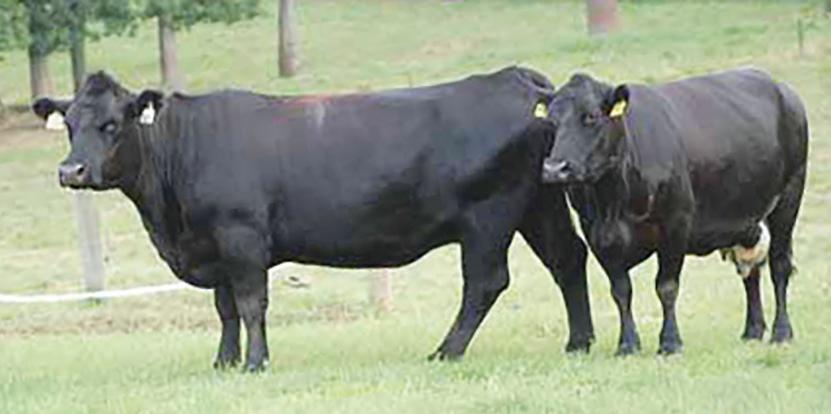


The sale will be held at the Granville Livestock Arena 4200 Cannady Mill Rd • Oxford, N.C.
Directions: From I-85, take Exit 204, go south on Hwy. 96 for 1.1 mile, turn left on Fairport Rd., go 2.4 miles, right on Cannady Mill Rd., sale ¼ mile on left at Granville County Livestock Arena. Also from jct. of Hwy. 96 & 56 at Wilton, take Hwy. 96 north 2 miles, turn right on Cannady Mill Rd., arena approximately 6 miles on right. Watch for cattle auction arrows leading way to sale.
For more information, call E.B or Shane 252-257-2140 • 252-430-9595
over there in the morning to get it out before Shane and his family got back on Thursday. There was nothing hurt but my pride and feelings to have that thing stuck.
Thursday morning, when Barry got to work, I told him I had gotten the skid steer stuck over at the Longbranch and needed some help to get it out. Barry asked how many chains we needed. I told him I could not remember exactly how close to it we could get the tractor, but I remembered seeing the edge of the area I had mulched. You could drive down through and back the tractor in. We got six 20’ chains off the lowboy. I would rather have one too many than not enough, so I got one out of the back of the truck, and we headed off.
Barry drove the 7820 that I call the Glenn Boyd (that’s who we bought the tractor from). We try to name the tractors after the people we bought them from. Barry and I met at the end of the path and then went across the edge of the cutover where I had mulched. We hooked all the chains on the draw bar and 3-pt. hitch and headed on down.
We got down to where the machine was and backed in. Wouldn’t you know it, the head had seeped back down to the ground because I had not put the manual locks on. There was no getting in that door in any shape or form. That was a good tractor, but there was no need to try to hook it to the machine that was not running. We got the chains laid out and gave it a try, but it was too far down in the embankment to do anything with it.
I looked the machine over, and on top of it was a piece of plexy glass that you could look out of. I saw some hex head screws that held that glass on, and beneath that glass was a grate. I thought if we took that glass out, a small person could go in there and do what we needed. Gemma should be able to go in there when she gets back and do what needs to be done.
It was going to be another hour or two before Shane was back. Barry and I drove the tractor back to the pickup and left the 7820 on the path, approximately a half mile away.
After Shane, Morgan, Gemma, and Wesley got home, Shane came to the shop. I told him what had happened. I told him that I thought we could take the top off and Gemma could slide down in the machine, get it cranked, and open the door.
Gemma is six years old, and Wesley is four years old and a lot smaller. We got everything we thought we needed and went by to pick up Gemma and Wesley. They put on their rubber boots because we were going to have several wet areas
to get to the machine.
After Shane examined the top, he said, “Daddy, if we take this glass off, we still have another challenge. The grate is made into the machine, and so it’s not going to do us any good to take the glass off.”
He got on one side and was looking. He cracked the door and said, “I think if we get Wesley right here and you and I pull on the door just a little bit, we can make that crack wide enough for him to crawl through.” I said, “I am game for it if he is game for it.”
Wesley is all boy. Anything like this was right down his alley. We asked Wesley if he would try it, and he was grinning from ear to ear and said, “I will try it.”
We cracked the door no more than six inches, and he got his head through. He worked his body and was able to crawl into the cab. He knew Wesley was excited to be in the cab, so he had to get his attention. Shane slid the window back on the cab and said to Wesley, “Now listen to me.” Wesley said, “Ok.”
Wesley was listening, and Shane told him to pull that lap bar down. Wesley took the lap bar and pulled it down. He was on his knees in the seat. Shane told him which switch to turn first. He did, and the machine cranked right up. Shane told him which button to push next, which was the brake release, and he did. Then Shane told him which lever to pull. He pulled the lever, and nothing happened. Shane looked back and saw the orange light was still on for the brake. He surmised that Wesley was not heavy enough to activate the seat.
We then passed in two packages of wrenches to put on the seat, which was
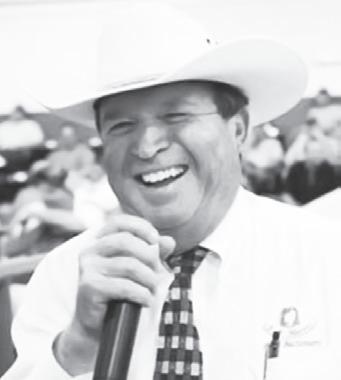

still not heavy enough, so we went to the tractor and got one of the log chains and put it through, and he got it on the seat. His body weight, the two packs of wrenches, and the log chain were enough to activate the seat.
Wesley hit that button again, and the green light came on. Shane told him to reach over on the far side and pull that lever. When he pulled that lever, the boom raised right up, just slick as a whistle, just like he had been operating it all his life. Shane told him when. We opened the door, and Wesley came out, and I went in.
Now to get the machine out. They had me hooked up, and the first one came out fairly good. Then I had to go through the second one, which was between me and the clearing. I went into that one,
and the machine bottomed out again. The whole front of the machine was up against the bank. I had to push the head down to let the machine set at an angle. Then he was able to pull me out, with me coming forward a little bit at the same time.
Gemma and Wesley were in the tractor with Shane, and when I came out, Wesley looked at his daddy and said, “GOT HIM!”
This was a happy youngin’ but an even happier granddaddy to get that machine out. I guess the worst thing that got hurt was my pride, and I will get over that. One thing about it, Wesley was the right size to get into that machine to save the day for Granddaddy. As a four-yearold, he will remember helping get the machine out for Granddaddy forever.

“If you have cattle, pastureland, or raise hay like I do, you need to call Donna Byrum. In 10 minutes on the hood of my pickup, she signed me up for a program that I had no idea about. The next time she came by the farm, she brought me a check!
~ E.B. Harris
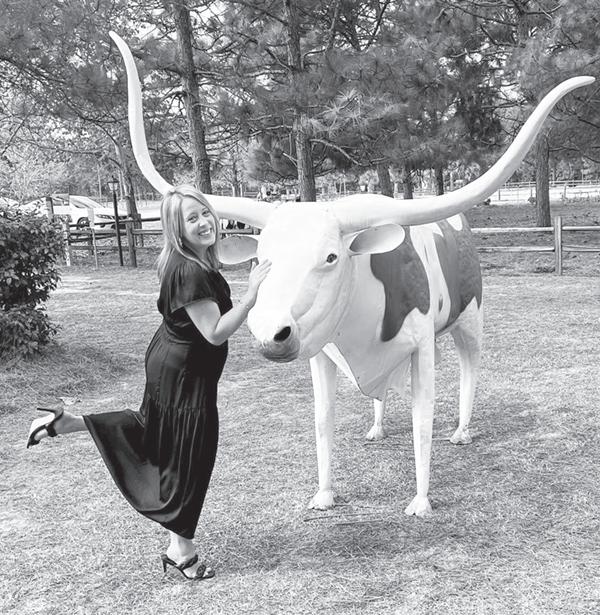
By MIGUEL S. CASTILLO, N.C. State University & LILIANE SILVA, Clemson University
A community of practice is defined as a group of people who share a common concern, a set of problems, or an interest in a topic and who come together to fulfill both individual and group goals. With the support of the N.C. Cattlemen’s Association and the extension systems from both North Carolina and South Carolina, five producers and two extension agents from North Carolina teamed up and traveled to meet with counterparts in South Carolina during late August 2024. Both groups are part of two different climate smart projects in each state. The main goal of the visit was to learn from each other and discuss management practices in pasture-based livestock systems.
A summary written by the North Carolina Extension Agents follows:
Our first stop was at Yon Angus in Ridge Spring, S.C., where Kevin Yon showed us fields planted to annual forages grazed under irrigation. These diverse pastures were rotationally stocked with yearling heifers. Kevin also shared a neat approach to develop pastures, or silvopasture systems. Their approach consisted of thinning tree stands by removing pine trees, mostly, while leaving a decent amount of good deciduous trees to provide shade for the grazing livestock. Then, they would go in and forestry mulch the stumps and
clean up the ground. After that, they used a three season annual rotation before seeding a perennial forage. It was a very practical and conservative way to keep topsoil in place and develop high quality pastures.
Our next stop was at Don Jackson’s farm, Pompey’s Rest, in Ware Shoals, South Carolina. Don shared with us his paddock system and information on how to decide to move cattle from paddock to paddock. He also showed us some forest areas that he was converting to silvopasture. Don’s way was a little different. He was leaving the stumps in place and letting the cattle and a small herd of goats manage the brush and turn it into a pasture without any “backbreaking work.” He plans to stump some areas so he can see the difference. Don plans to add legumes to his pastures, plant native grasses, and add more fencing infrastructure for better management of livestock and grazing. Don lent our group a wealth of knowledge on the process of being a regenerative farmer, along with the challenges he faced as well as the rewards along the way.
Our final stop was at Reed Edwards’s FoxPipe Farm in Laurens, South Carolina. Reed has a successful hay operation where he grows alfalfa-novel endophyte fescue hay and sericea lespedeza hay. Reed is also an avid grazier and manages


cattle and horses, which graze together. This practice is known as co-grazing. Reed shared with us his extensive knowledge of lespedeza and alfalfa hay production and how to manage them for high productivity while maintaining high nutritive value. Reed walked us through one of the pastures where he manages a diverse annual rotation of forages while sharing the difference in plant selection and why he chooses some species over others. Reed also showed us areas where gypsum and biochar were applied as field amendments and shared with us the differences he has observed in the soil analysis and plant responses.
plans to take several new methods he learned to try at home. Franklin County agent, Martha Mobley, traveled with four producers — Max Jones, Mario Delgado, Ray Miller, and Justin Johnson. All learned many new practices and were reminded of several grazing practices, and habits, that appear common among the farms visited. For example, keeping the Southern Forages book beside their bedside tables. Area Livestock and Forages Extension agent Reid Miller from Clemson met and guided the group upon arrival in South Carolina. Maggie Miller, extension associate from Clemson, also joined the group at Reed Edwards’s farm.

“Overall, it was a great trip with great people. We often forget that this type of fellowship is what we are craving until we get out there and experience it. I am grateful that I was able to attend, and I know that I will look forward to another opportunity to attend such an event.”
Guilford County livestock and field crop farmer Don York traveled with Cole Maness, livestock agent in Guilford. Feedback from Don, as shared by Cole, was that this experience was extremely valuable to him. Don is a very progressive farmer, and he is always looking for another way to gain an edge. Don said that he enjoyed seeing the different styles and methods, and
Developing and maintaining a community of practice is not an easy task. No doubt, however, it can be a very rewarding experience for the participants. We look forward to new opportunities to engage and provide “boots on the ground” learning experiences for land and livestock managers who can learn from each other. Financial support is critical for this type of educational programs. We are grateful to the N.C. Cattlemen’s Association for providing financial support and to the South Carolina farmers and extension personnel who served as hosts. We look forward to new opportunities to learn from each other, wherever the community meets next time.

By ALAN FRANZLUEBBERS USDA-Agricultural Research Service
What is soil carbon? Carbon in the soils of the Carolinas is composed mostly of organic carbon, as contrasted with high levels of inorganic carbon from carbonates or caliche in the western United States. Organic carbon was once in living plants and animals and has since been transformed by soil microorganisms to form organic matter in soil. Soil organic matter is composed mostly of carbon. In fact, carbon makes up 58 percent of soil organic matter, and nitrogen makes up about 5 percent of soil organic matter. These two elements are measured in most analytical labs to determine the percentage of soil organic matter. The hundreds of billions of individual bacteria and fungi in a teaspoon of soil are composed of carbon. However, the non-living component of soil contains the most soil organic carbon. Non-living components of soil carbon can be in small organic matter pieces called particulate organic matter, in dissolved organic matter that makes standing water turn the color of tea, in humic matter that is highly stable and doesn’t break down easily, and in various inert organic components such as charcoal following the burning of plant biomass.
Why is soil carbon important? Soil carbon is important to farmers, and should be important to the public because it is a vital component of ecosystem properties,

processes, and functions. These features are explained in the following paragraphs. Importantly, this relatively small organic component of soil provides many of the features needed to make soil healthy and functioning to its natural potential capacity. Healthy soil makes an excellent growing medium for crops and pastures, as well as to protect the environment and provide ecosystem stability.
What are some physical features of soil carbon? Carbon gives soil a dark color to absorb heat. Soil carbon has low solubility, ensuring that organic matter inputs are retained and not rapidly leached from the soil profile. Soil with high carbon content acts like a sponge to retain more water for plant growth, and it stabilizes soil structure to provide pore space for microorganisms (bacteria and fungi) and various soil critters (earthworms, beetles, and spiders).
What are some chemical features of soil carbon? Soil with high carbon content increases cation exchange capacity to retain cations like calcium, magnesium, ammonium, iron, and aluminum. Soil carbon buffers against pH swings to keep acidity in a more acceptable range for plants. Soil organic matter complexes metals to enhance the dissolution of some minerals, enhance the availability of phosphorus, reduce the loss of micronutrients, and reduce the toxicity


of heavy metals. Soil organic matter can alter the biodegradability, activity, and persistence of pesticides applied to soil or that get into soil.
What are some biological features of soil carbon? Soil carbon in organic matter offers a reservoir of energy to drive biological processes. Soil organic matter encapsulates various plant-essential nutrients in a long term storage condition. However, these nutrients are slowly released to plants through soil microbial activity, i.e., bacteria and fungi that feed on this organic matter. Soil carbon can both enhance and inhibit enzymes that transform plant-available nutrients. High soil carbon content provides ecosystem resilience, enhancing the ability to recover from various disturbances, such as drought, flooding, tillage, and fire.
What does forage have to do with soil carbon? More and more research has been documenting how improved forage and grazing land management significantly increases soil carbon, thereby promoting greater soil health features and improved ecosystem resilience. Climate changes threaten
ecosystem resilience. Managing soils with greater soil carbon content will help farmers limit the negative consequences of climate change. Better forage management, therefore, can be viewed as an effective adaptation strategy to climate change. Additionally, better forage management with increased soil carbon content can be considered a climate change mitigation strategy when deployed over large areas. This is because carbon dioxide in the atmosphere is transferred to fixed carbon stored in soil organic matter.
Just a reminder that soil organic matter is the primary source of carbon in Carolina soils. The box below lists some common concentrations in different units that you may see in publications.
Carbon concentration of Carolina soils varies considerably. This variation is primarily a function of soil depth. Carbon is most often concentrated near the soil surface. When probing deeper into the soil profile, one will find less and less soil carbon on a concentration basis. The average soil carbon concentration at different depth increments is shown in


Box 2. Soil carbon declined much more with each initial increment below the soil surface, but then there were smaller declines deeper in the profile. This is a typical depth distribution of organic matter all around the world. In other words, soil organic matter concentration follows a non-linear decline or a logarithmic decline with depth.
therefore, do not aggregate readily. Soils with significant quantities of clay and silt will form strong aggregates that are even stronger with increasing soil organic matter concentration.
Soil texture is a key factor affecting soil carbon concentration because of the ability of clay and silt particles to attract organic matter and encase it in stable

Not only does soil carbon vary with soil depth, but also because of differences among physiographic regions. North and South Carolina share the same physiographic regions of the relatively flat Coastal Plain, the hilly Piedmont, and the Blue Ridge Mountains. In general, the soils in the Coastal Plain are coarse textured, with mostly sand and little silt and clay sized particles. Soils in the Piedmont and Blue Ridge can also be sandy, but are more often fine textured. Clay particles are very small and technically defined as less than 2 micrometers in diameter (a micrometer is 1/1,000 of a millimeter). Sand particles are greater than 53 micrometers in diameter. Silt particles have a diameter of 2-52 micrometers. Because of their small size, clay and silt have electrostatic charges and are chemically reactive. This allows the particles to aggregate. Sand particles do not have much reactivity and,

partly due to elevation, which controls mean annual temperature (warmer in the Coastal Plain and cooler in the Blue Ridge) and soil texture differences. There may also be some forage species differences that contributed. Management differences among farms will be the focus of a future issue of this series.
The average soil carbon concentrations at 0–6 inches of depth in Box 3 translate to 3.2 percent soil organic matter in the Coastal Plain, 4.4 percent soil organic matter in the Piedmont, and 5.0 percent soil organic matter in the Blue Ridge. These values are nothing to sneeze at, especially when we are typically reminded that the soils in the Carolinas are relatively poor, for example, less than 1 percent. The key here is that most soil samples were collected under decades
of pasture management. If one samples deeper than the surface 6 inches, then soil organic matter concentrations are much lower. The average percent of soil organic matter at 6-12 inch depth was 1.1 percent in the Coastal Plain, 1.2 percent in the Piedmont, and 1.8 percent in the Blue Ridge.
In summary, carbon gives soil its vitality. Stabilized in soil as organic matter, it helps store abundant plant available nutrients, it loosens soil to allow rapid water infiltration and hold more water over time, and it provides the needed resources for soil microorganisms to be actively transforming soil into a fertile substrate. Carbon in soil is concentrated near the soil surface, where it can provide the greatest benefit to the plants it nourishes.
aggregates that also physically protect organic matter from decomposition. This means that soil bacteria and fungi have more difficulty accessing these organic resources. Therefore, fine textured soils are often observed to store more carbon than coarse textured soils. However, management of soils can sometimes override these physical regulators.
Soil was collected on multiple pasture based livestock farms in North Carolina in 2023. This included 108 samples in the Coastal Plain region, 394 samples in the Piedmont region, and 146 samples in the Blue Ridge region. Box 3 reports the average soil carbon concentration in these three regions as a function of sampling depth. Again, carbon concentrations were highly dependent on soil depth in all three regions. In addition, the elevation gradient rising from the coast to the mountains led to greater soil carbon concentrations. This effect is
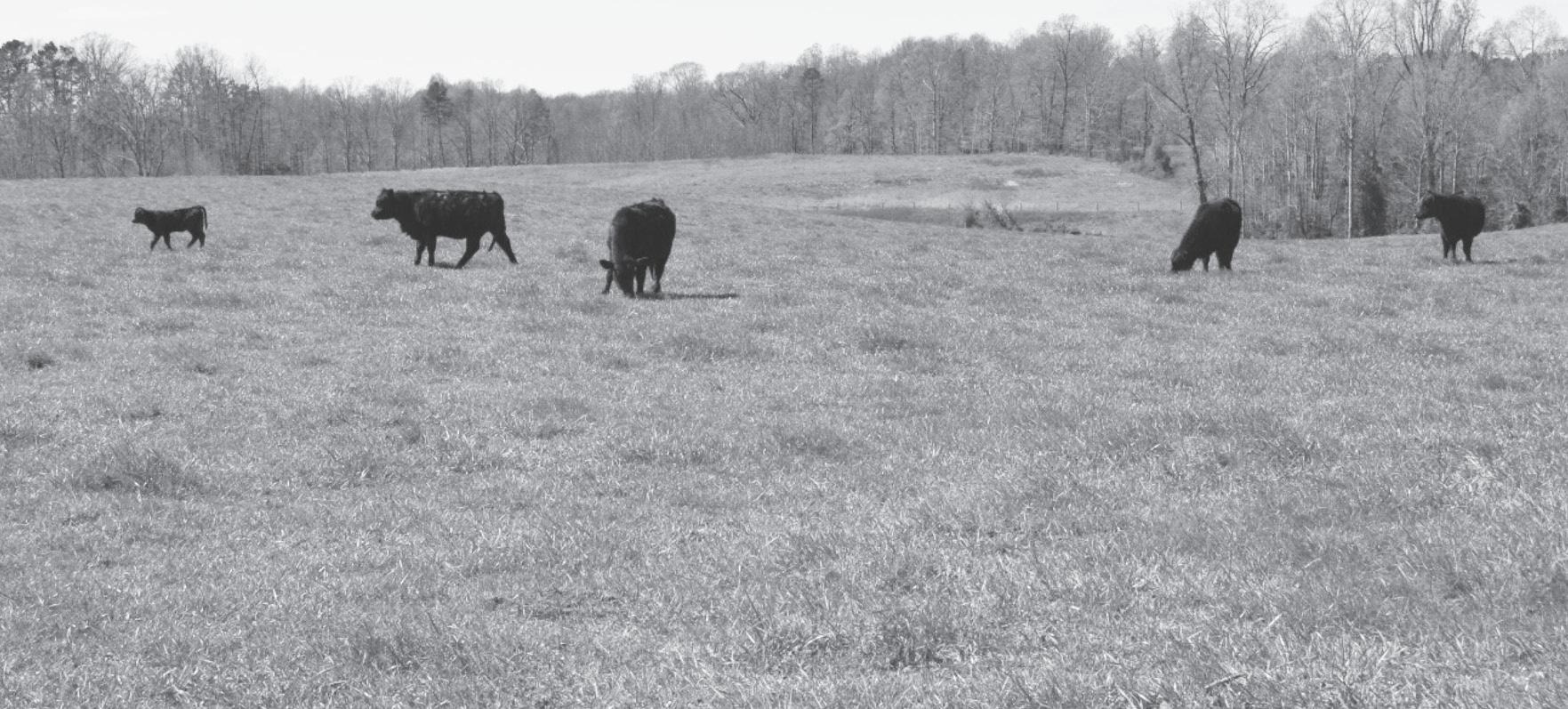

You shouldn’t have to have a gun held to your head to take advantage of the expert A.I., superior genetics, the best in purebreds and outstanding farm supplies featured in the Classifieds in this issue!

By MAKAYLA HOLLOMAN N.C. State University -- ANS 402 Beef Management
It is well known that feed is one of the highest costs of beef production. Most cattle operations, especially in the realm of the cow/calf sector of North Carolina, rely on pasture to meet a large portion of their nutrient requirements. Many difficulties can arise in regards to the management of this commodity, such as overgrazing and forage inconsistencies. One option that has been shown to improve forage quality, especially for smaller farms, is multi-species grazing systems. These involve more than one type of livestock grazing the same area of land, whether simultaneously or at different times within the same season.5 While production farms generally utilize
an area of land for one species, multispecies grazing is how natural ecosystems are regulated and is the most common practice in other areas of the world. 3 Multi-species grazing offers many benefits in several capacities, including forage quality, production, and economics.
One of the most beneficial reasons to utilize a multi-species grazing system is that it can greatly increase pasture quality. With a single species on a pasture, the best forages become closely grazed, placing selection on and resulting in the proliferation of the least palatable plants and grasses.4 In a pasture with a variety of vegetation, a combination of cattle and small ruminants allows for more


uniform defoliation. This results in plants regrowing at similar rates and increasing their quality and resiliency. 4 In the example of cattle and small ruminants, each have preferences for both the type of forage they consume as well as where they graze. Figure 1 displays these differences in topographic and dietary preferences, demonstrating how grazing them together offers benefits to pasture quality.5 When considering adding small ruminants to a beef pasture, it is important to recognize the amount of forage available, and to consider the numbers of each species. Moderately stocked pastures are usually capable of supporting a 1:1 ratio of small ruminant to bovine, while pastures with higher quantities of undesirable brush or shrubbery should have more goats or sheep to eat those plants.5 It is essential to tailor the type and numbers of species to the quantity and variety of vegetation available.
Multi-species grazing also offers benefits for parasite control when combined with a parasite management plan. Cattle, horses, and small ruminants are susceptible to different parasites.2 Most parasites that infect cattle are species specific and do not infect small ruminants. In turn, grazing these species together on the same pasture can help to disrupt the life cycle of the parasites. With multiple species consuming parasitic larvae, the resulting parasite loads are spread out among the livestock animals. With the parasites only being able to survive in their respective species, the overall number of parasites is decreased.4
In addition to pasture and health factors, multi-species management offers several economic benefits. Risk management is an important factor to consider, and incorporating multiple products that can be marketed at different times of the year provides alternate revenues of income and therefore
economic stability. 5 Additionally, studies have shown that cattle have earned more per head when stocked with sheep and goats, with potential to increase net income up to 29 percent as opposed to cattle-only herds.1 Studies have also shown that adding sheep to a cattle herd increases productivity and carrying capacity by 20-25 percent, due to the increased forage quality of pastures.4 Increased pasture quality and pasture carrying capacity can result in an increased number of cows and calves and increased weights on both. While there are various economic benefits to multi-species grazing, there are also startup costs of incorporating an additional species and the labor and management required to do so.
Some other challenges should also be considered when discussing multispecies grazing. For starters, many beef farmers do not have experience with small ruminants. Learning through cooperative extension programs or
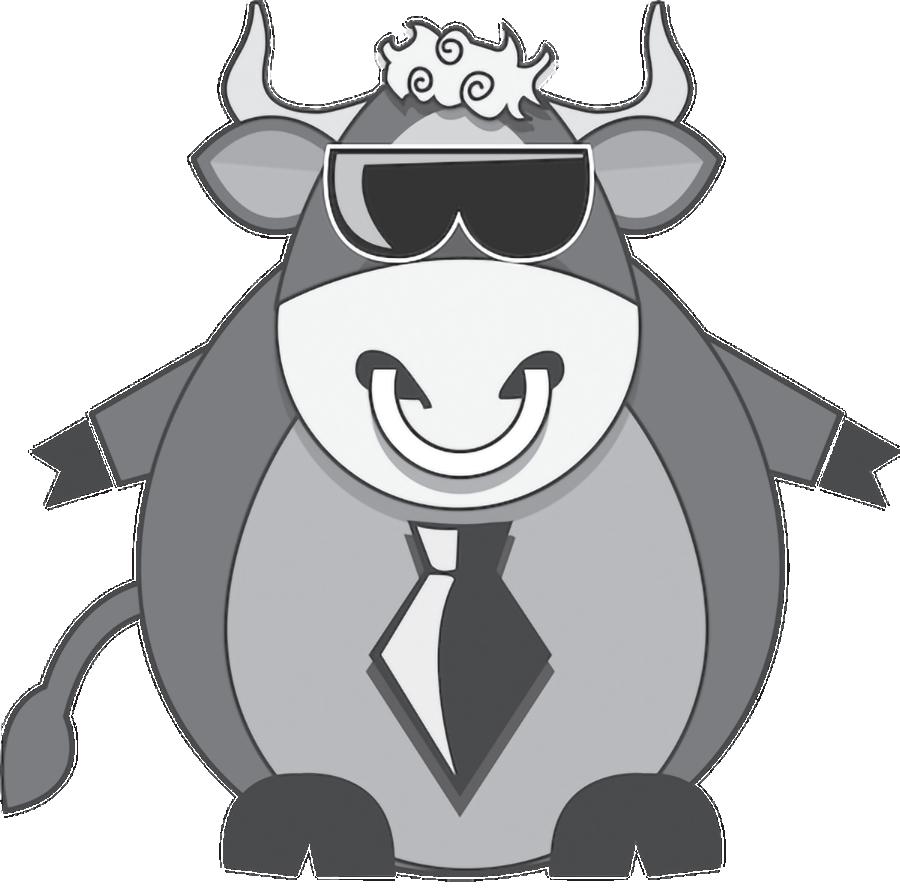
partnering with farmers of other livestock species can help combat this, but there must be initiative taken to ensure proper management and the best economic results. 5 One specific example of a management difference between sheep and cattle is the number of minerals that are safe for consumption. Sheep are more sensitive to copper, so additives to cattle diets must be considered if they are easily accessible by the other species. 5 Additionally, fencing that has been built
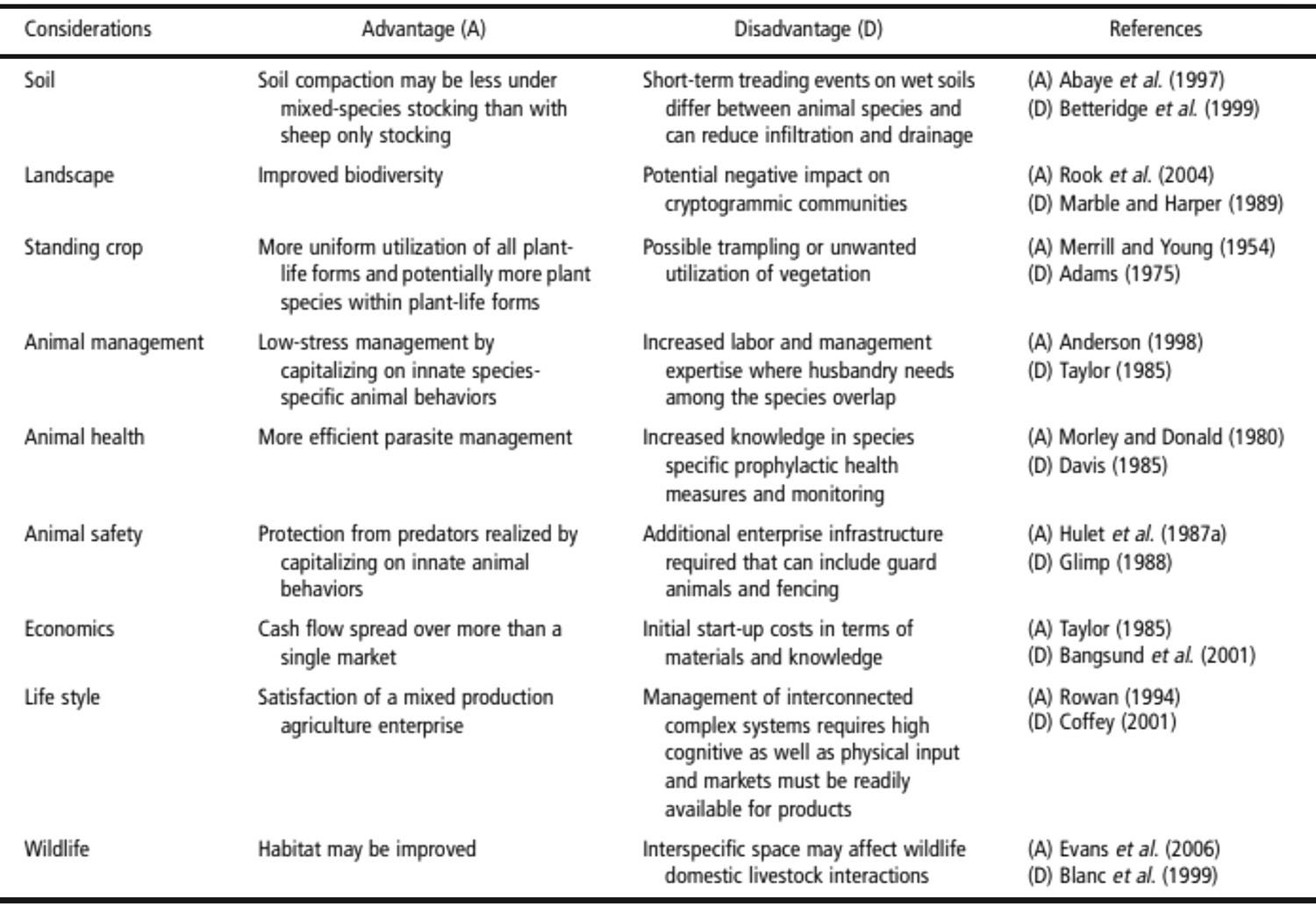
Figure 2. Pros and Cons to Mixed Species Stocking Note. The table discusses additional factors that should be considered when deciding if a multispecies grazing system should be utilized.1
for cattle can be an issue when trying to contain small ruminants in the same space. While it comes with an added cost, additional electric or barbed wire can be added to current fences to contain the herd and to keep predators out.5 These are some of the most common challenges, but each operation should consider additional factors when determining if multi-species grazing is right for them.
Figure 2 describes some additional considerations for mixed species grazing systems, as well as their pros and cons. Overall, multi-species grazing offers numerous benefits, ranging from increased pasture quality to higher economic returns. There can be challenges, whether it be from startup costs or from the management and labor required down the line. While this is a great strategy that can be utilized, it is essential for each farmer to weigh the pros and cons and apply them to their individual operation. While the benefits may outweigh the costs for some producers, others might find that multispecies grazing systems may not be the right fit for their operation. At the end of
the day, each producer should do what is best for his or her own herd.
References
1 Anderson, D.M., Fredrickson, E.L., & Estell, R.E. (2012) “Managing livestock using animal behavior: Mixedspecies stocking and flerds. https://doi. org/10.1017/S175173111200016X
2 Barkley, M. (2023) “Prevent parasites through grazing management.” https://extension.psu.edu
3Multispecies grazing. (n.d.) www. csuchico.edu
4Rinehart, L. (2019) “Add diversity to your pastures with multi-species grazing.” https://smallfarms.cornell.edu
5Walker, J.W., Coffey, L., & Faller, T. (2006) “Improving grazing lands with multi-species grazing.” https://extension. unl.edu
Have You Herd is written as part of the ANS 402 Beef Management course requirement at N.C. State University’s Department of Animal Science under the instruction of Dr. Carrie Pickworth. The opinions of Makayla Holloman are not necessarily those of N.C. State University or Dr. Carrie Pickworth.

By DR. MIKE WALDEN
William Neal Reynolds Distinguished Professor Emeritus N.C. State University
You Decide: Are We Headed for a Recession? The year 2024 began with optimism for the economy. Despite relatively high interest rates and efforts by the Federal Reserve to slow the pace of the economy in order to reduce the inflation rate, a recession was avoided. The hope for a “soft landing” in the economy, where price gains are moderated without pushing the economy into reverse, seemed to have been achieved. And hope increased that the Fed would begin reducing its key interest rate sometime during the year.
But a few weeks ago, this optimism seemed to disappear. In one day, the Dow Jones stock average, one of the most followed measures of the stock market, dropped a headline grabbing 1,000 points. This drop followed a disappointing job market report and a jump in the unemployment rate. It was also reported that after the higher jobless rate was posted, one indicator of the future economy called the Sahm Rule was now predicting a recession. Immediately, I received numerous calls for my interpretation of what was going on with the economy. In my answers, I first gave background on the factors shaping the current economy. I then followed with a discussion of likely forecasts of where the economy will go. I will attempt to do the same here.
The COVID-19 pandemic and resulting recession prompted the federal government to “go big” with fiscal policy. Fiscal policy is the government using the tools of taxes and spending to impact the economy. The worry during the pandemic was that the economy wouldn’t recover and the jobless rate would linger in the double digits. As a result, during 2020, 2021, and part of 2022, the federal government pushed trillions of dollars into the economy in the form of program spending and financial support for households and businesses. At the same time, monetary policy, which is operated by the Fed, expanded the money supply by trillions of dollars and pushed interest rates to historic lows. In the second half of 2020, the economy began roaring back. By the end of 2020, the jobless rate had been cut in half, and the annual all-item inflation rate was at a low of 1.3 percent. It looked like the economy was on to a
robust and low inflation recovery.
But what was different from previous recoveries from a recession — and what policymakers didn’t anticipate — was global supply chain problems, which kept a variety of products off the shelves. Hence, just when households were flush with cash — compliments of government financial assistance — and ready to spend, there was less available for them to buy. The shortages impacted everything from homes to paper towels to lumber. There was an enormous gap between the amount people wanted to buy (“demand” in economics lingo) and the amount available to sell (“supply” in economics speak). The result was a sustained jump in prices, with the annual inflation rate reaching 9.1 percent in June 2022.
Although the Fed was late in anticipating the problem, by 2022, it had completely reversed its monetary policy. It had begun raising interest rates and cutting the money supply in order to slow consumer spending and moderate price hikes. Also, at the same time, the global supply was being fixed, and shelves became full. The combination of less robust “demand” and greater “supply” allowed the annual inflation rate to drop to near 3 percent, still higher than in 2020, but certainly a sign of progress.
Topping these achievements is the fact that they’ve been accomplished without a recession, which is unusual. This brings us to today. Will the Fed continue to be able to claim the glory of cutting average price gains to a more normal 1-2 percent with no recession in the process?
For those inclined to answer “no,” there are three worries. Households have run through their COVID-19 savings and will have to increasingly borrow to sustain spending. But this can’t last forever, so at some point, consumers may reduce spending, thereby causing businesses to cut payrolls and employees.
Until very recently, investment markets have been booming. Since 2021, the stock market is up 25 percent, and average home prices have surged 33 percent. If deep cracks appear in the economy, investments like stocks and real estate could begin losing value, with the losses sparking trauma in the economy.
Last, while the Fed perceives these concerns and has signaled a readiness to begin reducing interest rates, the fear is that the Fed may have waited too long. Pessimists think the damage has already been done, and a recession is already baked into the cake.
And although the optimistic camp doesn’t expect a recession, it recognizes these three worries. Optimists agree that consumer spending and the labor market are slowing, investment markets may give back some of their gains, and the Fed has been slow to cut rates and increase the money supply. However, while the pessimists see these conditions leading to recession, the optimists see them as resulting in a slowdown. Indeed, optimists point out that the recent increase in the jobless rate wasn’t due to job losses but instead happened because the number of jobs created was less than the number of new people looking for jobs. So optimists expect the economy to continue to grow, just at a slower pace. Optimists see a slowdown, not a meltdown, in the economy.
Let me throw in my two cents worth about North Carolina’s economic future. Each month, I construct a leading economic index for the North Carolina economy. The index has been relatively stable for the past year, suggesting a path of continued growth in the state.
At the beginning of 2024, I forecasted a bumpy national economy for the year. By bumpy, I meant some pullback in growth and investments, as well as some months when the jobless rate would rise, but there was no sustained period where the important elements of the economy all declined. Hence, the choice for the remainder of 2024 appears to be between negative growth and a recession or slower
growth — which can result in higher joblessness — but no recession. Which makes the most sense? You decide.
You Decide: Can the President Control the Economy? With the presidential campaigns in full force, one question people are asking is if a president can control the economy. In fact, I’ve had this question put to me by both the media and attendees at meetings.
In the type of economy we have — a market economy — a high majority of day-to-day economic decisions are made by business people in companies and by individuals in households. This is by design. Promoters of the market system argue that individualized decision making about the economy maximizes freedom.
Yet even in the market system, the government has some influence. For example, local governments like cities and counties apply zoning regulations to control land uses. In North Carolina, the state government funds roads and also a large portion of both K-12 and public university spending. Also, both local and state governments contribute to public safety by financing law enforcement and the court system.
When it comes to the economy, the federal government is the big player, and this is where a president can have influence, but not control. This wasn’t always the case. Until the 1930s, when the Great Depression occurred, the federal government largely followed a “hands-off” approach to the economy. An exception was the use of tariffs on foreign imports. Tariffs are effectively a tax on foreign made products sold in the United States. They were used to motivate consumers to buy domestic made instead of foreign made products.

Then came the 1930s, probably the worst economic decade in our history. The federal government responded by taking an active role in the direction of the economy by developing fiscal policy. Fiscal policy involves using federal taxing and spending to influence how fast the economy grows. If the economy is not growing enough, and especially if it is contracting — as in a recession or depression — then fiscal policy means the federal government will cut taxes and/ or increase spending to stimulate growth. Of course, this can mean more borrowing. Conversely, if the economy is expanding too fast and prices are rising rapidly, the federal government attempts to cool the economy and slow price increases by raising taxes and/or reducing spending.
After World War II, when there was fear the economy would slip back into a depression, Congress encouraged the country’s central bank, the Federal Reserve, or Fed, to use its influence over interest rates and the supply of money to impact the direction of the economy. This is called monetary policy. To boost economic growth, the Fed will lower interest rates and increase the money supply. When the objective is to slow the economy and lower the inflation rate, the Fed raises interest rates and cuts the money supply.
With this background, I can now address the question about a president’s power over the economy. A president has influence over both fiscal policy and monetary policy, but the influence is indirect. Fiscal policy is implemented through the federal budget. While a president can make recommendations about the budget, ultimately both chambers of Congress must pass the budget. This often results in long negotiations between the president, both chambers, and all political parties in Congress.
For monetary policy and the Federal Reserve, a president does have the power to appoint the members of the governing body of the Fed (with the consent of the Senate), called the Board of Governors. A president also has the power to appoint one of those board members as chair.
While this may imply the president has major control over the Fed, this actually isn’t the case. The reason is that the term of the board members is long, at 14 years. This is longer than two full terms for a president. Additionally, while the chair serves a four year term, that term does not necessarily match the presidential term. Also, although the chair is the “face” of the Fed, the chair only has one vote on the Board of Governors, just like the other board members.
It is thought that the framers of the Fed over a century ago purposefully made presidential influence over the Fed difficult in order to insulate monetary
policy from political influence. The Fed is also independent of Congress, due to the fact that Congress does not fund the Fed. Instead, the Fed is self financed from interest earnings on securities it owns. However, Congress does have the power to change the Fed’s charter. The changes would have to be approved by the sitting president, or Congress would have to overrule a president’s veto of the changes.
The conclusion is that a president’s powers over the economy are limited, especially with the two major tools of fiscal policy and monetary policy. However, there is another source of presidential influence that shouldn’t be overlooked. This is a president’s use of the “bully pulpit,” a term coined by
Theodore Roosevelt to mean a president advocating policies using speeches and interviews. The goal is to generate public support for policies and public pressure on Congress to agree with a president’s ideas and recommendations.
A president doesn’t guide the economy like an executive or manager guides a company. A president has influence over the economy, but the influence is indirect through working with Congress, making appointments to the Federal Reserve, and rallying support from the public. So while the economic ideas of a president are certainly important, the reality is that it takes more than that one person — even a very powerful person — to move the economy. There are many, many hands on
the oar of the economic ship. Is this the way it should be? You decide. You Decide: Why Is There Confusion About the Job Market?
As a professional economist for almost five decades, I am the first to admit that many economic numbers and measures are confusing. How many people — besides economists — know what GDP, the federal funds rate, or the personal consumption expenditures price index mean, or what the difference is between the budget deficit and the national debt? Most people would think the easiest
Continued on next page

Backed by the world’s largest and most reliable genetic evaluation program.
Registered Angus genetics deliver better calving ease, more growth, and superior marbling.
4K FARMS
Richard D. Kirkman, DVM Siler City 919-742-5500 • rdkirkman@spectrum.net
BACK CREEK
Joe & Robin Hampton Mt. Ulla
704-880-2488 (Joe); 704-880-3572 (Robin) robinbackcreek@att.net Facebook: Back Creek Angus
BILTMORE ESTATE
Kyle Mayberry - Manager Asheville 828-768-1956 • livestock@biltmore.com www.biltmorelivestock.com
CARSON FAMILY FARM, LLC
John, Callie, Isaac & J.R. Carson Laurel Springs 336-818-9087 • carsonfamilyfarm@gmail.com
CHAPMAN CATTLE COMPANY
Bryant Chapman Taylorsville 828-514-0526 https://.m.facebook.com/chapmancattleco
FOUR S FARMS
Kim & Connie and Jason & Robin Starnes Luther Lyerly - Manager Salisbury 704-640-5875 • kim-4sfarms@carolina.rr.com
GENTRY HOMEPLACE ANGUS
Howard & Donna Gentry King 336-413-6698 • whgentry@windstream.net
GRAGG FARMS
Paul, Chris & David Gragg Boone 828-268-4136 (Paul); 828-268-4137 (Chris) 828-268-4135 (David) gragg_farms@hotmail.com
H&H FARMS
Buddy & Jennifer Hamrick - Owners Bly Hamrick - Manager Boiling Springs 704-472-1912 • jennham@bellsouth.net
HI-LO FARMS, LLC
William “Monty” & Kate Reichert Fuquay-Varina 919-717-1903
HILL ANGUS FARM
Dr. Gary M. Hill Hendersonville 229-848-3695 • gmhill@uga.edu
Cortney Holshouser
NCAA Executive Secretary
919-796-2346 ncaa.sec@gmail.com www.ncangus.org



JACK KNOB FARMS
Karl, Janet & Logan Gillespie Franklin 828-371-2220 • karl@jackknobfarms.com www.jackknobfarms.com
JENKINS ANGUS FARM
Jaime & Christy Jenkins Marshall 828-206-1345 • jenkinsangusfarm@gmail.com
KNOLL CREST FARM
The Bennett Family Red House, VA 434-376-3567 • knollcrestfarm@knollcrestfarm.com www.knollcrestfarm.com
LANE ANGUS
Roger & Bundy Lane
Bundy Lane - Manager Gates 252-398-7705 (Bundy); 252-398-7719 (Miranda) 252-357-1279 (Office) bundylane@hughes.net; laneangusbeef@gmail.com www.laneangusbeef.com
N.C. State University
- E. Carroll Joyner Beef Unit
Matt Morrison - Manager Raleigh 716-720-0227 • mdmorri8@ncsu.edu
PANTHER CREEK FARMS
John C. Smith, Jr. Pink Hill
252-526-1929 • johnsmith3982@embarqmail.com
S&J Farms
Steven & Julie Lung
Nathan Lung - Manager Carthage 910-947-3414 • sandjfarms2013@gmail.com
SMITH CREEK ANGUS FARM
Marty & Lynne Rooker Norlina 252-213-1553 • mrooker@mrookerlaw.com
SPRINGFIELD ANGUS
Phil Goodson Louisburg 919-880-9062 • philgoodson2@gmail.com www.springfieldangus.com
TRIPLE LLL ANGUS
Greg Little Monroe 704-219-1294 • greg.little@atimetals.com
VANDEMARK ANGUS
Keaton & Janie Vandemark Spring Hope 252-885-0210 • keaton@vandemarkfarms.com
WINDY HILL FARMS, LLC
Michael A. Moss Will Moss - Manager Ramseur 336-460-7451 • windyhillfarmsllc@gmail.com
WINSLOW GENETICS
Ben & Kathleen Winslow Halifax 252-578-5487 • bensbulls@gmail.com
WOOD ANGUS FARM, LLC
Russell Wood Willow Spring 919-275-4397 • rwood4400@gmail.com www.woodangus.com
statistic to understand is jobs. Yet, you are wrong! First, there are two different and independent measures of jobs, as well as periodic revisions of the numbers. Furthermore, there are multiple measures of the unemployment rate. With all these different statistics floating around, how’s any person — other than an economist — expected to make sense of the job market and decide whether it’s good or bad?
In today’s column, I’ll walk you through the major job numbers and related measures and give common sense explanations for their meanings. Then you’ll be prepared to understand the numbers as they are released, so you can decide on the condition of the job market.
But before I begin, exactly who creates the job numbers? While there are some private estimates, the official numbers are generated by the U.S. Bureau of Labor Statistics (BLS). The BLS has a reputation for high credibility.
I’ll begin with the basics of simply counting jobs. The BLS conducts two monthly surveys. The first, called the establishment survey, counts jobs at businesses. The second, the household survey, directly asks individuals about their work status. The establishment survey also tells us where people are working, while the household survey provides the information to calculate the various unemployment rates.
Both are surveys, meaning the numbers of businesses and households providing information are far less than their actual total numbers. This is not unusual. Polls about voting intentions, product preference, and myriad other decisions are also done by sample polling.
Which brings me to a recent debate: It was reported that the BLS reduced the total national job count for the year March 2023 through March 2024 by over 800,000. While the BLS regularly makes such revisions each year, this number was exceedingly high and sparked charges of possible manipulation. Yet, there are logical answers for the revision.
The first is that when conducting the monthly surveys, all businesses in the sample may not be ready with their numbers. The BLS could wait until the tardy businesses had the data ready, but the agency is always under pressure to release the numbers on schedule. BLS also doesn’t want to substitute another business because each is carefully selected to represent a specific part of the job market. So the BLS estimates each lagging firm’s job number, and in the case of this year, the estimates were too high.
A second logical answer is that, as with so many things, the pandemic is
having a lingering impact. How? It’s highly likely the BLS has not yet fully adjusted sampling models to account for the impacts of COVID-19.
Another confusing part of the jobs report has to do with what is interpreted as a good number or a bad number. It’s often a matter of expectations. Each month before the official jobs report is released, there will be a “guess” for the change in the number of jobs based on estimates from private firms and economists. If the actual change in jobs is less than the expected change, financial markets can react negatively, even if the actual change was positive. This happened for the recent August jobs report. Even though the job gain in August was higher than the job gain in July, the August gain was less than expected.
Let me now move on to the important topic of unemployment. The jobless rate is likely the most widely followed labor market number, mainly because it’s easy to understand. People intuitively know that if the jobless rate rises, it’s not good for the broad economy and could warn of bad times ahead.
But, of course, economists aren’t content with one measure of the jobless rate. Instead, economists have created several rates, with each saying something slightly different about the job market.
The official jobless rate is based on a simple calculation. It is the number of individuals who don’t have a job and who are actively looking for work and available for work as a percentage of the labor force. The labor force is made up of everyone aged 16 and over, except for those on active military duty or institutionalized. The national rate in August was 4.4 percent, up from 3.9 percent in August 2023.
But there are alternative jobless rates developed by BLS. A closely watched rate, the U-6, includes the above mentioned unemployed but adds people who want a job but have stopped looking, as well as individuals who have a part-time job but want a full time job. In August, the U-6 rate was 8 percent, up from 7.2 percent the year earlier.
Of course, care must be taken not to mix these different jobless rates because they use different measures of unemployment. The official jobless rate has the narrowest measure of unemployment, whereas the U-6 rate has the broadest definition. I like to follow both.
Numbers about the economy are constantly thrown at us — so many numbers that non-economists need a guide to what they mean. Hopefully, this column has given readers a guide to make common sense of key labor market numbers. But, you decide.

A new book brings to life consequential developments in agriculture and the Angus breed. The History of Aberdeen Angus in the U.S., UK, and Worldwide , a monumental book three years in the making, has been released. This oversized, hardcover, 544 page “coffee table” book with over 1,600 historic images dives into every nook and cranny of the development of agriculture, the cattle industry, stockyards, and the most dominant beef breed in the world, Aberdeen Angus. These are cattle bred for a purpose: the efficient production of tender, juicy beef.
The book is full of surprises and often clarifies times in history that may have strayed from actual events in modern characterizations. The authors — Dr. Bob Hough, Andy Frazier, and Tom Burke — accomplished this by
researching original documents, whether newspapers, ag society journals, or rare books from as far back as the 18th century.
What they found was in jeopardy of being lost to time. Yet, in this new book, the documented development of agriculture in general and the Angus breed specifically is brought back to life.
For instance, in northeast Scotland, where Aberdeen Angus was developed, there were originally nine local strains of cattle and three outside strains that had penetrated the region’s market. The founders of the Aberdeen Angus breed took the best traits of these strains and then bred like-to-like until they bred true for the traits they desired.
The book chronicles trailblazers such as Hugh Watson of Scotland, who is considered by many to be the founder of the Aberdeen Angus breed. From his early

sale advertisements, it becomes apparent that his herd was far more diverse than is currently thought. Watson also goes into detail in correspondence with the Highland Agriculture Society on his nurse cow system, in which one cow during the year would nurse two calves, followed by another two calves, and then a fattening steer.
The English agriculturalist Robert Bakewell gave us the blueprint for the formation of breeds and is considered the father of animal breeding. However, he lived in a former monastery, where the main hall had a flair for the macabre, filled with skeletons and parts of carcasses pickled in brine to demonstrate his selection process and results.
The British agriculture revolution that made breeds like Aberdeen Angus possible is covered in detail, as is the Scottish Age of Enlightenment. The book details the colonization of North America, the formation of the U.S. and its cattle industry, and the controversial era of “Manifest Destiny” that resulted in the growth of the U.S. from coast to coast.
This compelling volume also chronicles the rollercoaster of cattle fads and styles over time that were often driven by the show ring. The book reveals that the first office of the United States’s Angus Association was located in the utopian community of Harvey, Ill., which barred drinking and gambling, as well as lewd
and immoral behavior, with the penalty for these offenses being forfeiture of your property. It sheds a whole new light on how the stockyards were built, which will surprise the most ardent student of the subject. Additionally, the book goes into detail on how tallow was converted into nitroglycerin during World War II.
R. John Dawes, who is the primary author of the famous book Breeds of Cattle , observes, “This comprehensive volume on the Angus breed is full in content, history, and artwork. Never before has one book comprehensively covered the worldwide importance of this historic breed of beef cattle and its rise to worldwide prominence in the beef industry…This is a must have volume for any livestock person.”
Scotland’s noted Aberdeen Angus breeder and judge Willie McLaren summarizes, “This is a very well written and illustrated ‘must have’ book that anyone interested in the Angus breed should own and be proud to hand down the generations.” Megan Friel of New Zealand concurs, saying, “I think the book is wonderful and should be compulsory reading…as people need to know where their food comes from.”
The History of Aberdeen Angus in the U.S., UK, and Worldwide is available at www.AngusHistoryBook.com or the American Angus Hall of Fame. Call 816532-0851 for more information.



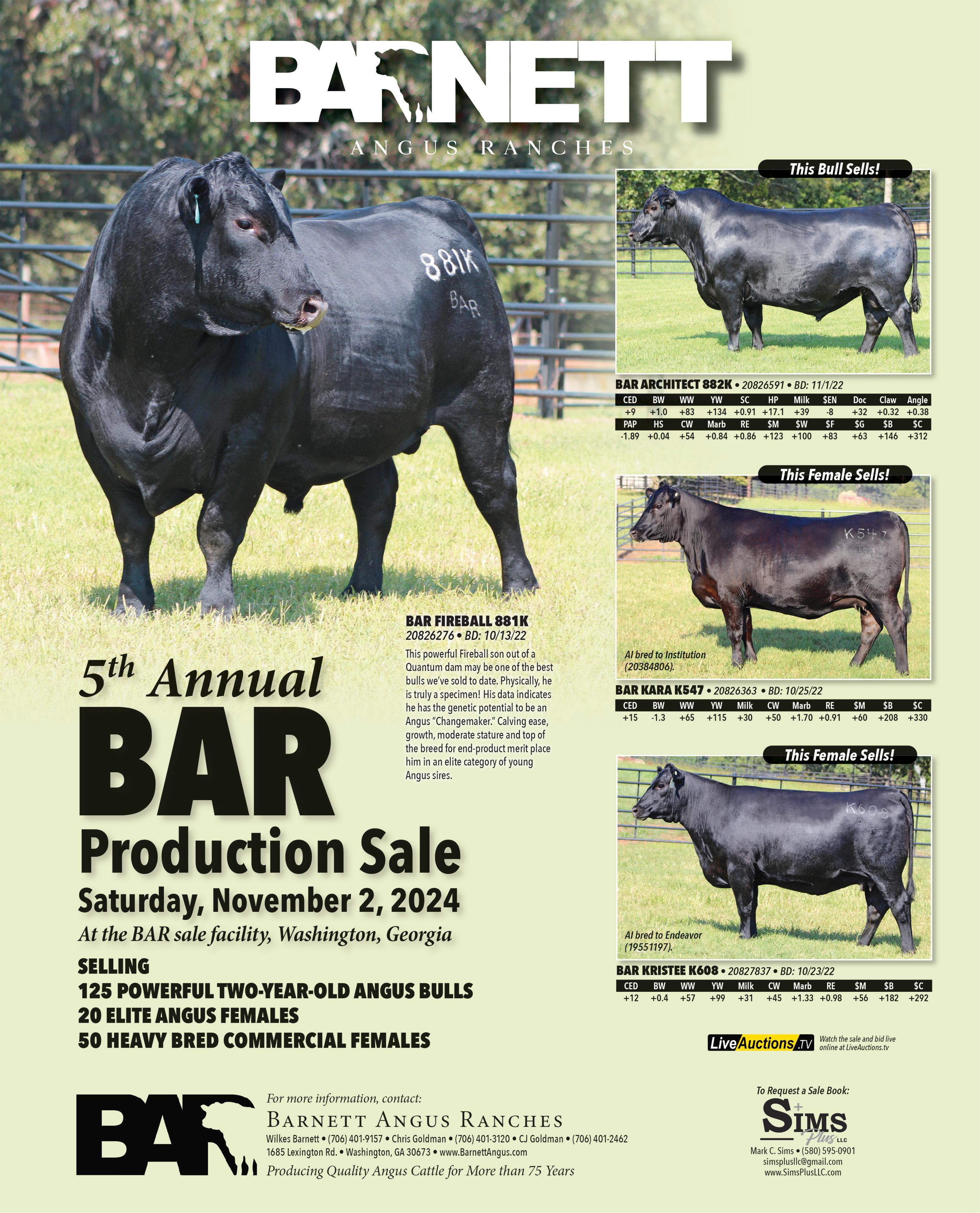


Redesigned Angus.org Creates Space for Commercial Cattlemen and Members. Visit the American Angus Association’s new web presence for more tools and resources. Sometimes websites get a refresh to modernize their look, and sometimes they are reorganized to make them more intuitive. Angus.org recently got a complete redesign to do both while becoming more of an industry wide resource.
The American Angus Association launched its newly retooled web presence to make the site easier to navigate and to become an even better place for members and commercial producers using Angus genetics.
“We have a very robust website, and we know that breeders know where to go to find what they need, but anybody who hasn’t navigated around it for years has a tougher time getting where they need to go,” says Holly Martin, director of communications for the American Angus Association.
She says the organization’s site was also overdue for a modernization of the design and better mobile optimization.
“Let’s start with what’s not changing: your ability to do business with the American Angus Association and some of the most highly trafficked parts of the website — including Login, EPD lookup, and sale books — will be exactly the same or look very similar,” Martin says.
“However, many of your favorite tools or ways to access news are in completely new places as we tried to make it all more intuitive for visitors.”
Clicking through the website, buttons for “find an animal,” “find a breeder” and Member Login, among others, are anchored in the upper right hand corner.
The main homepage gives visitors three main action points at the start: learn about Angus advantages, go to the commercial cattlemen’s corner, or head to the member center. Each section has links, news, and resources specifically curated for different types of Angus producers.
“We would like this to be everybody’s landing page. If you wake up with a cup of coffee or sit down to peruse the news in the evening, you’re going to www.Angus.org,” says Darrell Stevenson, a board director from White Sulphur Springs, Montana.
The main pages should refresh often with the latest articles and podcasts from the Angus Journal and Angus Beef Bulletin, along with other timely updates from the breed.
Both from the main navigation or other links on the homepage, users can quickly get to landing pages for each of the entities — Angus Foundation, Angus Genetics Inc. (AGI), Angus Media, and Certified Angus Beef (CAB) — along with major programs of interest, such as Angus Herd Improvement Records (AHIR) and Angus University.
“Each of these pages has its own personality and provides a spot to drill down as deep as you want to go,” Martin says. “In addition to the in-depth subnavigation, we’ve updated our search function to search more effectively.”
The Association’s first website launched in 1996 and has evolved many times since, but this is the biggest redesign to date.
“We had nice outreach to the breeder members, but our industry has evolved, and our family has gotten bigger,” Stevenson says, especially noting the focus on the commercial producer and programs such as AngusLinkSM that helps them market their calves and see value differentiation for investing in Angus.
The main navigation features six main sections, and commercial cattlemen might find these three especially helpful:
• Tools & Resources – This section brings together the National Cattle Evaluation resources, searches and calculators, and DNA testing information.
• News – Find easy ways to get to the Angus Journal , Angus Beef Bulletin, or Angus TV YouTube channel, or get all the latest news from every communication channel in one spot.
• Marketplace – For anyone doing business with the Association, all the needed pages are in one spot. All three of the stores (Angus Brand Store, Tag Store, and Angus Supply Store) are accessible from this page, along with sale books, sale reports, and the sale calendar.
The beef business is changing at a faster-than-ever rate, so the website is built with the ability to be flexible. As the year unfolds, the team will continue to add new functionality.
“It did not happen overnight. It’s been a multi-year project to improve

membership services and outreach, and I’m so proud of where we have landed,” Stevenson says.
Visit www.Angus.org to see the improvements and find resources.
Angus Means Business. The American Angus Association is the nation’s largest beef breed organization, serving nearly 22,000 members across the United States, Canada, and several other
countries. It’s home to an extensive breed registry that grows by more than 300,000 animals each year. The Association also provides programs and services to farmers, ranchers, and others who rely on Angus to produce quality genetics for the beef industry and quality beef for consumers. For more information about Angus cattle and the American Angus Association, visit www.angus.org


• 2-year-olds
- Forage developed - pasture hard and ready
• Crossbreeding at its best - Leading Simmental and Gelbvieh lines crossed with OCC Ohlde Angus
• Are powerful with predictable performance for both growth and calving ease sire groups
• Are moderate-framed, thick, deep bodied, and functional
• Will balance the economics of growth, carcass quality, and efficient production
• Are attractive, structurally correct, have gentle dispositions, and will produce super replacement females

Certified Angus Beef Takes the Field. Bringing the best beef to the Pro Football Hall of Fame Enshrinement Festival. Certified Angus Beef (CAB) showcased the best Angus beef at the Pro Football Hall of Fame Enshrinement Festival in Canton, Ohio. The first weekend of August saw CAB’s involvement in two key activations — the Enshrinees’ Gold Jacket Dinner and the Class of 2024 Unscripted & Tailgate.
A highlight of the week’s festivities was the presence of Virginia Angus rancher, past American Angus Association president, and CAB board member, Chuck Grove.
“The Angus farmers and ranchers across this country are responsible for providing the genetics that make Certified Angus Beef a reality,” he said during the event. “They’re at it 24/7, very much like any NFL player, committed to providing the best seedstock possible so we can provide worldwide consumers with the best beef.”
Grove’s son, Jake Grove, is a retired NFL center who played for the Oakland Raiders and Miami Dolphins, making the Hall of Fame festivities particularly meaningful.
“To make it to the Hall of Fame, they’re the crème de la crème,” he added. “We’re committed to providing you the best beef in the world, and that starts with the best Angus cattle.”
“I’m here representing the 20,000 Angus breeders and producers, family owned farmers and ranchers, from all over the United States,” Grove said during the Enshrinees’ Gold Jacket Dinner. “We provide a lot of energy, effort, and dedication to produce this product for you.”
At the Enshrinees’ Gold Jacket Dinner, CAB filet mignon was served
to more than 3,000 attendees, including some of the most respected names in football. The beef, sourced by Ohio distributor Blue Ribbon Meats, was a standout, earning praise from attendees and further elevating the brand’s reputation.
“The more we can get the label, logo, and information out to the consumer and let them try our product, there’s no question,” Grove said. “We’re really in the food business, and we’re supplying the cattle that make this product possible.”
The second major event, the Class of 2024 Unscripted & Tailgate, co-hosted by CAB and retail partner Giant Eagle, continued to highlight the best Angus beef with dishes like CAB shaved steak, kabobs, strip roast, and frankfurters served to 1,500 football fans.
“I know firsthand the dedication it takes to not only compete in the NFL, but to truly stand out and be enshrined into the Pro Football Hall of Fame,” Grove shared on the main stage for the Gold Jacket Dinner. “Your commitment to the game is not unlike the commitment it takes to raise the best beef you’ll enjoy tonight.”
Feeding Quality Forum: High Quality Beef Production Takes Focus. Certified Angus Beef conference brings producers, allied industry together. The world has changed, cattle have changed, and those managing them must keep up. The 19 th Annual Certified Angus Beef Feeding Quality Forum in Dodge City, Kan., gave 260 attendees tools and information to do just that.
For 17 years, the United States’ top trading partner was China, taking in $37 billion of U.S. agriculture goods every year. That’s not the case today, and it has rippling effects, said Dan Basse, Ag

Resource Company.
Farm revenue is down $69 billion, or 37 percent, since 2022.
Yet, the beef sector remains a bright spot. Cow/calf margins are estimated at more than $500 per head, and retail meat prices are at record highs. Since 2017, only 14 months have shown month-tomonth declines.
“Talk about demand; what a change, but a testament to everything that Certified Angus Beef in the industry is doing to get the consumer to pay higher prices over time,” Basse said.
Those who pay attention to all the details could reap additional rewards, said Paul Dykstra, CAB director for supply management and analysis.
“We are truly offering our customers to consumer a much better quality product today than we ever have before, and it’s responsible, I think, for that retail price increase trend,” he said.
Today, 22 percent of all fed cattle qualify for the Certified Angus Beef brand, but there’s still room for improvement. A full 10 percent of all Angus type cattle entering packing plants today miss the brand’s standards by just 30 degrees of marbling.
Shifting the grade makeup would add $46.94 per head to all cattle sold on a carcass basis versus the industry average, Dykstra said. Taking it a step further, improving the average marbling by 70 points would move the average to 20 percent USDA Prime and the premiums for the entire group to $65.74 per head.
The genetic effect – Cattlemen often ask, “But if I select for that much marbling, what will it do to my cow herd?”
For Randall Spare, veterinarian with the Ashland Veterinary Center, it’s not an either/or choice.
“We can have it all, people,” said Spare, who said he enjoys consulting with clients on matters beyond treatment protocols to enhance profitability.
“I would encourage you to think about the whole picture when we look at marbling,” he continued. Spare shared results from herds using genomic technology to help cut the bottom 20 percent and move the results of the whole population.
Conveying that investment in genetics to the next segment has historically been a challenge, but the feeder panel discussed ways they use that information today. Tom Fanning of Pratt Feeders, Grant Morgan of Pokey Feeders, and Troy Marshall, American Angus Association director of commercial industry relations, covered tools from genomic testing to the AngusLink Genetic Merit Scorecard that give feeders more
information about the cattle coming into their yards.
“If they’ve got great genetics, then what we can do is we can leave them there, or we can mess it up, and that last part gets really expensive,” Fanning said.
Marshall said the scorecard allows for that data flow without having to study pedigrees, making it more readily available to make decisions on.
“I think having the information to incorporate genetics into our management and marketing protocols is really the key to profitability,” he said.
Making use of data and technology – Yet, the key components of the profitability equation are different than they were decades ago.
Consulting nutritionist Pete Anderson, Midwest PMS, told the audience to rethink the way they calculate when to sell cattle. Regardless of whether the cattle are sold live or on a carcass basis, that carcass cost of gain (COG) is an important number.
“Very simply, profitability increases until the incremental cost of gain exceeds the sale price,” he said. “Yield grade premiums are nice, but they don’t drive your grid results. It’s all about quality.”
Justin Gleghorn of Cactus Feeders and A.J. Tarpoff of Kansas State University, talked technology — everything from growth to management types.
“We look for opportunities to utilize new technologies and put them into production as quickly as we can,” Gleghorn said. The Texas based cattle feeding company does extensive research with its own internal team on anything it’s about to implement.
“We can go out there and find opportunities to increase margins or capitalize on efficiencies. That gives us what, we believe, is buying power out there in the feeder market,” he said.
Packer perspective – Being competitive in the marketplace is top of mind for Chad Barker, National Beef Packing Company, as the packer looks to buy as many CAB and Prime producing cattle as possible.
To solidify its commitment to quality, National recently announced a $5 per head premium for all cattle that come into its plants with an AngusLink Genetic Merit Scorecard Beef Score of 100 or greater.
“I spend just as much time forecasting grade with our production scheduler as I do about anything because he’s putting availability out to all of our sales guys, and they’re trying to sell that product,” Barker said. Having more predictability in how those cattle will grade empowers those marketing it down
line.
Packers are also using more data on the evaluation side of the business, too.
A trio of experts — Abram Babcock of Adams Land & Cattle; Glen Dolezal of Cargill Protein; and Derek Vote, grading consultant — spoke on the evolutions in objective grading systems. They noted that all major packing plants in the U.S. are now using camera based grading, with oversight by the USDA.
“It’s extremely important that we get accurate, consistent data back from that because we use that information to purchase external cattle,” Babcock said. “What we see with the camera is a very consistent outcome; as far as that, it removes some of the subjectivity.”
Dale Woerner, Texas Tech University, explained the current yield grade (YG) equation and its limitations. Based on old data, today’s standard for predicting red meat yield misses the mark.
“Ribeye area alone only explains 3 percent of the total variation in true red meat yield coming from these carcasses,” Woerner said. “We have to begin to transition our mindset.”
He shared options currently in development to get 3-D imaging on carcasses. New technology that does a better job accurately assessing red meat yield is important as breeders think about making genetic change, he said.
The beef industry has a history of letting research help steer its course.
Bob Smith of Veterinary Research Consulting Services LLC, closed the program with improvements that the National Beef Quality Audit (NBQA) and Beef Quality Assurance (BQA) programs have stewarded through the decades.
“I view the Beef Quality Assurance program as not something that’s a single event,” Smith said.
Injection site lesions are almost a thing of the past, and the quality grade has skyrocketed to meet consumer demand. “It is an evolution, not necessarily a revolution, and it is a continual improvement through the years.”
To view presentations or for more information, visit www. FeedingQualityForum.com
The 2024 Feeding Quality Forum was sponsored by Alltech, AngusLink, the NCBA Cattlemen’s Education Series sponsored by the National Corn Growers Association, Diamond V, Drovers , FeedLot, High Plains Journal, National Beef, Rabo AgriFinance, Select Sires, and Selko.
Gain Real World Experience with CAB Internships. Certified Angus Beef seeks driven college students to support the brand’s marketing and communication efforts through its 2025
summer internship program. “Step out of your comfort zone.” “Accept the challenge.” “Ask for help.” As their summer at Certified Angus Beef came to an end, those are the words of advice the 2024 CAB interns gave.
Just as those interns did, current college students can gain real world experience on CAB’s communications and marketing teams next summer. Four internships, geared toward students pursuing careers in agriculture communications, marketing, and digital
media, are available for summer 2025: producer communications, multimedia, social media, and marketing. Applications are accepted through October 27.
For 10–12 weeks, interns are valued members of the team, supporting the organization in its communication and marketing efforts.
“We want our interns to get as much out of this experience as we do,” says Kylee Sellnow, senior content manager. “Our internship program offers intentional, individual feedback
with opportunities for the position to be tailored to their interests. From day one, we’ll provide interns with experiences that make them feel like integral parts of our team.”
Students who are strong communicators, detail oriented, and eager to learn should consider applying. Interns will work as valuable team
Continued on the next page

members, contributing to news stories, website content, social media posts, and photography and videography to further develop communication skills, build portfolios, and prepare for careers. The positions are based at the brand’s home office in Wooster, Ohio, with opportunities to travel for project work.
“The experiences and learning opportunities that Certified Angus Beef offers are unmatched,” says Katelyn Engel, 2024 producer communications summer intern.
“If you’re looking to gain more experience, this is an opportunity you want to have,” adds Kelley Chase, 2024 public relations and communications intern.
Depending on the focus area, interns will interact with all brand audiences, including ranchers, retail partners, chefs, and media contacts. Interns may travel across the country to gather video content, capture photos, and write feature stories highlighting farmers, ranchers, and brand ambassadors. The multimedia intern assists with photo and video shoots
and editing for campaigns. The marketing intern meets with brand partners and assembles promotional items for them to use in their retail or food services businesses.
Past work completed by CAB interns has been used on the brand’s social media, website, press releases, and featured at the brand’s annual conference.
“It’s motivating to see the passion that employees have for this brand and for the beef industry as a whole,” says Laney Reasner, 2024 sales and marketing summer intern.
The application requires a cover letter, résumé, and a link to an online portfolio showcasing work samples. Additionally, interns must answer open response questions specific to their area of interest. For more information, visit the www.CABcattle.com/internship
Certified Angus Beef Recognizes Research on Improving Beef Quality. West Texas A&M student receives the Dr. Bobby VanStavern Award for his research on post ribbing quality. Known as the “Father of the Brand Specifications,” Dr.

Bobby VanStavern was committed to improving beef quality. His legacy lives on in the Dr. Bobby VanStavern Award for Beef Quality Research. Established by Certified Angus Beef, the award was created to recognize outstanding student research dedicated to advancing beef quality.
The 2024 recipient is William Boyd for his research titled, “Instrumental Assessment of Marbling and Objective Color Post Ribbing.”
“Dr. VanStavern played a key role in establishing our brand,” said Daniel Clark, Ph.D., meat scientist at CAB. “In upholding our commitment to high quality beef, it is fitting that we recognize students whose research is both relevant and important for improving beef quality.”
Boyd is a graduate student at West Texas A&M University (WTAMU). His work explores how temperature and bloom time affect the instrumental assessment of marbling and muscle color in beef, offering valuable insights into enhancing beef grading accuracy and quality.
“Results from this assessment of marbling and objective color indicated that instrument assessed marbling scores are maximized immediately after ribbing due to maximum color contrast, Boyd said. “PVC film should be used as a tool for sustaining marbling scores for regarded carcasses.”
With lack of marbling the most common reason a carcass fails to qualify for CAB, the brand recognizes Boyd for his research aimed at improving accuracy and consistency in marbling scores.
Upon graduation, Boyd plans to pursue a career in the beef cattle or meat processing industry, with an intent to further improve the beef industry.
“Ever since beginning my educational journey at West Texas A&M University, I have developed a passion for meat science that has been fueled directly by my involvement through the American Meat Science Association,” Boyd said.
Also notable, two additional finalists for the VanStavern award completed research valuable to meat science. Andres Mendizabal, Ph.D. student at Texas Tech University, was a finalist for his research titled “Evaluation of Three Dimensional Imaging to Predict Beef Carcass and Primal Composition.” His research addresses how the USDA yield grade system can often misrepresent cattle value and offers 3-D imaging as a promising solution to getting more accurate readings, therefore improving
effectiveness, profitability, and sustainability.
Finalist Ryan Heitschmidt is an undergraduate studying animal science at WTAMU. His research, “Visualization of Percentage Intramuscular Fat and Association to USDA Marbling Scores in Beef Carcasses,” analyzed how global understanding and cooperation could be improved using a standardized technique to gather a precise percentage of intramuscular fat.
By completing applicable research, today’s students have the power to influence beef quality over the long term. Their findings provide valuable insights that can lead to more efficient and precise practices across the various stages of beef production — work worth recognizing.
Who is Certified Angus Beef? At Certified Angus Beef, we know people want to put great meals on the table. Our employees work across the beef supply chain to ensure chefs and home cooks find and prepare the best Angus beef. Led by our culinary, beef, and marketing experts, our team provides consultation, marketing materials, training, market insights, and tools that help businesses like grocery stores and restaurants thrive. Our team is also dedicated to sharing the story of family farmers and ranchers who supply the brand.

Y’all have stumbled on the best place to advertise expert A.I., superior genetics, the best in purebreds and outstanding farm supplies. Check the Classifieds in this issue!

By BARRY POLLARD American Angus Association
Dear Angus Breeders,
It was a productive week as the American Angus Association Board of Directors met on September 9-12 in St. Joseph, Missouri. Prior to this meeting, we had several virtual committee meetings. Each time we meet, I’m impressed with the innovation going on that will benefit our members and your commercial cattlemen customers.
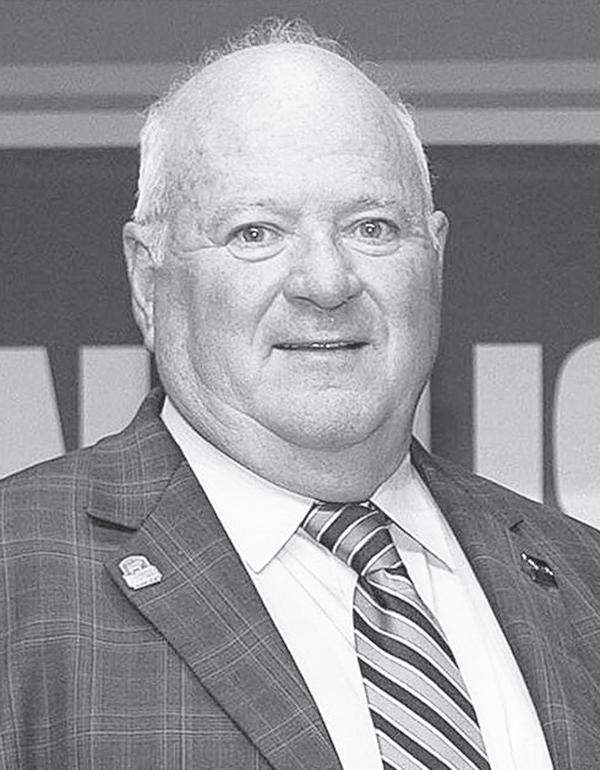
The Association remains in a solid financial position for FY2024. We passed balanced budgets for the next fiscal year for the Association and all entities, allowing us to maintain and expand programs and services. In particular, we remain mindful of investing in research to bring new tools to breeders. The Angus Media board also discussed adjusting policies for accounts receivable to balance member service with sound
business practices.
The delegate election process went very well this year, as members were able to vote online for the first time. There were 2,005 valid ballots cast, with 52 percent being electronic. The total number of votes was up 21 percent. We were encouraged by the increase in voting, heard positive feedback from the membership, and will continue with a similar system for next year.
Six candidates are running for five open seats on the board of directors this fall. Those members are: Paul Bennett of Virginia (2 nd term); John Dickinson of California (2 nd term); Greg McCurry of Kansas (2nd term); Loran Wilson of Indiana (2nd term); Dr. Mark Johnson of Oklahoma (1st term); and Danny Poss of Nebraska (1st term). The board elected Darrell Stevenson to be the treasurer for the coming year.
Tom McGinnis was elected to a second three year term as a member-atlarge of the Angus Foundation Board of Directors. Rob Shuey was elected as the industry representative to the Certified Angus Beef Board of Directors. Dr.
Mark Allan was elected as the industry representative to the Angus Genetics Inc. Board of Directors.
We heard about the launch of Angus. org . Membership feedback has been largely positive and productive, allowing the team to make improvements. A big advantage of the new site is that it brings several sites together under one umbrella, so we can share information across entities and departments. In addition, BEEF Academy was launched to National Junior Angus Association members during the National Junior Angus Show. The development of new topics and modules continues, and we expect to test them in classrooms this spring.
We know it’s important for members to maintain security measures on their AAA Login account. Consequently, the board discussed new measures allowing owners more visibility into transfers and recent logins on their account, along with annual security reminders.
As always, we’ve been working hard to ensure the latest and most relevant tools and research are available to

cattlemen. Members have been collecting teat and udder scores, enabling the launch of the teat size and udder suspension research EPD. A series of Maximizing Maternal virtual town hall meetings worked very well and allowed members to ask questions of staff. We are still on track to update $Maternal Weaned Calf Value ($M) in May of next year. The board also discussed the sunsetting of $Weaned Calf Value Index ($W). While $M contains more traits and is designed to be a more robust breeding tool, we know many breeders still use $W. We want to hear from the membership as we consider the future of these indexes.
We also heard about the significant work that is going into GeneMax, the only tool on the market that harnesses the power of the American Angus Association database to genetically evaluate high percentage commercial Angus females. Later this week, a newly calibrated GeneMax will be launched with a future launch that incorporates $Value indexes and new traits, including early summer hair shedding and pulmonary arterial
pressure genetic tools. GeneMax will also include a more insightful report for commercial cattlemen to directly connect their results and herd goals to their registered Angus bull purchase decisions.
AGI continues to be on the cutting edge of research. At the core of that research is data. Consequently, we are exploring non-traditional partnerships that will maximize AGI’s ability to lead genetic change within the beef industry.
Fertility haplotype research continues. In the coming weeks, AGI will begin a calf genotyping initiative where members can submit a DNA sample on calves born early or at term but do not survive. Watch the Member Center on Angus.org for more information.
AngusLink has had an impressive year, with an 86 percent increase in head enrolled over last year. At the same time, the number of bull transfers is up, signaling that the program is driving registered Angus bull purchases. The summer video sale season has been strong, with Angus Verified and GMS cattle selling at substantial premiums. Many
Association members are asking how they can help their customers learn more about the program. The staff is always ready to help and will be creating a toolkit of resources to help with your efforts.
Since December, the CAB board has been in support of the team in further investigating international production opportunities. This week, the board directed Certified Angus Beef to pursue next steps in licensing brand production in Uruguay. Strategically, this opens up access for the brand in the EU and other underpenetrated markets. A key requirement of this relationship is Certified Angus Beef product produced in Uruguay will not be allowed to be imported into the U.S. and Canada.
Responding to a member question, the DNA use policy was reviewed. No changes were made, but the topic will be revisited in November after staff research potential considerations and their implications. Also, a member question was addressed relative to the age of dam adjustment. After reviewing the data, the board was very confident in our current
calculations and took no action.
The National Junior Angus Association Board of Directors recommended we look at adding showmanship for junior and intermediate age exhibitors to the National Junior Angus Show, with the priority of protecting the tradition of the current National Junior Angus Showmanship competition. The Activities Committee voted to make this addition for 2025.
Like all board meetings, there were many other important topics addressed, including how we add value to an Association membership, the 2024 and future Angus Conventions, the great work of the Angus Foundation and our incredible youth programs, and so many other efforts to drive value for Angus cattle and our members. I hope you will listen to The Angus Conversation podcast, where we recap these topics and several others.
As always, if you have any questions or feedback on any of these topics, please don’t hesitate to contact your board of directors or me.



Red Angus Enhances Member Support with New Hire and Promotion. Red Angus is pleased to announce the hiring of Katie Scott as member services specialist and the promotion of Kaitlyn Fulmer to REDSPro and registry lead. Both Scott and Fulmer bring extensive experience in the agricultural industry, showcasing their commitment to Red Angus and dedication to member services.
Scott holds a bachelor’s degree in animal science from Colorado State University and has been active in numerous community organizations and events, including the National Western Stock Show. She brings a strong background in herd management, record keeping, and customer service to her role. As member services specialist, she’ll be responsible for assisting the registration department and shipping tags on behalf of the value added department.
“I’m excited for my new position at
the Red Angus Association,” said Scott. “I love helping producers with their needs and contributing to a great breed alongside a great team of people!”
Fulmer began her career with RAAA in 2022 upon graduating from Colorado State University with bachelor’s degrees in animal science and agricultural business. She’s consistently exceeded expectations in her role with the registration department, and this promotion recognizes her dedication and achievements over the past two years. Fulmer has served as an instrumental driver in enhancing member education, focusing the registration department on providing valuable resources and support to Red Angus members.
“Kaitlyn consistently shows leadership skills amongst her peers and is willing to go above and beyond,” said Halla Ramsey, RAAA executive assistant.
“She spearheaded the development of Red Angus Alley appointments, providing
personalized one-on-one engagement opportunities for members. Her dedication to continuous improvement has also led to researching other breed associations to identify best practices and explore opportunities to enhance the Red Angus registry experience.”
With the addition of Scott and the promotion of Fulmer, RAAA further solidifies its commitment to providing exceptional member services and driving continued growth for the breed. The organization is poised for continued success as it leverages the experience and dedication of its team to serve the needs
of its members and advance the Red Angus breed.
About the Red Angus Association of America. RAAA serves the beef industry by enhancing and promoting the measurable advantages of Red Angus and Red Angus influenced cattle. RAAA provides commercial producers with objectively described cattle by implementing new technologies and using scientifically sound principles that quantify traits of economic importance to beef producers in all segments of the beef industry. For more information, visit RedAngus.org


Cole Maness, President - scmaness3@gmail.com
Contact these RAAC members to learn more about Red Angus genetics and how they can fit into your herd.
HARDROCK BEEF CATTLE
Ronnie & Donna Holman
4613 Hickory Nut Ridge Road • Granite Falls, NC 828-302-8659 ronnie@hardrockbeefcattle.com
JK RED ANGUS
Jeff Banfield & Madison Adams 331 Tee Jay Farm Road • Aberdeen, NC 910-315-3821 jkredangus@gmail.com
LANGDON RED ANGUS & SIMMENTAL
John & Eileen Langdon 7728 Raleigh Road • Benson, NC 919-796-5010 johnlangdon5@gmail.com
ROGERS CATTLE COMPANY
Johnny & Sharon Rogers 945 Woodsdale Road • Roxboro, NC 336-504-7268 rccbeef@gmail.com
PRESNELL RED ANGUS
Jonathan & Jacob Presnell 368 Whitaker Road • Shelby, NC 704-473-2627 (Jonathan) • 704-616-8775 (Jacob)
BULL HILL RANCH
Jim & Alvina Meeks • Raymond Prescott, Manager 1986 Trinity Church Road • Gray Court, SC 864-981-2080 bullhill2@prtcnet.com • www.bullhillredangus.com
COUNTRY BOY FARMS
David Miller 316 Key Road • Edgefield, SC 706-840-3709
By DR. SHELBY ROBERTS Alltech
The weaning and receiving period can be a stressful time for both calves and producers. Having a plan beforehand is crucial to ensuring things go smoothly. Here are some tips to get off to a great start.
1. Prepare your facilities – Making sure that your facilities are in good shape for the arrival of weaned calves can help smooth the transition from pasture. Check waterers to confirm that they are working properly, and offer feed in locations that are easy for calves to find. Portable feed troughs and low moisture tubs can be placed along the fence line to help animals find feed quickly. Developing and increasing dry matter intake is key to maintaining health.
If weaning into larger dry lots, consider splitting lots with panels. This will minimize the need to commingle animals. The higher stocking density will help reduce pacing and keep pens moist, which will minimize dust. Dust can contribute to pneumonia, so keeping dust levels down is crucial. Additionally, ensure that the fencing is secure to prevent escapes and that there are adequate shelters or windbreaks to protect calves from harsh weather conditions.
2. Minimize stress – Stress is known to have negative impacts on health and performance. While stress can’t be completely eliminated, there are ways to minimize it through management.
One way is to vaccinate, deworm, dehorn, and castrate before weaning. These procedures can be stressful, and performing them well in advance of weaning allows calves to recover fully before the additional stress of separation from their mothers.
Also, commingle new cattle as little as possible. This reduces the spread of disease as well as the stress from determining pecking order. Low stress handling techniques, such as using calm and quiet methods when moving and working with
Letters to the editor are welcome and we appreciate your input.

HOWEVER, letters that are not signed will not be considered for publication.
cattle, can also help reduce stress.
3. Familiarize calves with feed –Getting newly received cattle on feed quickly is essential to maintaining their health. Calves are used to a diet of milk and forage while on pasture, so switching to the concentrated ration offered in the weaning pens can be difficult, involving differences in texture and nutrient digestibility.
Slowly transitioning calves to a concentrated diet while they are still alongside their mothers can help with the transition, minimizing digestive upsets associated with the higher starch concentration in weaning feeds. Providing high quality forage in the weaning pen is helpful as well. Also, if low moisture tubs are used on pasture, offering a stress tub in the weaning pen can help the calves transition more quickly.
4. Provide plentiful, fresh water – Water is one of the most overlooked nutrients. Fresh, clean water is essential for getting calves on feed as well as maintaining their health.
Some calves may never have used a water trough before. One trick that can help them adjust is to let the water continually run over for a brief period, helping the calves find it. Ensure that water sources are clean and accessible, as dirty or difficult-to-reach water can discourage calves from drinking. Providing multiple water sources also helps to ensure all calves have access to water, especially in larger groups. In colder weather, check that water troughs are kept ice-free, and in hot weather, provide additional shade to encourage water consumption.
Even with these plans in place, be sure to monitor water intake closely during the first few days after weaning, as dehydration can quickly lead to health issues.
5. Establish gut health – Gut health is critical to prevent calf health problems. Scours in calves are common during weaning and are a gut health issue. By fostering a healthy microbial population in the gut, Bio-Mos 2 offers a natural approach to improving animal growth performance and health, along with producer profitability, during this transition.
Monitoring calves for signs of digestive upset, such as diarrhea or reduced feed intake, can help identify issues early and allow for prompt intervention. Bio-Mos 2 can quickly and easily address calf scours by being added to a ration through various current supplementation methods, including
loose minerals, pellets, tubs/blocks, liquid supplements, or carrier packs.
Preparing facilities, minimizing stress, familiarizing calves with feed, providing fresh water, and focusing on
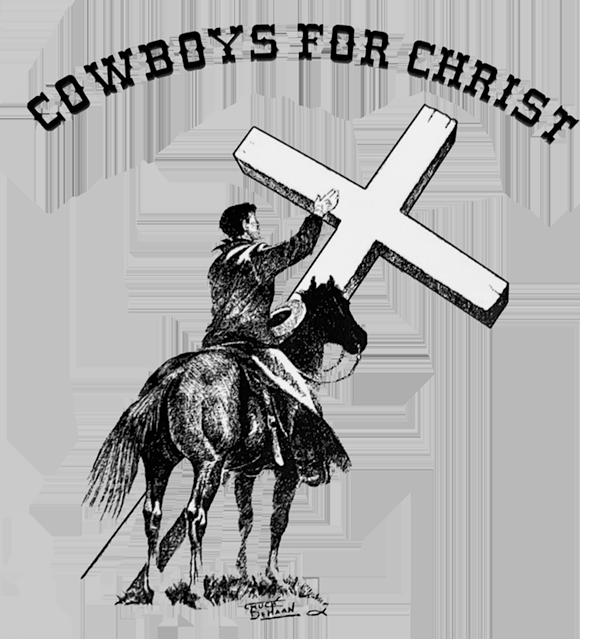
gut health are all key steps in smooth and successful weaning and receiving. Producers who have a solid transition plan in place can expect healthier, more productive animals in the long run.
By TAMMY BURTON Chaplain, Cowboys for Christ
We lost our old farm dog Mackey a while back. He had been here with us for almost 18 years. Looking back at pictures, he and I had aged equally over the years. He was the largest of his litter, a beautiful reddish brown color, and instantly my pick. He was a little cross eyed, but it just added to his character.
Mackey grew into an amazing watchdog. He kept the deer away from my treasured flower gardens, alerted us to anyone pulling into our driveway, and took care of any raccoons or opossums that tried to get into our feed or chicken houses. He was faithful to never wander or go to the road. He was nearly perfect. As he aged, his eyesight grew worse, and he started to lash out at anything that startled him. This became a problem because he started killing our chickens. My husband, always practical, was quick to remind me that there was no place on the farm for a chicken killing dog. I firmly stood in the gap for my dog and made a declaration that, “Nothing had better happen to him.” I came up with a solution to kennel Mackey throughout the day, while the chickens free ranged, and turn him out when the chickens went back into the chicken house in the evenings. This worked for many years. Most nights I would hear him “making his rounds,” warning all the unwanted critters with his weakening bark, to stay away. My flowers continued to flourish, and all was peaceful on the farm. Eventually, he was no longer a threat to the chickens and was left to
roam the farm 24/7, often laying in the sun with them resting close by.
How does this fit into a devotion or an example of how the Lord sees us, or uses us? You see, I have things in my past that I am not proud of. I walked away from what I learned about the Lord as a child. I have made a lot of mistakes. Several years ago, the Lord called me into his service, and I became a cowgirl chaplain. I questioned my self worth and how the Lord could use someone like me. One sunny afternoon, I walked around the front of the house, admiring my flowers that had never fallen victim to the deer, and saw Mackey sitting in the sunshine, like he was pondering. I reached down and patted his head and said, “You have served me well, ole boy.” At that exact moment, the Holy Spirit came flooding into my soul, and I looked up and said, “Lord! I get it! You used my dog to show me an example of your grace and your forgiveness, and how you can use me despite my past shortcomings!”
Psalm 103:12 – “As far as the East is from the West, so far, he hath removed our transgressions from us.” He sees our worth through all the bad — he doesn’t give up on us! Daniel 9:9 – “The Lord God is merciful and forgiving, even though we have rebelled against him.” Thank you, Lord, for all the wonderful years I had with my dog, and thank you for allowing me to serve you despite my mistakes. “Use me, Lord, all of me, and Lord, send me another Mackey.”
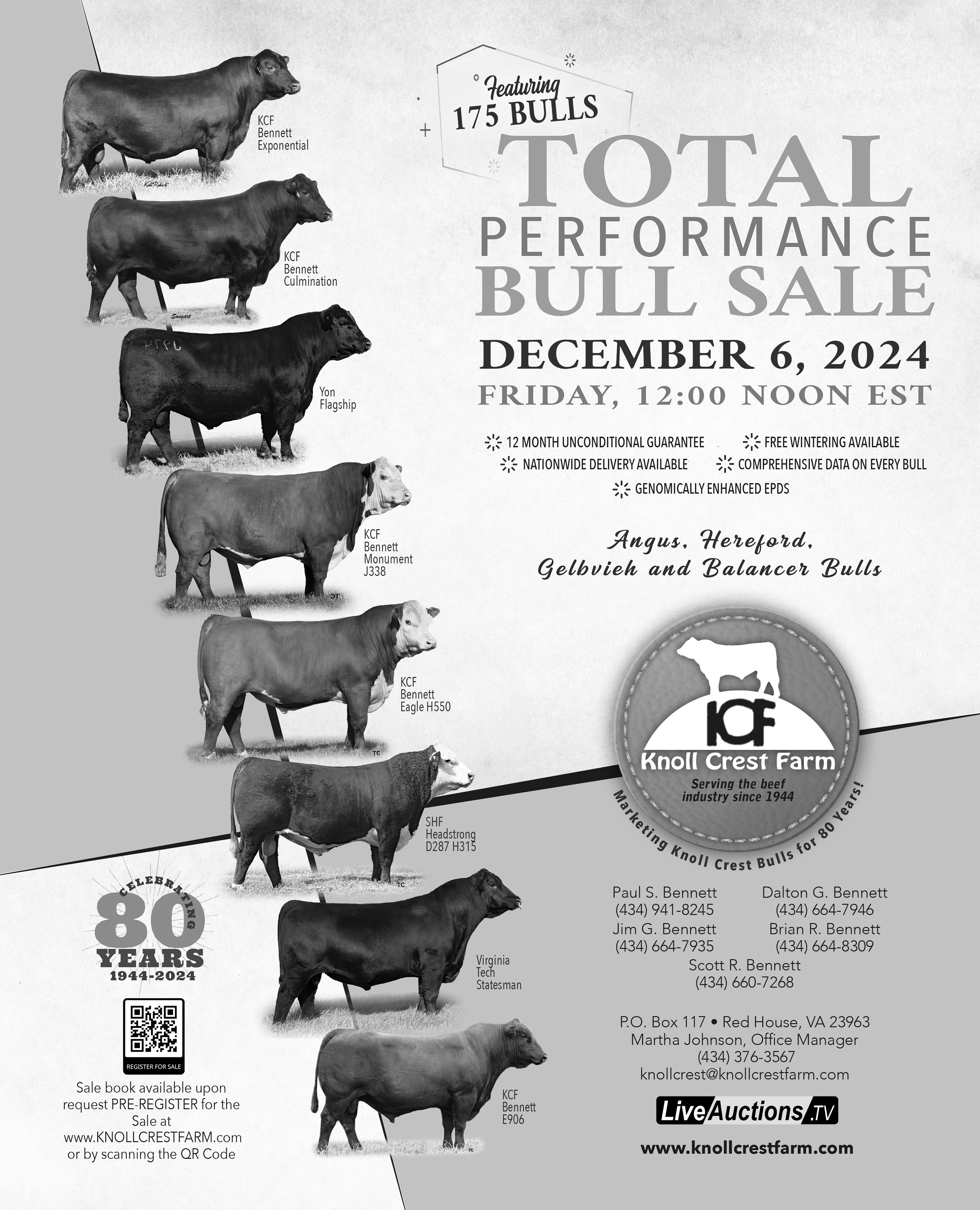

4B FARMS, LLC
Shelby, NC
Bryson Westbrook Ed Soto (Manager) 980-230-4868 - Bryson 704-974-1407 - Ed brysonw@thewestbrookco.com
BLINSON POLLED HEREFORDS
Lenoir, NC
Keith & Peggy Blinson - 828-310-4526 Bryan & Beth Blinson - 919-422-9108
DOUBLE J FARM
Traphill, NC • Earlysville, VA John Wheeler 910-489-0024 doublejfarmllc@yahoo.com www.doublejfarmllc.com
E. CARROLL JOYNER
BEEF UNIT
Raleigh, NC
Matt Morrison 716-720-0227
FIVE J’S BEEF & CATTLE COMPANY
Clayton, NC
Jody & Angela Standley
919-291-4212 - Jody (cattle) 919-291-5689 - Angela (beef) jodystandley@gmail.com

HEREFORD HILLS
Greensboro, NC
Bill Kirkman III 336-382-9635
ST Genetics Representative
McCOY CATTLE FARM
Cove City, NC
Myron & Charlie McCoy 252-229-4602
mccoycattlefarms@gmail.com
MITCHEM’S FARM 3C
Vale, NC
Wayne, Crystal, Regan & Jordan Mitchem 704-472-4369 mitchemsfarm@bellsouth.net
NORTH PINO
LAND & CATTLE COMPANY
Mocksville, NC
Kevin Robinson 336-399-9884 kevrob1@aol.com
LOVE FARMS
Blowing Rock, NC Jim Love 828-266-1458 cell • 828-295-4236
P and J FARMS
Monroe, NC
Andy Smith 704-400-3436 pandjfarmsherefords@gmail.com

PRESTWOOD BEEF CATTLE
Lenoir, NC
Kim & Lori Prestwood 828-320-7317 - Kim 828-432-7434 - Lori brownloriclyde@yahoo
QUAIL RIDGE FARM
Rutherfordton, NC
Mark Brewer 828-329-2074 markbrewer65@gmail.com
TAYLOR’S MILL FARM
Zebulon, NC J. Brent Creech 919-801-7561 tmfherefords@icloud.com
TERRACE FARM
Lexington, NC
Jim, Linda & Chad Davis 336-247-1554 jgdavis101@yahoo.com
TRIPLETT POLLED HEREFORDS
Statesville, NC
James Triplett 704-902-2250 triplettmarble@bellsouth.net
W&A HEREFORD FARM
Providence, NC
George, Tammy, William, & Andy Ward 434-251-3637 gwwardjr@comcast.net
WHITEHEAD
CATTLE COMPANY
Lewiston Woodville, NC Austin & Jodie Whitehead Austin - 252-370-5647 Jodie - 252-642-3435 austinlwhitehead@yahoo.com
WILL-VIA POLLED HEREFORDS Mooresville NC Lavette Teeter 704-662-5262
The day commercial producers sell their feeder calves is quite possibly the most important day of the year. A large percentage of their annual income is on the line. Everything needs to be right. Hopefully, the market is strong, and the marketing venue as well as the agent you selected for the job have worked hard to connect with potential buyers.
There are many things to think about when preparing for this important event. Has the producer provided all relevant positive information that accurately reflects the attributes of his or her calves? For instance, has detailed information about the calves’ vaccination program been provided? Buyers like to know and regularly pay more for weaned and vaccinated calves.
The next important question pertains to genetics. Do the calves’ genetics rank as poor, average, or at the top of the bell curve? The truth is, most commercial producers don’t know where their genetics rank. So, they market their calves
without objective genetic information.
A “missed opportunity” might best describe feeder calves sold without genetic information, and millions are sold this way each year. Buyers struggle because they have no way to assess the calves’ potential for growth and carcass traits. Your feeder calves may be some of the best around, but without objectively determined genetic information accompanying them into the marketplace, no one will know. Furthermore, genetics are important, determining 35-40 percent of performance and financial outcomes in the feedlot and on the rail.
That brings us to the question asked in the title of this article. Most producers don’t even consider using genetic information as a marketing tool — but they should. If your genetics are above industry average for growth and carcass potential, you have a favorable story to tell. Buyers will reward you by paying more for your calves.
The first step is to determine where
your genetics rank. There are two ways to make this determination: summarize seven to ten years of EPD history on the bulls you’ve used in your herd, or test some of your cattle with a commercial DNA test like Igenity Beef. Either method is suitable for finding where you rank on the industry bell curve. You might discover your genetics are above average, or you may find that improvements are needed by investing in bulls with higher genetic merit.
Here’s the ideal situation: With help from a third party, you discover the genetics in your latest calf crop rank in the top 35 percent of the industry for post weaning traits. Objective data has been used in making this assessment, removing guesswork and ambiguity. You now have information worth sharing with prospective buyers. It could be as simple as including a statement like, “This group of feeder calves has been objectively verified to rank in the top 35 percent of the industry for growth and carcass genetics.”
As they read the sales description, buyers understand your cattle have above average genetics for traits that affect their bottom line. You have added value to your cattle by communicating your genetics to prospective buyers. Buyers will tend to react favorably to this message and, in most cases, bid more aggressively. Your genetics are now working for you on sale day instead of just sitting in the background.
Final note: This article outlines two steps a commercial cow/calf producer may take to ensure their genetics work favorably on sale day. The first step is discovering how your herd’s genetics measure up. If those genetics rank above average, add this message to the sale description of your feeder calves, allowing buyers to assess their value more effectively. If the discovery portion of this exercise reveals below average genetics in your herd, take action to improve your genetics before publicly sharing the information when marketing your calves.
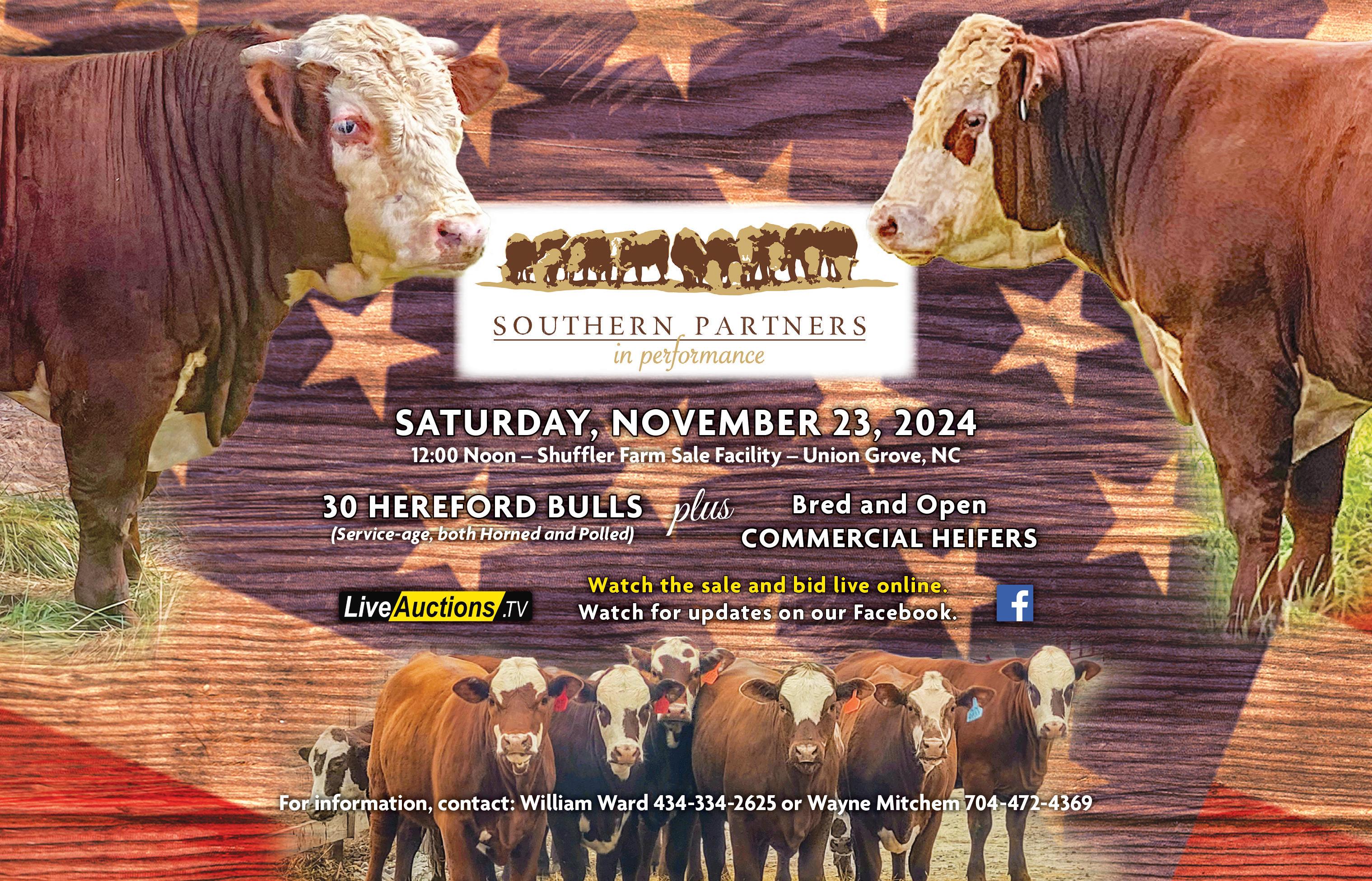




When discussing loose mineral, the most frequent question I get on my travels across the south-central United States is, “What’s your best cow mineral?” This is a somewhat loaded question because everyone has their own definition of “best.” To some, “best” may mean whichever mineral has the most additives on the label; to others, “best” may mean whichever is the cheapest. An all-toocommon approach to deciding which mineral is “best” is comparing two tags side by side, and whichever tag is higher in this ingredient or that is deemed “better.” To me, all of these definitions of “best” are limited by too much focus on one single component.
Producers want a mineral program that offers the most valuable combination of nutrition and price in relation to the goals of their operation. They want multiple pieces of a mineral program to come together in an optimal package. But identifying that sweet spot is not easy because every cow/calf operation has unique goals. In a perfect world, every ranch, no matter how big or small, would regularly test its soil, forage, and water to formulate the exact mineral program needed for their situation, and then the formula would have to change about three times a year based on forage quality. Unfortunately, this is not realistic,
nor is it possible for feed companies to manufacture an endless number of mineral formulas. What is practical is identifying appropriate ranges of inclusion levels that will meet most of the needs of cattle on pasture year-round and formulating a mineral line that falls within those ranges. From there, the key is consistent feeding. This practicality and simplicity make up the concept behind the SWEETLIX Classic Cow/Calf Mineral line.
The SWEETLIX Classic Cow/Calf Mineral line comprises six different products that cover almost all the mineral nutrition needs of cattle on pasture at any time of the year when fed consistently. The entire line revolves around a core formulation of 12–14 percent calcium, 6 percent phosphorus, 14–16 percent salt, and 1 percent magnesium that is fortified at 150 percent NRC for trace minerals and vitamins and includes Sel-plex organic selenium. These levels were all selected to offer the optimal nutrition level at an affordable price. Building off our core formula, we include the most common seasonal additives in the lineup to, again, meet almost any producer’s needs. These options include:
• ClariFly
• CTC 6000
• ClariFly and CTC 6000
• Garlium

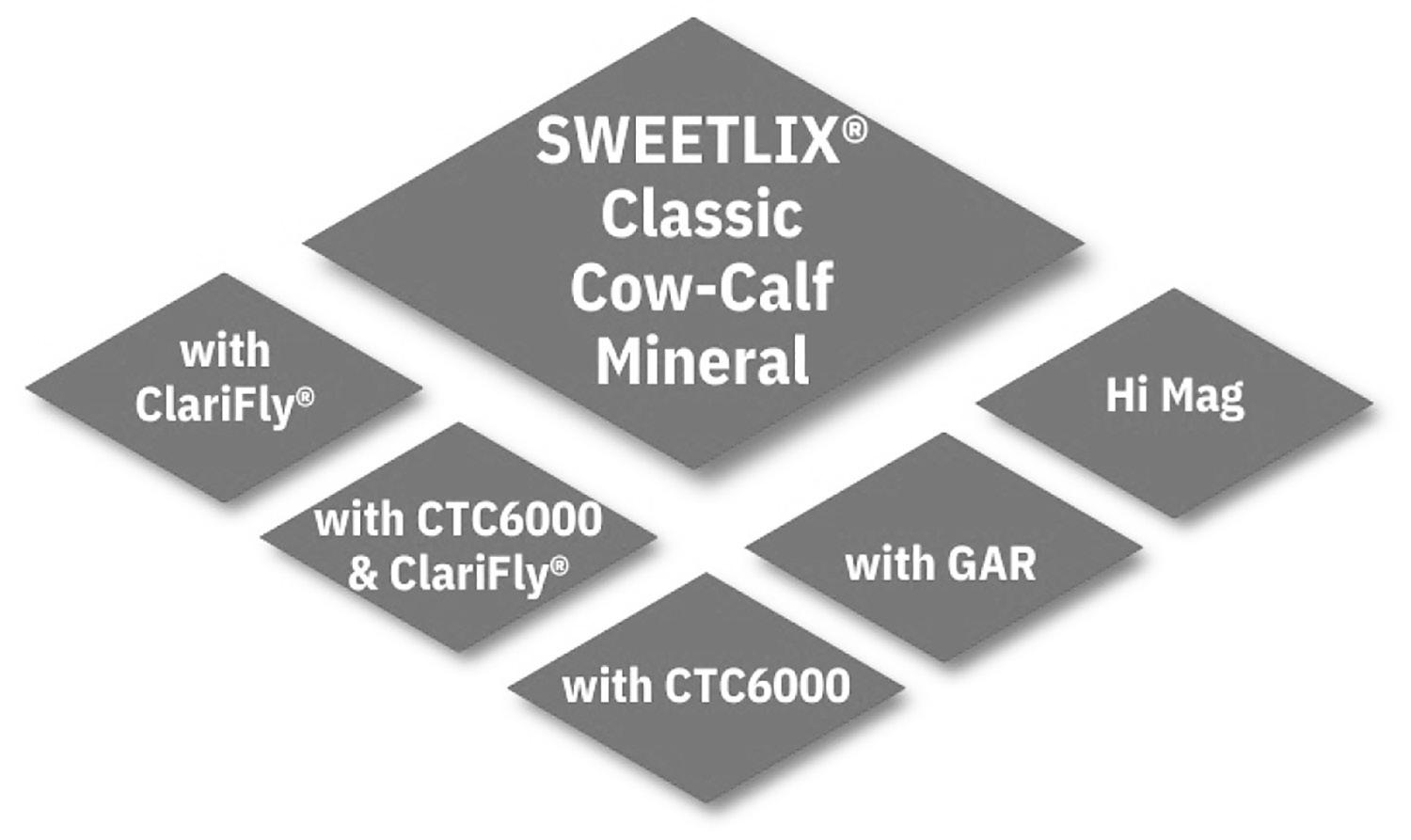
We have also recently added a SWEETLIX Classic Cow/Calf High Mag Mineral to help prevent grass tetany in rapidly growing forages. It is the only mineral in the lineup with slightly different fortification levels. The magnesium is higher at 10 percent rather than 1 percent, and the phosphorus is dropped from 6 percent to 3 percent. The SWEETLIX Classic Cow/Calf Mineral line, along with all other SWEETLIX minerals, is also completely weatherized with our Rainbloc technology.
The most common question I get about the SWEETLIX Classic Cow/ Calf Mineral line is, “How can you keep the mineral fortification levels the same (primarily calcium and phosphorus) and still meet the varying nutritional needs of cattle on different quality levels of forage?” This is a fair question, and I always have the same answer — consistency.
There is no doubt that phosphorus and other nutrient levels in low quality hay are much different from those in good summer grass. But is upping the phosphorus from a 6 percent spring/ summer mineral to an 8 percent winter mineral at a 4 oz. consumption going to dramatically alter the phosphorus reserves of your cattle? I would argue probably not, as it delivers less than 2.5 additional grams of phosphorus daily.
What could change the phosphorus

reserves of your cattle is a scenario that we have all experienced. Say your mineral supplier does not have the higher phosphorus winter mineral in stock, so you decide to wait until it comes in. But you get caught up with other aspects of life, and, next thing you know, days turn into weeks, weeks turn into a month, and now it has been 45 days since you put out minerals. It was not intentional, but it happens more frequently than any of us would like to admit. The simplicity of the SWEETLIX Classic Cow/Calf Mineral line makes applying nutrition easier, and when things are easier, they are more likely to be done. So, consistency is key.
The SWEETLIX Classic Cow/Calf Mineral Line is not a silver bullet when it comes to mineral nutrition. There are still outlying circumstances where higher or lower levels of certain nutrients are not just warranted, but also needed. That is exactly why SWEETLIX has other beef cow mineral formulas. However, the mineral business has become so complex, with endless formulations for every scenario under the sun, that it has become entirely too complicated for producers, retailers, and even feed companies. The introduction of the SWEETLIX Classic Cow/Calf Mineral line streamlines mineral nutrition for everyone and makes the question, “What’s your best cow mineral?” a little easier to answer.
$400 - Open Rate
$375* - 6 Ads Annually
$320* - 12 Ads Annually *per month
$575 - Open Rate
$530* - 6 Ads Annually
$460* - 12 Ads Annually *per month
$225 - Open Rate
$200* - 6 Ads Annually
$180* - 12 Ads Annually *per month
$200 - Open Rate
$185* - 6 Ads Annually
$160* - 12 Ads Annually *per month




to the North American Limousin Foundation’s Terminal Index. As you may recall, the North American Limousin Foundation released its Terminal Index last February, which is built utilizing iGENDEC. Recently, at its summer board meeting, the NALF board of directors approved an adjustment to the Terminal Index which increases the emphasis on dry matter conversion rates by incorporating weaning to yearling weight spread for cattle (YW-WW weighted by a marginal economic value of $.277).
YW and WW were removed from the current updated version of NALF’s TI. By incorporating gain spread from WW to YW, correlations for both weight traits have increased by nearly double and better reflect the value of dry matter conversion in today’s competitive cattle feeding business as it relates to feed efficiency and cattle that have superior cost of gains.
iGENDEC is a web based tool to enable the construction of economically
optimal selection indexes. iGENDEC allows for index customization through the adjustment of economic and production parameters to reflect actual historical price data and is made available via the Beef Improvement Federation.
The new Terminal Index (TI) has been constructed to identify sires that produce the highest profit potential fed cattle. The new index was created using the most recent 10 years of USDA reported fed cattle and grid pricing data, K-State reported feedlot cattle performance, and NALF data. The bioeconomic index represents a leap forward in selection technology and was developed using the iGENDEC platform. The new TI index models the use of Limousin sires on Angus based cows will all calves marketed on a value based carcass grid. The units reported represent expected differences in profit per mating.
Below are the EPD traits and Marginal Economic Values used in the updated NALF Terminal Index.
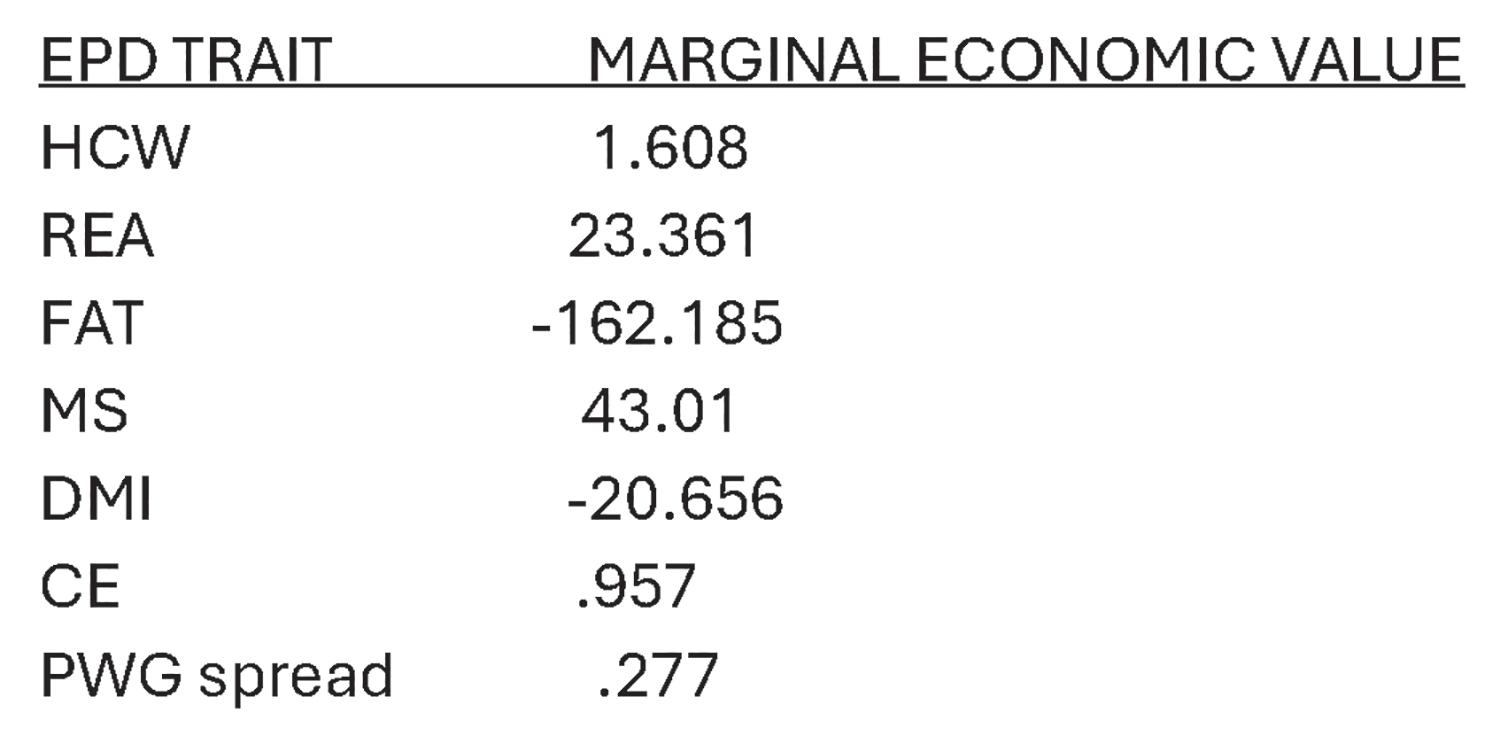
The marginal values, determined by parameters in the iGENDEC program, are simply multiplied by each EPD trait and then added up for a total $ index value on each animal in the herdbook. The range seen on NALF’s 4,500 active sires reflects a high of $210.00 and a low of -$16.00, with a mean of $94.00. You will be able to query and look up cattle by classification in the NALF DigitalBeef system, similar to other EPDs.
It is important to remember that the Terminal Index is specifically designed for terminal sires that excel in feeding performance and carcass characteristics on an economically relevant basis. It utilizes actual historical price data and is much more reflective of today’s current fed cattle market and feeding performance requirements in the fed cattle industry.

About the North American Limousin Foundation. The North American Limousin Foundation, headquartered in Englewood, Colo., provides programs and services, including the documentation of more than 25,000 head of cattle annually, for

Hubbard Feeds introduces Recharge, a new product line for beef cattle. Hubbard Feeds, an Alltech company, has introduced Recharge, an innovative solution for beef cattle designed to optimize intake, enhance performance, and increase profitability. Recharge utilizes advanced nutritional technologies that promote cattle well being and support performance during challenging periods. This product helps cattle cope with stress, contributing to their overall vitality and productivity. Recharge provides a proactive approach to herd management, focusing on holistic nutrition strategies for cattle wellness.
approximately 4,000 members and their commercial customers. The Limousin breed and Lim-Flex hybrid offer industry leading growth and efficiency while being an ideal complement to British breeds. For more information about NALF, please visit www.nalf.org
“We fed the Recharge pellet to approximately 300 head of calves, and the intake increase was significant in just a three to four day period. We saw fewer sick calves, and it helped to even out intakes,” said Recharge customer Steve Beeson of Dante, South Dakota. “The 0.5 pound inclusion rate was very simple. Calves are more active and ready to eat. Even when the weather fluctuated, they stayed at a consistent feed intake. Buy it; it works.”
To learn more about the Recharge product line, visit www.hubbardfeeds. com/brand/recharge
While NALF’s older Mainstream Terminal Index (MTI) has served us well the last 20 years, it is based off older carcass price spreads and yield grade premiums that have changed dramatically in the last 20 years in the commercial cattle business. The iGENDEC software is a leap forward for index development that lets us keep up with actual market pricing structures and feed cost in an ever changing formula and grid marketing base system.
The NALF board will look to sunset the MTI index in the near future as we move forward. The board has also approved moving forward with the development of a maternal index for females once IGS has finished and released the Mature Cow Weight EPD for all IGS cooperators.
The line of products includes:
• Recharge 0.5 Pellet
• Recharge Micro 6g Premix
• Recharge Drench
• Recharge Block
“Recharge uses unique nutritional technologies to enhance cattle health. Keeping cattle healthy is the key to optimizing intakes, performance, and ultimately profitability,” said Dr. Mark Klemesrud, ruminant nutritionist at Hubbard Feeds. “Feeding Recharge to cattle during stress events can enhance health and improve feed intakes and performance.”
Feedlot results have shown:
• Optimizes dry matter intake
• Improved ADG and Feed Efficiency
• Higher % cattle qualifying for drug free program
About Hubbard Feeds. Part of the Alltech family of companies since 2015 and in About Hubbard Feeds. As part of the Alltech family of companies since 2015 and in business since 1878, Hubbard Feeds has a long history of providing research based nutrition products and innovative support services. We are driven to provide our customers with products and answers that will improve their profitability, increase their competitive advantage, reduce their risk, and simplify their lives.
Through improved nutrition and continuous scientific innovation, we are committed to improving the value and quality of feedstuffs, providing a nutritional platform for animals to achieve their inherent genetic potential, and, ultimately, supporting producers as they deliver more plentiful, safe, and nutritious food for us all.
By LAURENTIA van RENSBURG Alltech
When working to maximize fertility in cattle, cows are often the focus. However, bull fertility is a crucial consideration for any beef operation. Not only do bulls contribute to the genetic improvement of the herd, but bulls with poor fertility — or any characteristic that affects their ability to breed — can significantly reduce the pregnancy and weaning percentage of the cow herd, lowering productivity and profitability.
Many factors, including management, genetics, and even nutrition, can impact both female and male fertility. The nutritional status of the bull, and even the nutritional status of his dam during her gestation with him, have been linked to the calf’s gains, age of puberty attainment, and even semen quality.
How trace minerals boost fertility – While proper energy and protein supplementation are key, the importance of trace minerals cannot be underestimated. These essential nutrients, including zinc (Zn), manganese (Mn), copper (Cu), and selenium (Se), are known to be involved in hormone secretion and synthesis, and they are needed for the normal functioning of the hypothalamus-pituitary-gonadal axis.
Trace minerals to support both cows and bulls – In areas where known
trace mineral deficiencies exist, especially in regards to zinc, manganese, copper, and selenium, supplementation with organic trace minerals (such as Alltech’s selenium yeast technology, Sel-Plex, as well as its Bioplex Cu, Mn, and Zn) can be advantageous. Organic trace minerals, as opposed to commonly used inorganic types, are more bioavailable and thus better utilized by the animal. This is less wasteful and more efficient, and it helps to prevent harmful excretions of unused minerals into the environment.
Reported improvements in reproductive efficiency with organic trace minerals have included higher pregnancy rates and weaning percentages, fewer open days, and earlier puberty attainment. While trace mineral requirements are often higher than maintenance needs for optimized health and fertility, and while the 2000 edition of the NRC defines these requirements clearly for gestating and early lactation cows as well as for growing and finishing cattle, no specific requirements are listed in the NRC for bulls. Given the importance of trace minerals, however, especially in relation to hormone synthesis and spermatogenesis, trace mineral supplementation should be a key part of

bull management even well before the onset of breeding season. For example, it takes approximately 60 days for new sperm to be produced and to mature; therefore, proper supplementation prior to bull turnout is key.
Bull fertility starts in utero – Trace minerals can also have an impact on fetal development and programming. One published beef study looked at the selenium form (inorganic selenium vs. Sel-Plex) fed to cows during gestation, examining how these two selenium sources affected transcriptome profiles in neonatal calf testes. The authors reported that the selenium form fed to the dam affected the expression of 853 annotated genes, including several mRNAs involved
in the regulation of steroidogenesis and/ or spermatogenesis. This indicates that the form of selenium fed to the dam could impact the eventual fertility of her offspring.
In conclusion, the development of fertility in both heifers and bulls can be strongly affected by nutrition, starting in utero. Ensuring proper nutrition for the entire herd, not just the cows, is essential for a successful and profitable breeding season. Even small changes in overall nutrition, such as the inclusion of organic trace minerals such as Bioplex and SelPlex, can pay huge dividends, not only for the immediate calving season but over the productive lifespan of replacement heifers and bulls as well.
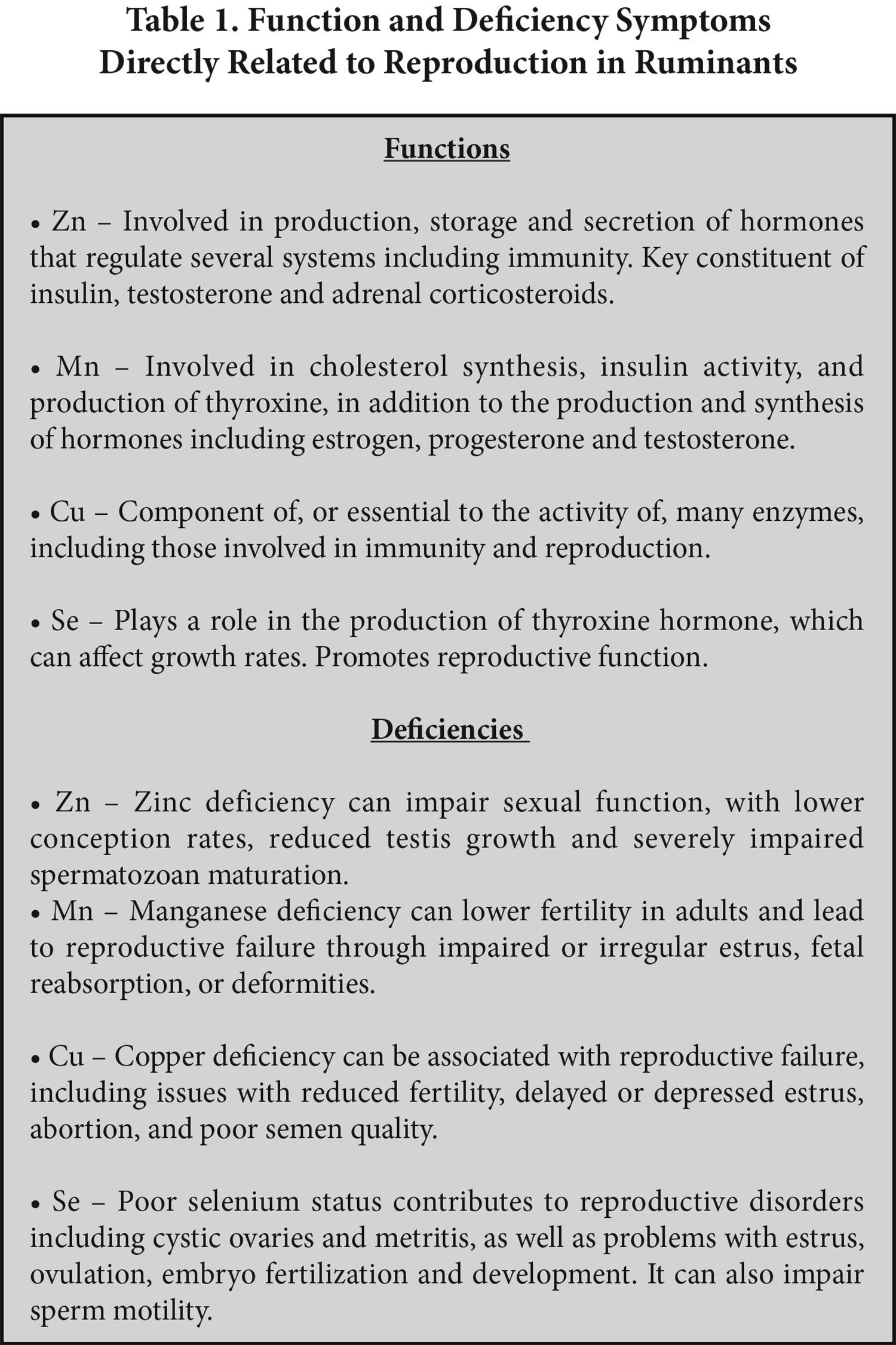
By GEORGEANNE WEBB S.C. Charolais Association
I have some sad news to report this month. My good friend Sue Hecht went to be with Jesus on September 7. If you ever met her, you automatically became good friends. I had a great time chatting and laughing with her in Kansas City at the meetings and at the Sale of Excellence in Texas. She and Harlan were always a lot of fun to be around. Please keep Harlan and their sons in your prayers because I feel Harlan will have a hard time without her. They were always together, and if you saw one, the other was nearby. They enjoyed sales and cattle shows. Sue was watching her three granddaughters show their cattle at the Minnesota State Fair when she became ill. She loved junior shows. The Charolais folks will greatly miss her.
I met our new field representative, Isaac Hughes, when he came to the house with Dennis Adams. If you haven’t met

him, you need to come to the sale on October 5 in Knoxville to meet him. He is an awfully nice young man and has a great knowledge of cattle. If you know me, you know I am not easily impressed, but I was really impressed with him.
Not much is going on with anybody except trying to survive the drought here, weaning spring calves, and fall calves hitting the ground. I moved the herd to a different pasture, and within four days I had three new calves. It seems like every time I go check on the herd, there is a new calf. I don’t know whether to brag about my fertile females or my hardworking bull. I wean spring calves, and all of a sudden, I have a pasture full of fall calves. Oh well, I guess if you sit down, you die, so I will keep on doing the things that make me so tired.
Check on your neighbors, and keep updating your prayer list.

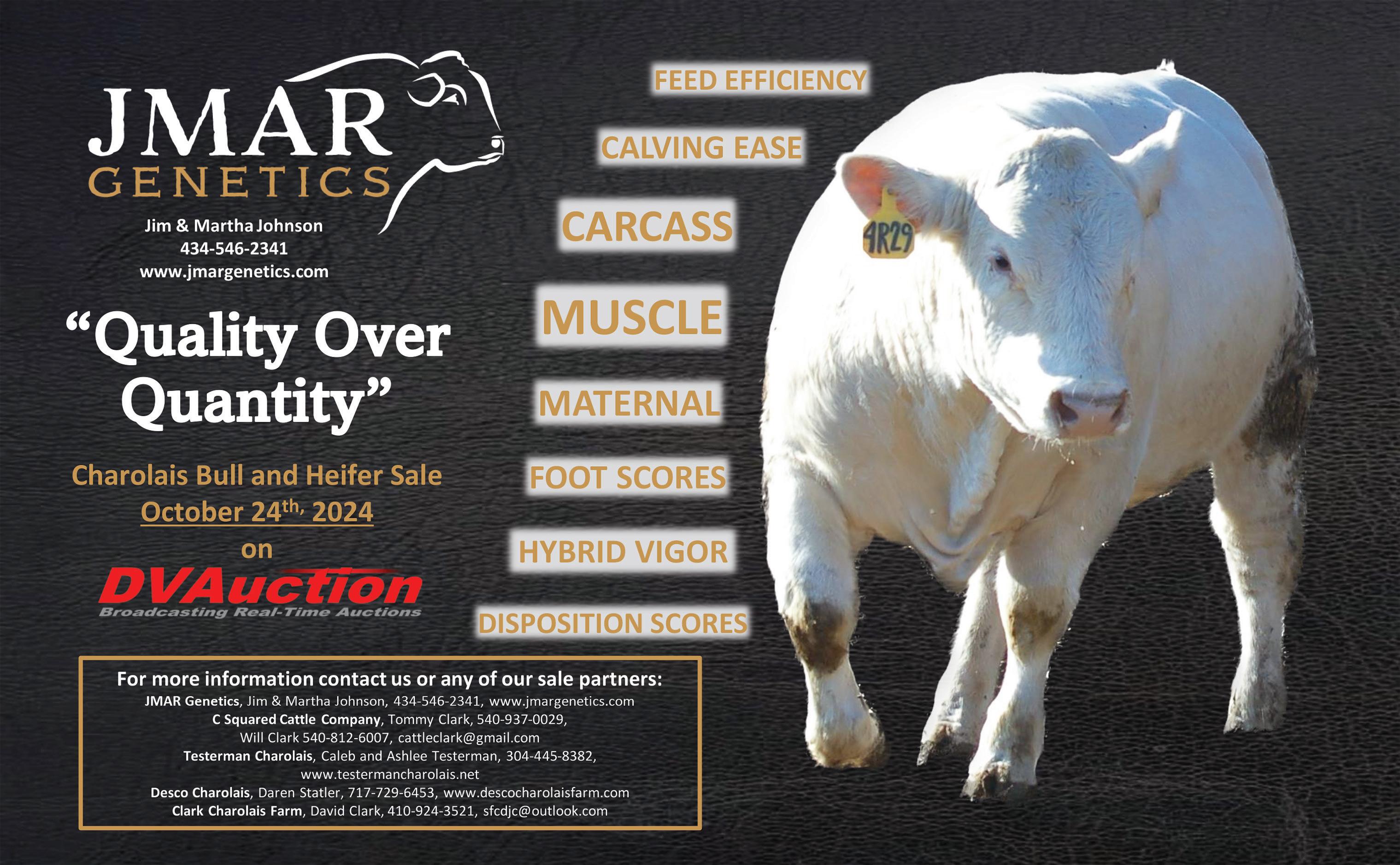



Apply for NIAA’s Leadership Program. The application period is open for the fourth cohort of NIAA’s leadership program. The National Institute for Animal Agriculture (NIAA) has begun accepting nominations and applications for the fourth cohort of the Advanced Training for Animal Agriculture Leaders. Applications and nominations are due November 17 at 11:59 p.m.
The 16 month leadership program blends in-person and virtual working sessions to focus on four areas of development: critical thinking, leadership development, connecting and relating skills, and operational excellence. Members of the program work together on applied earning, small group capstone projects that will incorporate topics of interest in animal agriculture.
“Through NIAA’s Advanced Training for Animal Agriculture Leaders program, I have gained an interdisciplinary group
of colleagues that are equally passionate about agriculture and using science to further our industry,” said Hanna Robbins, Butterball and member of Cohort 3.
Since its inception in 2021, the program has represented a wide range of agricultural sectors and provided opportunities to gain next level leadership and professional development training specifically focused on animal agriculture. The program empowers professionals in the early to midpoint of their careers to build on previous leadership development experiences and collaborate with peers across the industry to advance animal agriculture’s role in today’s food system.
The United Soybean Board serves as the founding sponsor of the Advanced Training for Animal Agriculture Leaders program, with additional financial support provided by Farm Credit, NIAA and its members and partners. Participant investment for the leadership program
is $2,500. With sponsor and participant investments, the leadership program provides an estimated $10,000 in training, resources, and NIAA membership during the length of the program.
More information about how to nominate or apply for the leadership program is available at www. animalagriculture.org/leadershipprogram. If you are interested in applying for NIAA’s leadership program or making a nomination but have questions, please reach out to Jessie Wadle at Jessie.

Wadle@animalagriculture.org.
About the National Institute for Animal Agriculture. NIAA is a nonprofit organization focused on advancing and advocating for animal agriculture. The organization’s mission is to convene animal agriculture experts and allies in collaborative settings to explore, discuss, learn, and develop knowledge that fosters interdisciplinary cooperation for the improvement and continuous progress of animal agriculture. Learn more about NIAA at www.animalagriculture.org
breed Spotlight
special sections are excellent forums to reach producers and cattle industry insiders in the Carolinas and throughout the Southeast. Advertisers also receive a special discount for placing their message in the Spotlight.



Jim Graham Scholarship Winner. This year, the Jim Graham Junior Simmental Scholarship goes to Emma Haynes of Youngsville, North Carolina. Emma is a freshman at the University of Mount Olive, where she is studying animal science. She has been very active in both 4-H and FFA, along with a large variety of community service. She is the daughter of Jody and Tara Haynes. Congratulations to Emma.
Toward Other Pastures. By the time this is in print, the N.C. Simmental Association will have celebrated its 50th consignment sale. This has been a huge accomplishment, considering many other states don’t even have a state association. What a wonderful time I have had being
By JENNIE RUCKER Executive Secretary N.C. Simmental Association
associated with this group of cattle producers! I have made lifelong friends and have some really good memories from my times going from one end of the state to the other, looking at cattle, taking pictures, interviewing producers, and also seeing some really excellent cattle. Thank you for letting me be a part of it all.
But after 31 years, it is time for me to retire and let someone younger take this job and enjoy it like I have. We will be accepting résumés, so be sure to send yours in if you are interested. It is a part time job that allowed me to work in my home and raise my four children. What a blessing this job has been, and I wish the next executive secretary the very best!




Survey Gathers Insights from Both Producers and Veterinarians on BRD Treatment Plans. More than 500 beef and dairy producers and veterinarians share a glimpse into their management priorities when it comes to treating for BRD. In a survey, 520 U.S. beef and dairy producers and veterinarians were asked questions related to treating cattle challenged with bovine respiratory disease (BRD):
• How do you decide whether to retreat an animal?
• How long do you typically wait to re-treat a sick animal infected with respiratory disease?
• What characteristics are most important when selecting an antibiotic?
important for cattle caretakers.
Veterinarians provide tailored protocols for optimum results – When asked how re-treatment of animals is decided, participants were given the option to choose between “visual observation,” “create a protocol with my vet,” or “other.” About 70 percent of beef and dairy producers said they use “visual observation” as their main factor when deciding to re-treat.
Although visual observation is a critical aspect of re-treating animals that are still sick, keeping veterinarians in the loop is crucial.
“Veterinarians can customize and tailor protocols and products to each operation,” explained Dr. Meyer.

When evaluating results, it was no surprise to see that producers and veterinarians are doing a lot of things right when it comes to treating cattle. But, as one of the leading causes of loss in U.S. cattle herds, BRD treatment plans should never stay idle.¹
Nathan Meyer, DVM, Ph.D., Boehringer Ingelheim, analyzed survey results, and found the following points
“Without that customized approach, an operation might miss out on a certain level of success.”
Every herd is unique, and many factors can place cattle at risk for developing BRD, such as nutrition or hydration status, parasite problems, viral disease, or simply not following the antibiotic label when administering treatment.
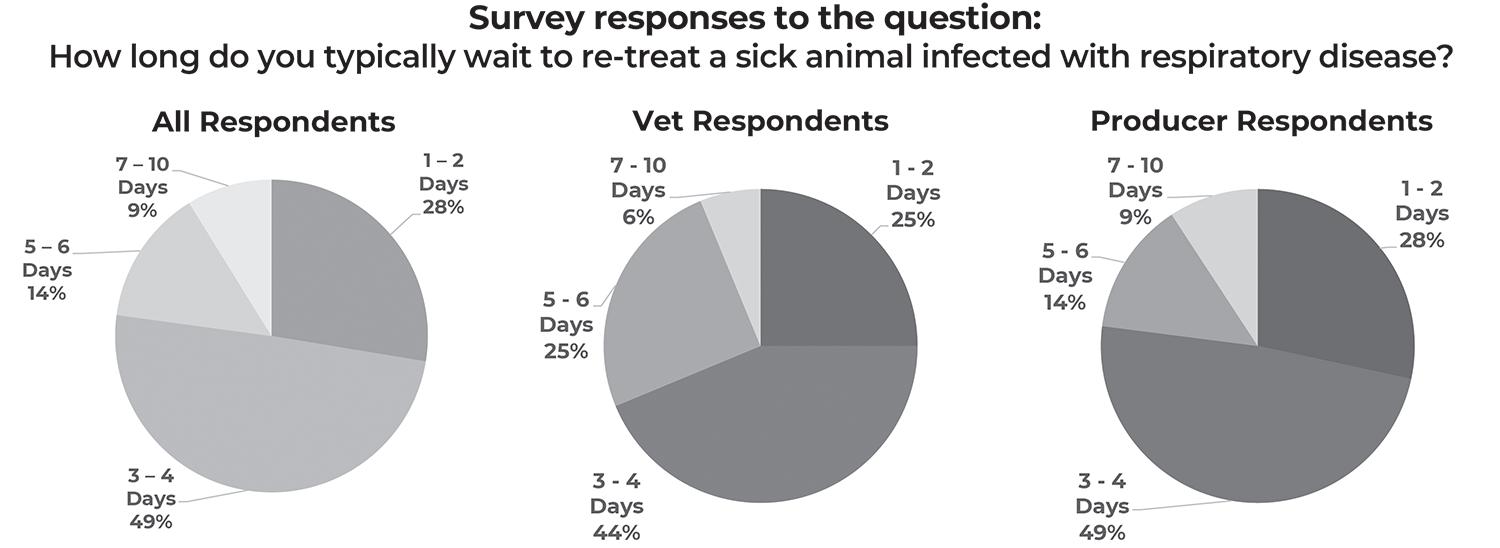
Post treatment intervals should come down to label and veterinary insight –When asked how long they typically wait to re-treat cattle challenged with BRD, waiting three to four days was most common across both veterinarian and producer responses.
“Post treatment interval (PTI) is a key focal point when considering a re-treatment,” said Dr. Meyer. “But it’s important to remember that PTI is product dependent. Because this survey was looking at the overall average PTI, I’m not too surprised by these responses. Although there are benefits to finding a product with a longer PTI.”
In a research trial on calves infected with BRD, 6–9 day PTIs resulted in the best health outcomes.2 Every re-treatment not only puts extra stress on animals, but
is another cost impacting profit margins. A larger window gives producers and veterinarians the flexibility to make the right decision, based on the herd.
Outside of following the product label, knowing when re-treatment is necessary can be difficult. Dr. Meyer recommends a few basic steps that can make the process easier.
1. Keep treatment records. Tracking treatment status ensures proper PTI and withdrawal times. Accurate documentation will also make evaluating product efficacy or protocols easier during routine conversations with your veterinarian. “If an animal is still looking rough on day three of a five day PTI, we know that we should hold off on re-treatment because the drug is still

working,” noted Dr. Meyer.
2. Check for clinical signs of illness. He added, “Once the calendar has been checked, and an animal is eligible for follow-up treatment, that’s when we should look for clinical signs.” Dr. Meyer is a firm believer in the D.A.R.T. assessment, which stands for depression, appetite, respiration, and temperature. If an animal is struggling with one or more of these signs, a followup treatment might be necessary.
These clinical signs are not unique to BRD, but are a sure way to flag animals that are still or are becoming ill.
Broad spectrum coverage of BRD pathogens is important to producer –When asked what was most important when choosing an antibiotic, the majority of participants ranked the following options in order:
1. Broad coverage of main BRD pathogens
2. Fast acting
3. Long lasting
“Broad spectrum of coverage is a key point, whether you’re a cow/calf, stocker or feedlot operation,” asserted Dr. Meyer. “We know a calf might start out with Mannheimia haemolytica , but later in the disease course, other bacteria become major players. Having a product that has broad coverage makes a lot of sense.”
The benefits of a long acting antibiotic that quickly reaches the site of infection should not be underestimated.
“Utilizing a product that has very high efficacy up front is beneficial when it comes to reducing stress levels and seeing better
treatment outcomes,” explained Dr. Meyer.
Finding an antibiotic that provides ten days of therapy from a single injection reduces both the time and labor associated with extra treatment.
“I think the number one underlying point from this survey is that the veterinarian’s involvement is important,” said Dr. Meyer. “Their assessment of an operation’s management and understanding of a herd’s disease pressure become very valuable when setting up successful treatment plans.”
References
1 Taylor J.D., Fulton R.W., Lehenbauer T.W., et al., The epidemiology of bovine respiratory disease: What is the evidence for predisposing factors? Can Vet J 2010;51(10):1095–1102.
2Theurer M.E., Fox J.T., Portillo T.A., et al. 2020. Comparison of gamithromycin post-treatment intervals for beef cattle naturally affected with bovine respiratory disease. Bov Pract 2020;54(2):105–111.
About Boehringer Ingelheim. Boehringer Ingelheim provides innovation for preventing and treating diseases in animals. The company offers a wide range of vaccines, parasite-control products, and medicines for pets, horses, and livestock to veterinarians, animal owners, farmers, and governments. As a leader in animal health, Boehringer Ingelheim values that the health of humans and animals is deeply connected and strives to make a difference for people, animals, and society. Learn more at www.bi-animalhealth.com





New era of value added calf programs shows what buyers value. Cattle buyers recognize the value of calves fed quality mineral nutrition. Quality nutrition is at a premium in an evolving feeder calf market. For several decades, value added programs have emphasized health protocols and genetics. Now, nutrition is taking its rightful place by factoring into buying decisions.
“Cow/calf producers can certainly benefit from being involved with value added programs that highlight nutrition,” says Ted Perry, cattle nutritionist with Purina Animal Nutrition. “These programs truly make better cattle. The calves are hardier, have a better immune system, and are more ready to go to the feedyards.”
Mineral nutrition program – Last year, Purina Animal Nutrition introduced the Purina Wind and Rain Mineral Value Added Program, one of the first feeder calf programs to provide buyers with
calves that have a foundation built on quality mineral nutrition. Calves enrolled in the program receive vitamins and minerals from conception to weaning.
Enrollment requirements for the Purina Wind and Rain Mineral Value Added Program include:
• Work with a local Purina dealer to enroll in the program.
• Feed dams Purina Wind and Rain Mineral or Purina RangeLand Pro Mineral for the full year in which you are raising the calves. A minimum of two bags of loose mineral per cow or one 225 pound mineral tub per two cows must be fed for the year.
• Qualifying calves receive Purina mineral as part of their nutrition program from conception through sale delivery.
“It’s one of the simplest yet effective value added programs available,” says Perry. “And, if you want to participate in other programs, you still have the option to pair it with the Purina Wind and Rain
Mineral Value Added Program.”
Calves buyers want – By feeding a high quality, complete mineral program, you help set calves up for optimal health and performance in the next phase, which helps drive profitability across the value chain. Buyers have the extra assurance that the calves they are purchasing will have a foundation for performance.
“Cattle buyers are looking for calves fed a complete mineral program so they’ll have an active immune system,” says Perry.
Superior Livestock Auction sales data from 2023 shows that by participating in the Purina Wind and Rain Mineral Value Added Program, you could see sizable average premiums of up to $31 per head.1
“That’s about 2 percent more value added to calves,” says Perry. “It’s worth it to me if I’m buying calves and they’ve been in this program because I know those calves will have a primed immune system.”
Calves enrolled in the Purina Wind and Rain Mineral Value Added Program are currently available for purchase at both Superior Livestock Auction and Western Video Market sales, along with
participating local livestock auctions.
Contact your local Purina dealer or visit www.purinamills.com/MVAP for more information on the Purina Wind and Rain Mineral Value Added Program and how it could impact your bottom line.
Reference 1Tonsor, G., and Renter, D. 2023. Superior Livestock Auction Data. Kansas State University.
About Purina Animal Nutrition. Purina is a national organization serving producers, animal owners, and their families through more than 4,700 local cooperatives, independent dealers, and other large retailers throughout the United States. Driven to unlock the greatest potential in every animal, the company is an industry leading innovator offering a valued portfolio of complete feeds, supplements, premixes, ingredients, and specialty technologies for the livestock and lifestyle animal markets. Purina Animal Nutrition is headquartered in Arden Hills, Minn., and is a wholly owned subsidiary of Land O’Lakes, Inc. For more information, visit www. purinamills.com


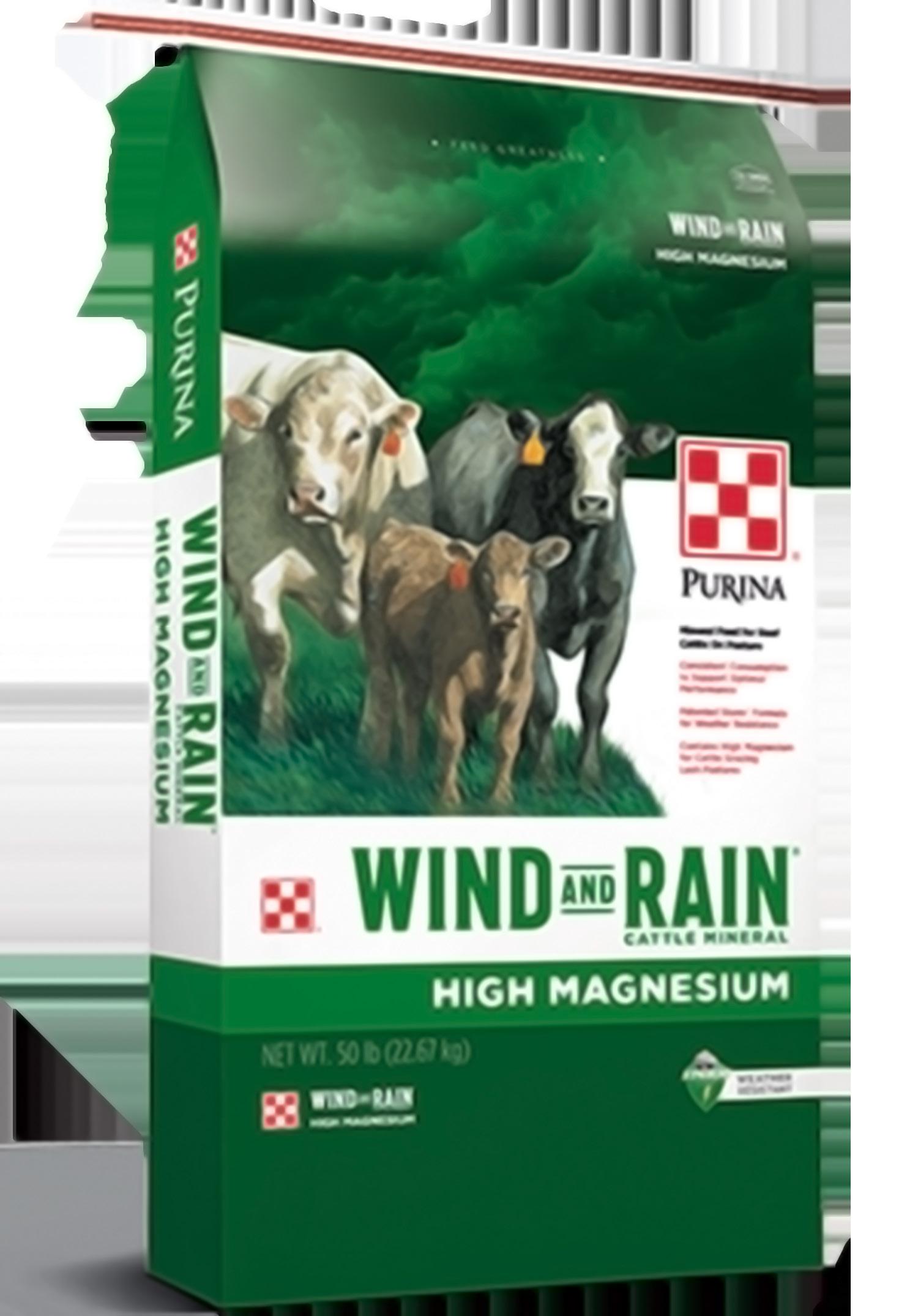






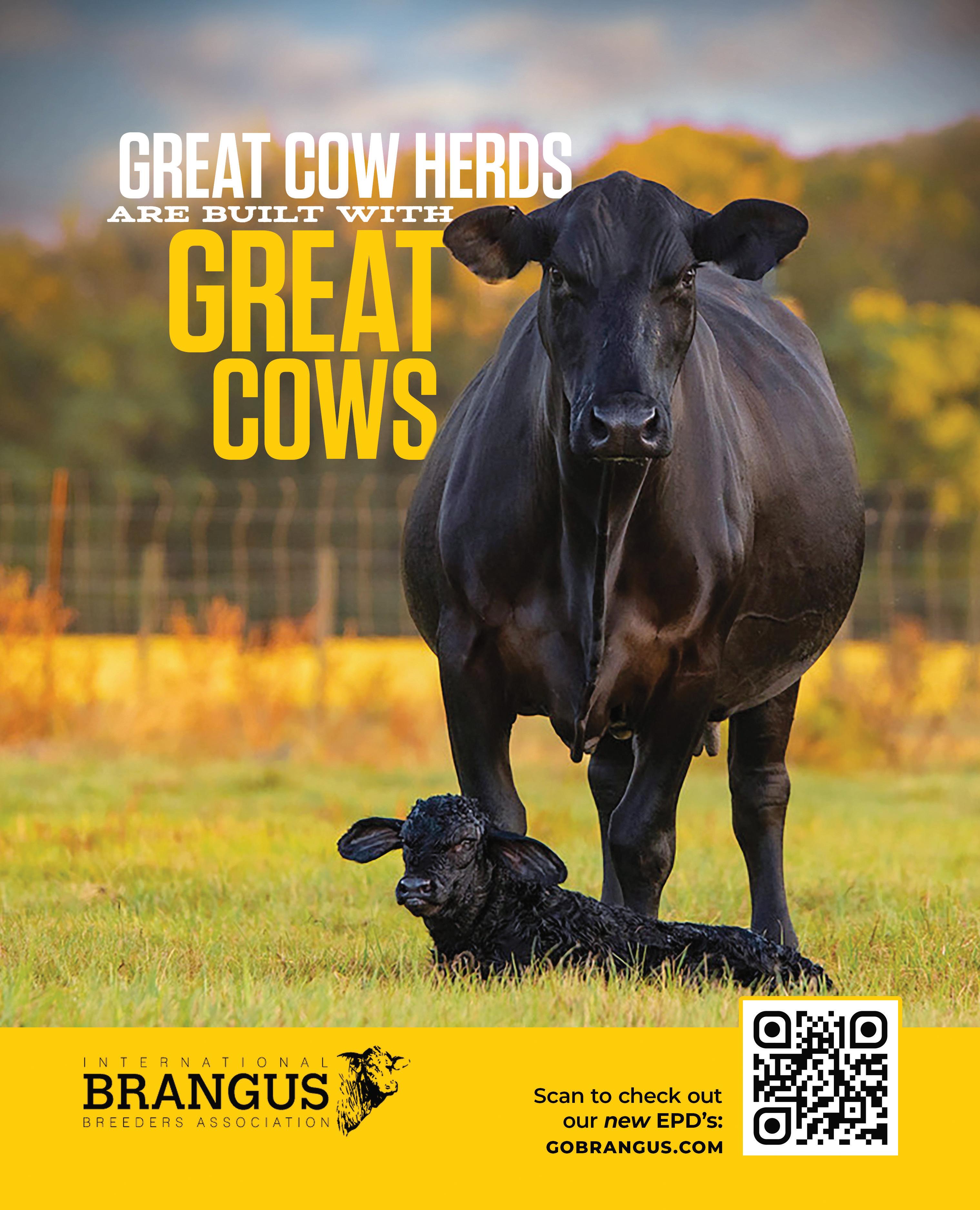

1 MILE OF PASTURE MANAGEMENT FENCING SUPPLIES AWARDED TO THE NCCA COUNTY CATTLEMEN’S ASSOCIATION
RECRUITING THE MOST NEW MEMBERS IN 2024
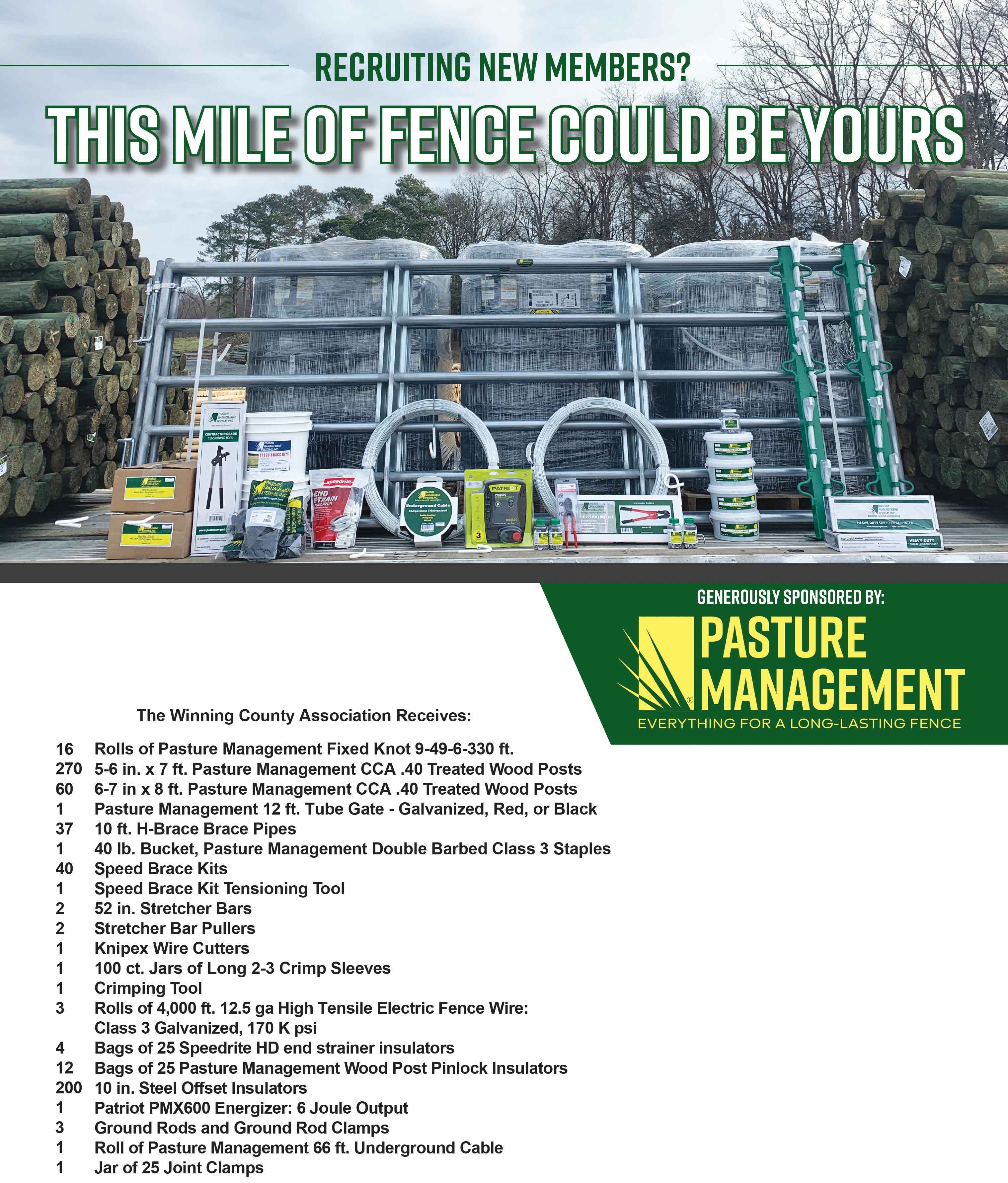

CONGRATULATIONS TO THE MACON COUNTY CATTLEMEN’S ASSOCIATION
2023 MILE OF FENCE WINNER

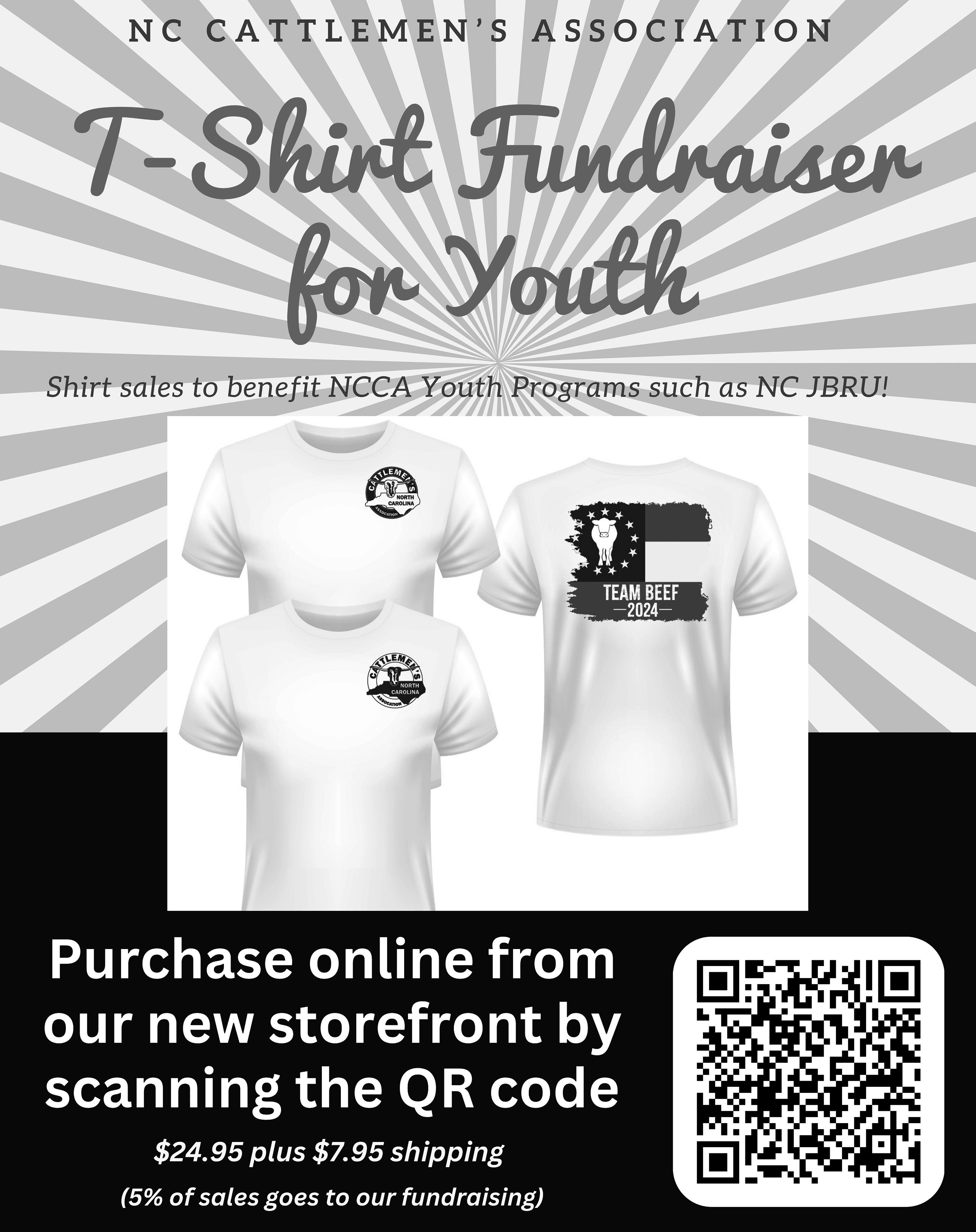
In 2007, the NCCA Membership Committee passed a resolution to recognize all NEW members, defined as someone who has never been a member or has rejoined after a break in membership, in The Carolina Cattle Connection. Below are NCCA’s new members for the last month:
Buncombe County
Makayla Pegg – Pegg Cattle Company
Gaston County
Zane Michaels – Hidden Springs Farm
Haywood County
Ayden Bowen
Sean Dye
Kyler Gublurd
Haeden Little
Kayla Martin
Hannah Riker
Hailey Stevenson
McDowell County
Rebecca Lawing – Pa’s Farm
Polk County
William Ballard
James W. “Pete” Patterson Passes
July 9, 1928 –August 27, 2024
James W. (Pete) Patterson, 96, of Glenaire Retirement Center in Cary, N.C., went home to his Lord on August 27, 2024. He was born in Macon County to Albert Claude Patterson and Edna James Patterson on July 9, 1928. He was married to Hilda Lee Patterson for almost 70 years.

James had a distinguished career as an extension animal husbandry specialist in the N.C. State University animal science department after receiving his M.S. from NCSU. Following his Ph.D. program at VPI (now known as Virginia Tech), he returned to NCSU as extension livestock specialist and led the development and implementation of the very successful beef cattle improvement program known as N.C. BCIP. During his career, he was actively involved in the N.C. Cattlemen’s Association, where he served on the executive committee for several years. He was involved in the N.C. Cattlemen’s Foundation, where he served as its first executive director. He received much recognition and many awards for his service in these organizations and for his work at NCSU.
James also served on a national level with the Beef Improvement Federation, where he received the highest and most cherished BIF Pioneer Award.
Following his active duty in the U.S. Army, he remained active in the army reserves and retired as a Lt. Colonel. Both James and Hilda have been long time members of Forest Hills Baptist Church, where he taught Sunday School for many years. James taught the Willing Workers Sunday School class for over 25 years. This class was previously named to honor a deceased class member.
He is preceded in death by his parents, his son, Dr. James W. Patterson, Jr.; his sister, Catherine Taylor; his brothers-in-law, Sanford and Hiram Lee; and his nephews, Tom Vinson, Jeff Lee, and Steve Lee.
He is survived by his wife, Hilda; sister-in-law, Sarah Lee; nieces Karen Vinson, Margaret Bryson, Dianne Taylor, Sandy Vinson, and Melinda Musamarra; nephews Brooks Lee, Barry Lee and Brandon Lee; and many great and great-great nieces and nephews.
Randolph County
Jenna Ball
Jason Beal
Cody Bowman
Connor Brown
Katelyn Brown
Kayleigh Brown
Madison Bunch
Melody Canseco
Camila Cruz
Ned Davis
Jeramyah Ellison
Tyler Faulkner
Kylee Foust
Nevaeh Gainey
Eddie Gonzalez
Savannah Gouldman
Maddi Hammer
Shawn Haynes
Ceeaira Hineline
Katlyin Hutchins
Jason Lee Kearns
Michael Kivett
Andrea Leal
Travis Long
Felipe Lopez
Yurida Lopez
Marlayah McCorey

Giovanni Pastelin Mejia
Daniel Montenegro
Christopher Neal
Alex Nielsen
Matthew Phillips
D’Shaun Rivera
Cora Sparrow
Victoria Styles
Kayley Tate
Abigail Lynn Taylor
Crystal Temkey
Riley Thorn
Lillian Woodell
Destiney York
Robeson County
Carl Ricky Jones
Rockingham County
William Bottoms Jr. – Rocking B Farm
Brent Weiss – Upper Piedmont Research Station
Union County
John Flynn – CTG Farm
Warren County
Frances Harris – Green Acres


By LARA IVANITCH N.C. State University
Doctoral student Benjamin Rajo’s first trip to N.C. State University four years ago was fraught with uncertainty. In a race to leave Honduras before Category 4 Hurricane Eta hit, he and his wife, Carolina, traveled to Ramon Villeda Morales International Airport, passing streets flooded by rain from the storm’s outer edges. Inside the terminal, lines of travelers waited, unsure if they would fly that day. Once in the air, the turbulence was terrifying.
“We thought that we were going to crash,” recalls Rajo.
When the plane cleared Hurricane Eta’s cloud cover and steadied in the cerulean stratosphere, Rajo’s sights were focused on N.C. State University’s Department of Animal Science.
A Call to Cattle – Rajo’s childhood in pastoral Siguatepeque, Honduras, looked much like that of a kid in rural North Carolina. He spent many afternoons and weekends doing chores on his mother’s 30 acre farm. During school breaks, he learned to tend cattle on the nearly 700 acre farmstead of his grandfather and namesake, Abuelito Mincho.
Early in his life, Rajo’s mother rescued a pregnant cow slated for slaughter. Afornunada (the lucky one) soon birthed a bull calf. Rajo’s grandpa traded the bull calf for a heifer that, much to Rajo’s delight, became his to raise.
“At four years old, I had a heifer,” he says. “I was so happy because I had a pet that was not like a cat or a dog. It was a cow!”
Eleven years later, Rajo’s herd had grown from one to 98, and its sale paid
his tuition to Zamorano University. There, hands-on learning supplemented the farming skills he had learned from his grandfather.
A Research Passion Ignites – Rajo discovered a love for research while managing a cattle farm in mountainous northern Honduras. In 2012, the recent college graduate began working to regain the farm’s economic viability. In addition to implementing a vaccination schedule and planting legumes to improve forage quality, he conducted experiments, like feeding weaned bull calves a supplement to their grazing, resulting in increased growth rates.
In 2019, Rajo approached the owner with another idea — “planting some of the lots with crops to increase biodiversity and provide another source of income.” But the owner, satisfied with the existing improvements, didn’t want to make any more large investments in the farm. While Rajo understood, his motivation to continue managing the farm waned.
In 2020, after leaving the cattle farm, Rajo reached out to graduate programs, seeking opportunities for academic research. However, the pandemic cast a shadow of uncertainty on the future — he received zero responses.
That fall, a fellow Zamorano graduate pursuing her master’s in poultry science at N.C. State University, convinced Rajo to visit the school. “I thought, I’m just going to go walk into the Department of Animal Science and start knocking on doors.”
With luck and tenacity, Rajo connected with Professor Daniel Poole.
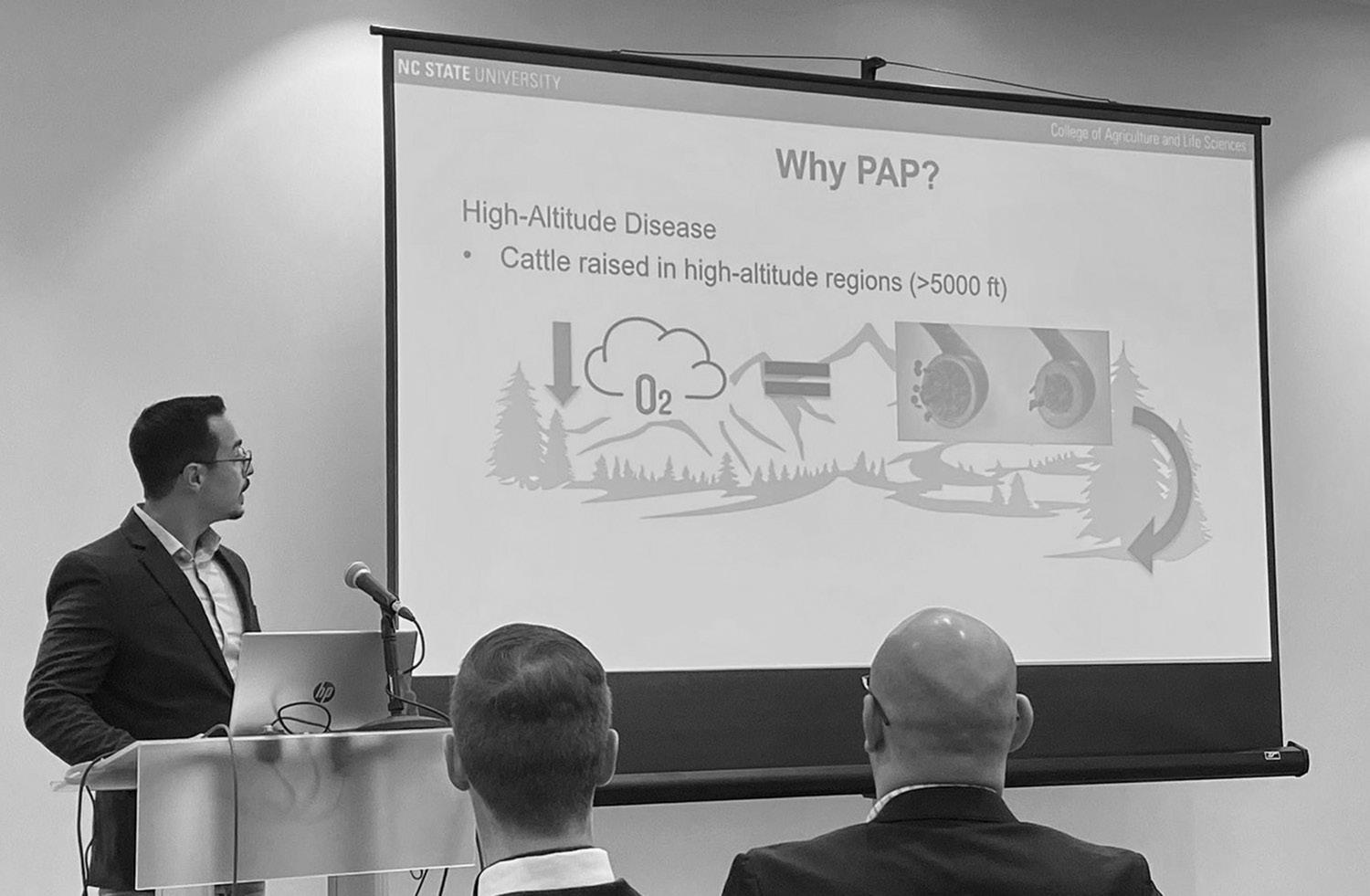

At the end of a lengthy conversation at the Beef Educational Unit, Poole offered Rajo a position in his lab. “This is exactly what I am looking for,” he recalls saying. “Where do I sign?”
As a graduate and doctoral student in animal science, Rajo’s research has focused on the physiological changes caused when beef cattle consume ergot alkaloids. Although these substances are created by a fungus that proves beneficial to tall fescue — the predominant forage in the region, most of which is infected by the fungus — ergot alkaloids can cause fescue toxicosis in cattle. The disease causes slow growth rates, increased body temperatures, and the retention of thick winter coats, costing the industry an estimated $1 billion each year.
Cattle Career Aspirations – After completing his doctoral degree next

year, Rajo, who received a grant from the Hispanic American Chamber of Commerce this summer in recognition of his research, hopes to provide cattle managers and farmers with practical ways to mitigate common causes of slowed growth and increased need for feed.
Whether working in a private lab or at a university, he wants to ensure the industry that has shaped his life can remain profitable and sustainable, particularly in the face of obstacles like changing weather patterns.
“We should have a proactive approach,” he says. “We should start looking for ways to improve efficiency and productivity in spite of environmental challenges.”
An article by Benjamin Rajo can be found on the next page.
By BENJAMIN RAJO
The Texas Panhandle is one of the principal destinations for weaned calves and stocker cattle raised in the Southeastern United States. Its unique characteristics bolster its relevance for the beef feedlot industry. The region’s flat topography and vast land extensions offer a geographic advantage for large scale feedlots, while its semi-arid climate is ideal for grain and roughage production, which support efficient feed conversions and the growth rate of cattle. This area also has well developed infrastructure, including roads, railroads, and feed processing facilities, that ease manufacturing and transportation. Additionally, it benefits from the expertise of universities, industry professionals, and private consultants who drive continuous improvement in the beef finishing sector.
Based on all these qualities and the sustained expansion of the industry during that time, the Plains Nutrition Council (PNC) was established in 1970 by professionals who worked and served as nutrition consultants, research scientists, and educators in livestock science. Since then, the main objective of the PNC has been to promote effective cooperation among its members and to provide a forum for discussion and promulgation of current research and new product applications that benefit the growth and improvement of the feedlot industry. To further expand its influence, the PNC created the Feedlot Nutritionist Boot Camp, which is a week long educational event for graduate students designed to bring in industry experts to present and discuss topics relevant to feedlot nutrition and provide graduate students with the opportunity to gain concepts and knowledge that are typically not covered in formal coursework during their graduate degree programs. This year, I had the privilege of being one of 26 graduate students selected from universities across the U.S. and Canada to participate. As a Ph.D. student in the Department of Animal Science at N.C. State University, attending this boot camp represented a tremendous opportunity to immerse myself in the aspects of feedlot nutrition, operation, and management, to increase my understanding of the current issues experienced with feeder cattle that come from the Southeast, and to obtain adequate direction to develop future research that focuses on improving cattle adaptability, productivity, and efficiency, which ultimately will benefit the cow/calf, stocker, and feedlot industries.
The boot camp took place at the
Paul Engler College of Agriculture and Natural Sciences at West Texas A&M University, which is named to honor the legacy, generosity, and leadership of one of the most successful businessmen in the beef industry. Throughout a very intense week, various presenters addressed relevant topics in the feedlot and beef packing sectors, including strategies for improving grain and roughage processing, differences in management methods based on cattle type and performance, the relevance of implant and feed additive utilization for increasing growth efficiency, and the current challenges caused by limited cattle supply, larger carcass size, and the rise of health problems in beef-on-dairy cross cattle. Despite the range of concepts discussed, the main objective remains to improve efficiency and productivity in the beef industry to satisfy a rapidly growing demand for safe, nutritious beef protein.
From the perspective of producers in the Southeast, cattle from this region often face price discounts due to the influence of Bos indicus genetics and are deemed as high risk animals because they have been raised in endophyte infected pastures. Since feedlots have minimal control over the genetic profile of Southeastern cattle shipped to their facilities, the strategies and logistics for improving cattle productivity, adaptability, and efficiency must be addressed by the cow/calf sector. Therefore, different strategies can be considered to enhance cattle performance and adaptability to the feedlot environment.
If feasible, removing cattle from endophyte infected pastures for a period of time before transporting them to the feedlot allows the animal to eliminate the ergot alkaloids from their metabolism. When endophyte free pastures are not available, producers should focus on improving animal performance despite alkaloid exposure. A proven and low cost phenotypic selection approach is to identify animals with increased hair shedding abilities. A hallmark symptom of fescue toxicosis in cattle is the retention of the winter hair coat throughout the summer, which increases their body temperatures, makes them more prone to heat stress, and negatively impacts their growth performance. Identifying animals, particularly mature cows and replacement heifers within the herd, that can shed their winter hair coats efficiently during the spring-to-summer transition may serve as an indicator of improved tolerance and adaptability to ergot alkaloid exposure.
In addition, cattle with better shedding ability are less likely to face price discounts upon arrival at the feedlot. Another factor to consider is strengthening the immune system of cattle before transportation to the feedlot. Feedlot managers often classify cattle of Southeast origin as high risk animals due to their weaker immune systems and delayed adaptation to confinement, which increases their susceptibility to diseases and reduces their growth potential. To facilitate this transition, cattle should be managed from birth with well established vaccination protocols and nutritional strategies that support their immune response to pathogens and help them achieve their growth potential. Lastly, developing a solid and consistent relationship with feedlot representatives can benefit producers by obtaining feedback on their cattle’s performance and identifying specific areas for improvement that can enhance bilateral productivity and profitability. Given the increasing demands from retailers, consumers, and regulatory agencies for more efficient and sustainable cattle raising and processing methods, producers who can demonstrate that they raise cattle with superior nutritional efficiency, growth rates, and resistance to metabolic diseases may be able to negotiate potential premiums.
On a personal note, attending this boot camp has been one of the best experiences I have had during my time at N.C. State University. The common closing statement made by all the speakers after their presentations was, “I wish I could have had this opportunity when I was a graduate student”,,and I completely understand why they felt that way. This program not only allowed me to learn from the industry’s current experts and leaders, but also gave me the chance to meet fellow graduate students who will soon become the experts and leaders of the industry — and many of whom I now have the pleasure of calling friends. I hope this boot camp continues to admit graduate students from the Southeast in future editions, as it is an extraordinary opportunity for networking and forging future collaborations that will benefit the beef industry. More importantly, I encourage every graduate student with an interest in beef cattle production to apply to this boot camp, as the lessons I learned and the connections I made have definitely prepared me to become a better professional capable of contributing to the improvement of the beef industry.
For additional information about the boot camp, visit www. theplainsnutritioncouncil.com/feedlotnutritionist-bootcamp



By NICOLÁS NEGRIN PEREIRA, DVM
UNC Pembroke
The importance of breeding soundness examination in beef bulls
– According to the last USDA Census data5 more than 90 percent of the beef calves produced in the U.S. come from natural mating. In addition, the bull is the individual bearing the maximum responsibility for herd fertility. If one cow has fertility problems and fails to conceive, the opportunity cost will be one calf (very rarely two), while if a bull presents fertility issues, the loss can be much greater since it is common for one sire to breed between 12-40 females. The bull’s responsibility is even bigger when considering small herds, which is different from the multi-sire situation, where the deficient performance of one bull might be compensated by another bull with a better performance in the same pasture. In addition, our potential losses can be even greater if the bull with fertility issues is dominant, preventing other bulls in a lower position in the hierarchy from breeding. Furthermore, it is estimated that in an unselected population of bulls, 1 in 5 are subfertile due to physical unsoundness or poor semen quality. 1 Moreover, if we consider a beef cow/calf system, reproductive merit is five times more important economically than growth performance and at least ten times more important than product quality.4 The most obvious and referenced consequences of the use of sub-fertile bulls are the loss of pregnancies. However, in most situations, by the time we detect the open cows, it is too late to implement any corrective management because the
bulls are out of the herd and the breeding season has finished. Other not-so-evident consequences of the use of sub-fertile bulls are delayed conceptions and an extended calving season. It is estimated that for every 21 day period a beef cow remains open during the breeding season, there is a potential loss of 50-60 lbs of weaning weight the following year for the calf she finally conceives. In actual values, considering an average price for weaned calves of $2 per lb of live weight, the loss will represent $100-$120 per calf for every 21 day delay in conception due to the use of undetected sub-fertile bulls.

The early detection of those bulls with low fertility before the start of our breeding season is crucial for the reproductive efficiency of our herd.
Unfortunately, in the U.S., breeding soundness examination (BSE) in bulls has a surprisingly low rate of adoption. If we consider all beef operations in the analysis, less than 20 percent of producers do semen evaluation in their bulls.1 The


situation is even worse when we consider small herds (less than 50 cows), where only 14.5 percent of the operations do semen evaluation. It is in the small herds where checking our bulls is even more critical, since one or two bulls are normally responsible for all the breeding. If any of the sires present fertility issues, the consequences can be very serious.
The importance of breeding soundness examination – At present, there is no single factor that allows us to predict a bull’s fertility and daily sperm capacity. Nevertheless, the breeding soundness exam (commonly known as BSE) is an excellent tool to determine which bulls are potentially apt for breeding. Breeding soundness exam in bulls is considered a proven, simple, easy to apply, and cost effective technique. The national average for professional veterinarian charges for a BSE is $75, an extremely low cost compared to those generated by potential open cows and delayed conceptions.
It is recommended that the BSE be performed by a qualified veterinarian following the standards set up by the Society for Theriogenology. 3 A BSE should include an assessment of the bull’s physical and structural soundness, potential sperm production capacity, and semen quality. Nevertheless, it is
important to mention that the BSE does not routinely assess the bull’s libido or desire to breed. However, if we suspect a bull has low libido, we can ask for a breeding serving capacity test. It is highly recommended, and it is a good management practice, to spend time observing the bulls working in the field. Make sure all the cows are being bred, and take notes and identify tag numbers if we suspect a bull is not capable of completing the service. Also, BSE does not include testing for reproductive diseases like campylobacteriosis, trichomoniasis, and leptospirosis. If we suspect the presence of venereal diseases in our herd, bringing the bulls to the chute for BSE represents a wonderful opportunity to do prepuce scraping or collect blood samples for sexually transmitted diseases.
One of the main advantages of the BSE is that it is an easy technique to apply under normal field conditions. The basic requirements for its application are a cattle chute with a dependable head catcher and rear and lateral access to the restrained animal. The rear access allows us to measure scrotal circumference, testicular, epididymis, and spermatic cord palpation, as well as a rectal evaluation of the sexual accessory glands. The bottom lateral door allows us to inspect the penis
when protruded by the electro ejaculator, collect semen, and do prepuce scraping. Another important recommendation is to observe the bulls as they leave the chute, observing their feet and legs and how they walk. As part of the physical examination, special attention should be paid to the head of the bull, particularly the eyes. The importance of a bull’s sight to detect the group of sexually active females in the pasture is well documented.2 Female activities like mounting other cows, frequent urination, and other behavioral signs of heat are important visual cues for the bull, which will readily walk to the group of females. Finally, it is quite common while performing BSE to detect eye lesions like carcinomas (with a higher incidence in non-pigmented animals) and cornea lesions secondary to pink eye infections, impairing a correct vision.
When should we do BSE on our bulls? One important recommendation when deciding to do BSE on our bulls is to do it well in advance of the start of the breeding season. The recommended time is a minimum of 60 days prior to the bull’s turn out. This is because that is the time it takes the seminiferous epithelium of the bull to complete spermatogenesis.
Once we diagnose and correct the cause of the testicular problem, this will give the bull sufficient recovery time before turn out. In addition, it will give us enough time to find a replacement, if necessary, depending on the severity of the problem. Furthermore, working in advance with our bulls will also give us the opportunity to apply nutritional corrective measures, if required, making sure our bulls reach the start of the breeding season with an optimal body condition score, which is 6-6.5.
The BSE should be done on every bull, every year, as it is a snapshot of the potential reproductive capacity status of the bull, which can change over time.
Breeding soundness examination in bulls is a powerful tool in our hands for the early detection of individuals with fertility issues. More than a cost for producers, it constitutes an extremely low investment to avoid potential reproductive losses. Do not wait until the last minute to coordinate a visit with your veterinarian to bring your bulls for a BSE.
References
1Barth, A.D., and C.L. Waldner. 2002. Factors affecting breeding soundness classification of beef bulls examined
at the Western College of Veterinary Medicine. Canadian Veterinary Journal, 43: 274-284.
2 Geary, T. W., and J.J. Reeves. 1992. Relative importance of vision and olfaction for detection of estrus by bulls. J. Anim Sci. 70(9):2726-31.
3Koziol, J.H., and C.L. Armstrong. 2018. Society for Theriogenology Manual
for Breeding Soundness Examination of Bulls. Second Edition.
4Trenkle, A., and R.L. Willham. 1977. Beef Production Efficiency. Science, New Series, Vol. 198 (4321; 1009-1015).
5 USDA-National Animal Health Monitoring System, Census 2017. Beef Cow/Calf Management Practices in the U.S.
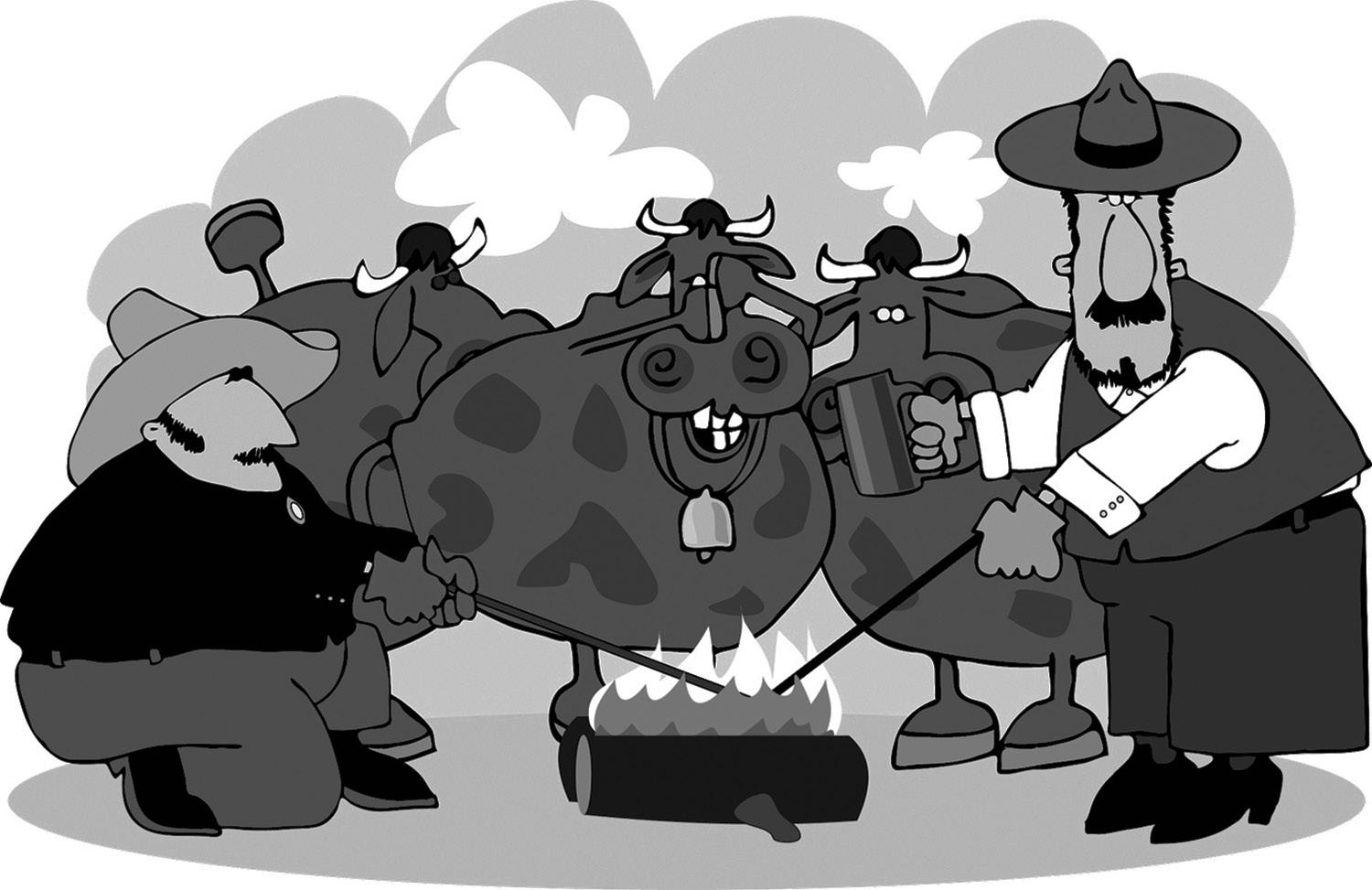

John Andrae was recently selected as the new director of the Edisto Research and Education Center (REC), following a national search. Andrae steps into the position during a period of significant growth and development at the facility, bringing a vision focused on consistent management, impactful research, and increased visibility.
Andrae, who previously served as the Clemson University Experiment Station associate director, brings valuable experience overseeing state capital projects. This background will be crucial as he takes charge of several key initiatives at Edisto REC.
“Currently, there are over $10 million in capital projects underway at Edisto REC,” said Experiment Station Director Paula Agudelo, who also serves as associate dean for research in Clemson’s College of Agriculture, Forestry, and Life Sciences (CAFLS). “These projects are critical to our CAFLS mission, and Dr. Andrae is well prepared to manage and prioritize these efforts to enhance our research capacity.”
Major Facility Improvements –One of the most significant projects involves improving and expanding the center’s lab facilities. The existing analytical labs, initially built in the mid-1980s, are being updated to meet modern research standards. The former educational Discovery Lab is being remodeled into a 1,500-square-foot wet lab designed primarily for plant pathology research. Additionally, plans for a new 4,500-square-foot analytical lab, estimated at $7 million, are in the final stages, awaiting approval to begin bidding.
Enhancing Graduate Student Resources – Recognizing the challenges posed by the center’s rural location, Andrae is also focusing on improving resources for graduate students. The former



administration building is being converted into residential space, with construction on the $1 million project set to begin this fall. This will add 11 new bedrooms, helping to attract and retain graduate students. A new office area is also being completed, providing desk space for 16 graduate students and a conference room for virtual meetings with the main campus.
Expanding Research Capabilities
– Under Andrae’s leadership, the Edisto REC is also expanding its field research capacity. A $1.2 million federally funded containment facility is being constructed to study the guava root knot nematode, a pest affecting crops in the southeastern United States. This facility will enable controlled research on effective management strategies, including screening vegetable crop varieties for resistance.
The center also responds to growing interest in specialty crops by nearly doubling its vegetable research acreage. Current research focuses on watermelon, sweet corn, tomatoes, pumpkins, and sweet potatoes. This expansion is supported by a recent hire specializing in vegetable production and increased collaboration with the Clemson Coastal REC and the USDA National
Regular copy deadline is OCTOBER 5 for the NOVEMBER issue.
Is there a problem?
Vegetable Research Lab in Charleston.
Strategic Faculty Hires – Looking ahead, Andrae plans to bolster the center’s research and educational capabilities with strategic faculty hires. Three new positions are scheduled in precision agriculture and agricultural engineering, including a control and sensor engineer, a harvest mechanization expert, and a faculty member to interface with the Clemson University Center for Advanced
Technology. Additionally, funding will be sought for an extension livestock specialist focusing on beef nutrition research.
“This director position is a service role,” Andrae stated. “I’m here to listen to faculty and develop the best strategies for the REC’s future.”
With Andrae at the helm, the Edisto REC is poised to continue its growth, enhancing its research capacity, and strengthening its integration with extension.

Total Time - 40 minutes
12 oz. cooked (leftover) beef pot roast, chopped
1 (12 oz.) can artichoke hearts, drained
8 oz. cream cheese, softened
1 teaspoon freshly ground black pepper
2 teaspoons granulated garlic
¾ cup reduced fat dairy sour cream
½ cup shredded Parmesan cheese
1 cup reduced fat mozzarella cheese
5 oz. fresh spinach, chopped
Serving suggestion – Celery sticks, carrot sticks, pepper slices, tortilla chips, crackers
Preheat the oven to 375°F. In a large bowl, mix cream cheese, sour cream, Parmesan cheese, mozzarella cheese, pepper, and garlic. Once smooth, add in the spinach, chopped beef, and artichoke hearts; combine.
Coat a 9×9 baking dish with non-stick spray. Place the mixture into a baking dish and bake for 20–30 minutes, or until the mixture is bubbling and golden brown. Serve warm, alongside fresh vegetables and tortilla chips.
Makes 10 servings.

The 2024-2025 Clemson Bull Test program has kicked off another year. The bulls arrived on August 6 and were weighed on test on August 20-21 after a two week warm up period. The bulls are adjusting well to the new routine and feed. We have another great set of bulls this year. Breeds included in this year’s test are Angus, Red Angus, Hereford, Simmental, SimAngus, Balancer, and Ultrablack. We have a total of
have an outstanding group of bulls offered at the Clemson Bull Test Sale on February 1, 2025.
We are also pleased to announce the call for nominations for heifers to sell as part of the 2025 Clemson Bull Test Sale on February 1, 2025. Only 19 pens of heifers will be accepted, so please get your nominations in early. Nominations are due by December 1. All nomination
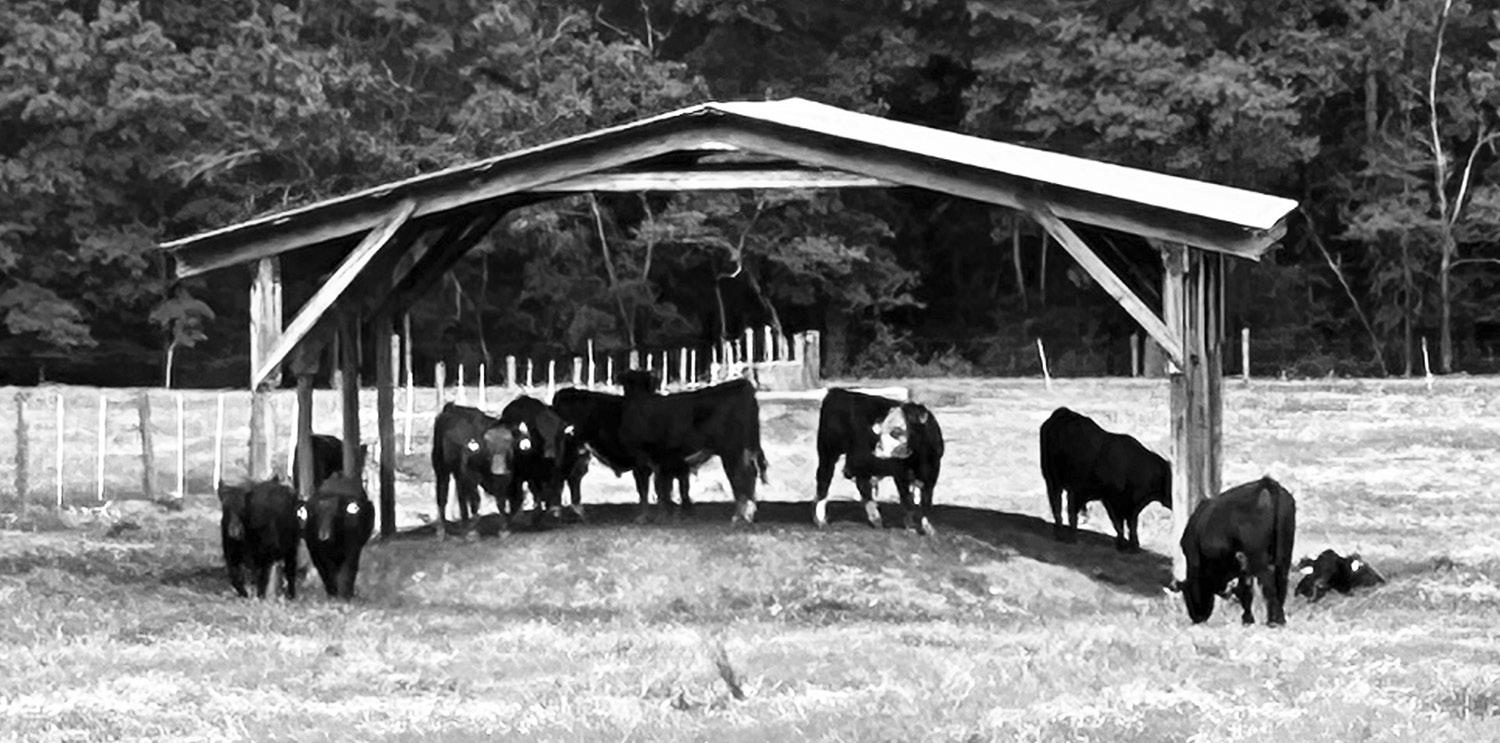

66 bulls that started on test with consignors from South Carolina, North Carolina, and Georgia. Reports can be found online at our Clemson Bull Test website. We cannot wait to see how these bulls progress over the next several months. We know that we will paperwork can be found on the Clemson Bull Test website. Please feel free to contact Lindsey Craig at lcraig@clemson. edu if you have any questions about the Clemson Bull Test program or heifer nomination process. S.C. Cattle Receipts,



Masters of Beef Advocacy Program
Celebrates 25,000 Graduates. The program reaches a new milestone, growing by more than 5,000 in the last two years. Two years ago, the Masters of Beef Advocacy (MBA) program managed by the National Cattlemen’s Beef Association, a contractor to the Beef Checkoff, hit 20,000 graduates. Today, the program celebrates an additional 5,000 graduates, reaching a new milestone for advocacy in the beef industry.
“It feels like yesterday that we were celebrating 20,000 graduates,” said Paul Dybedahl, Associate Director of Communications for the Masters of Beef Advocacy Program. “Just two years later, it’s incredible to see an additional 5,000 graduates, all willing to dedicate their time to learn more about and advocate for the beef industry.”
Created in 2009, the MBA program is a free, self guided online course that provides members of the beef community, from farmers and ranchers to students, supply chain members, and consumers, with the tools and resources needed to become strong advocates for the beef community.
In 2021, the MBA program launched MBA NextGen, which updated training modules, splitting the course into five online lessons:
• The Beef Community – Context of raising beef from pasture to plate, with a focus on the community of people involved throughout the beef lifecycle.
• Raising Cattle on Grass – An introduction to the first step in the beef lifecycle and the many benefits of raising cattle on our country’s vast grass pasture resources.
• Life in the Feedyard – A discussion on the role of feedyards, including animal care, nutrition, and environmental stewardship, at this important step in the beef lifecycle.
• From Cattle to Beef – An in-depth look at the slaughter process and the humane handling and safety measures in place at today’s beef processing facilities.
• Beef. It’s What’s For Dinner. – A primer on choosing and cooking the right cuts of beef and the important role of beef in a healthful diet.
After completing NextGen, MBA graduates can enroll in MBA Continuing Education, where they can continue their education with more lessons on beef’s
nutrition, sustainability, and animal welfare, among others. Graduates can also access monthly newsletters and join the program’s Facebook community, where updates are given on the latest consumer trends. Anyone interested in learning about beef’s journey from pasture to plate is invited to enroll today.
Beef Promotion Operating Committee Approves Fiscal Year 2025 Checkoff Plan of Work. The Cattlemen’s Beef Board (CBB) will invest approximately $38 million into programs of beef promotion, research, consumer information, industry information, foreign marketing, and producer communications during fiscal 2025, subject to USDA approval.
In action at the end of its September 4-5 meeting in Denver, Colo., the Beef Promotion Operating Committee (BPOC) approved Checkoff funding for a total of 12 “Authorization Requests” — or grant proposals — for the fiscal year beginning October 1, 2024. The committee, which includes ten producers and importers from the Cattlemen’s Beef Board and ten producers from the Federation of State Beef Councils, also recommended full Cattlemen’s Beef Board approval of a budget amendment to reflect the split of funding between budget categories affected by their decisions.
Eight contractors and two subcontractors brought 12 Authorization Requests worth approximately $46.8 million to the BPOC this week, approximately $8.8 million more than the funds available from the CBB budget.
“We’re consistently impressed with the proposals that our contractors bring forward each year, and choosing which initiatives to fund is a real challenge,” said Andy Bishop, CBB and BPOC chair. “Our budget amounts to slightly less each year because of inflation. To put it in perspective, a dollar in 1985 is worth just 35¢¹ today. That means we simply don’t have the buying power that we had when this program first started.
“As we expected, the Authorization Requests we reviewed this week were full of new ideas and innovative approaches supporting the Checkoff’s core programs of research, promotion, foreign marketing, industry information, consumer information, and producer communications. Our committee did a great job of balancing our budget and
distributing our limited funds in what, we believe, is the most optimal way possible. I personally thank our contractors and committee members for all their hard work, and I look forward to future Checkoff successes throughout FY25.”
In the end, the BPOC approved proposals from eight national beef organizations for funding through the FY25 Cattlemen’s Beef Board budget, as follows:
• American Farm Bureau Foundation for Agriculture — $600,000
• Cattlemen’s Beef Board — $1,800,000
• Foundation for Meat and Poultry Research and Education — $600,000
• Meat Import Council of America/ Northeast Beef Promotion Initiative — $900,000
• National Cattlemen’s Beef Association — $25,700,000
• National Institute for Animal Agriculture — $95,000
• North American Meat Institute — $280,000
• United States Meat Export Federation — $8,000,000
Broken out by budget component — as outlined by the Beef Promotion and Research Act of 1985 — the FY25 Plan of Work for the Cattlemen’s Beef Promotion and Research Board budget includes:
• $9,120,000 for promotion programs, including beef and veal campaigns focusing on beef’s nutritional value, eating experience, convenience, and production.
• $8,600,000 for research programs focusing on pre and post harvest beef safety, scientific affairs, nutrition, sustainability, product quality, culinary technical expertise, and consumer perceptions.
• $7,500,000 for consumer information programs, including Northeast influencer outreach and public relations initiatives; national consumer public relations, including nutrition influencer relations; and work with primary and secondary school curriculum directors nationwide to get accurate information about the beef industry into the classrooms of today’s youth. Additional initiatives include outreach and engagement with food, culinary, nutrition, and health thought leaders; media and public relations efforts; and supply chain engagement.
• $2,955,000 for industry information programs, including the dissemination of accurate information about the beef industry to counter misinformation from other groups, as well as funding for Checkoff participation in the annual national industry wide symposium about antibiotic use. Additional efforts in this program area include beef advocacy training and issues/crisis management and response.
• $8,000,000 for foreign marketing and education, focusing on 13 regions, representing more than 90 countries around the world.
• $1,800,000 for producer communications, which includes investor outreach using national communications and direct communications to producers and importers about Checkoff results. Elements of this program include ongoing producer listening and analysis; industry collaboration and outreach; and the continued development of a publishing strategy and platform and a state beef council content hub.
The full fiscal 2025 Cattlemen’s Beef Board budget is approximately $42.2 million. Separate from the Authorization Requests, other expenses funded include $305,000 for program evaluation, $750,000 for program development, $200,000 for Checkoff education resources, $575,000 for USDA oversight, $220,000 for state services, $200,000 for supporting services and litigation, and approximately $2.0 million for CBB administration. The fiscal 2025 program budget represents an increase of slightly less than 1.0 percent, or $150,000, from the $42.1 million FY24 budget.
For more information about the Beef Checkoff and its programs, including promotion, research, foreign marketing, industry information, consumer information, and safety, contact the Cattlemen’s Beef Board at 303-220-9890 or visit DrivingDemandForBeef.com Reference
1Source: January 2023 Consumer Price Index Inflation Calculator About the Beef Checkoff. The Beef Checkoff Program was established as part of the 1985 Farm Bill. The checkoff assesses $1 per head on the sale of live domestic and imported cattle, in addition to a comparable assessment on imported beef and beef products. States may retain up to 50¢ on the dollar and forward the other 50¢ per head to the Cattlemen’s Beef Promotion and Research Board, which administers the national checkoff program, subject to USDA approval.

Don’t get caught napping! Deadline is 5th of month prior to issue!

Information is required by (7 CRF 1260.201). Failure to report can result in a fine. Information is held confidential (7 CRF 1260.203).
Today’s Date: ________________
Seller’s Name: ____________________________
Address:
City: ________________ State: ____ Zip:
Seller’s Signature: _________________________
Buyer’s Name: ____________________________
Address:
City: ________________ State: ____ Zip: ______
Buyer’s Signature: _________________________
Both the seller & the buyer are responsible for making sure that the $1.50 per head assessment is collected and remitted to the Beef Promotion & Research Board.
Total Number of Cattle Sold: ___________________ x $1.50 Per Head = $ Date of Sale: __________________ Person remitting
* State of Origin of Cattle: * If the cattle purch ased came from another state within the last 30 days, indicate from which state the cattle were purchased.

to the Paperwork Reduction Act of
an
not conduct or sponsor, and a person is not required to respond to a collection of information unless it displays a valid OMB control number. The valid OMB control number for this information collection is 0581-0093. The time required to complete this information collection is estimated to average 1.8 minutes per response, including the time for reviewing instructions, searching existing data sources, gathering and maintaining the data needed, and completing and reviewing the collection of information. The U.S. Department of Agriculture (USDA) prohibits discrimination in all its programs and activities on the basis of race, color, national origin, gender, religion, age, disbility, sexual orientation, marital or family status, political beliefs, parental status, or protected genetic information. (Not all prohibited bases apply to all programs.) Persons with disabilities who require alternative means for communication of program information (Braille, large print, audiotape, etc.) should contact USDA’s TARGET Center at 202-720-2600 (voice and TDD). To file a complaint of discrimination, write USDA, Director, Office of Civil Rights, Room 326-W, Whitten Building, 14 th and Independence Avenue SW, Washington, DC 20250-9410 or call 202-720-5964 (voice and TDD). USDA is an equal opportunity provider and employer.

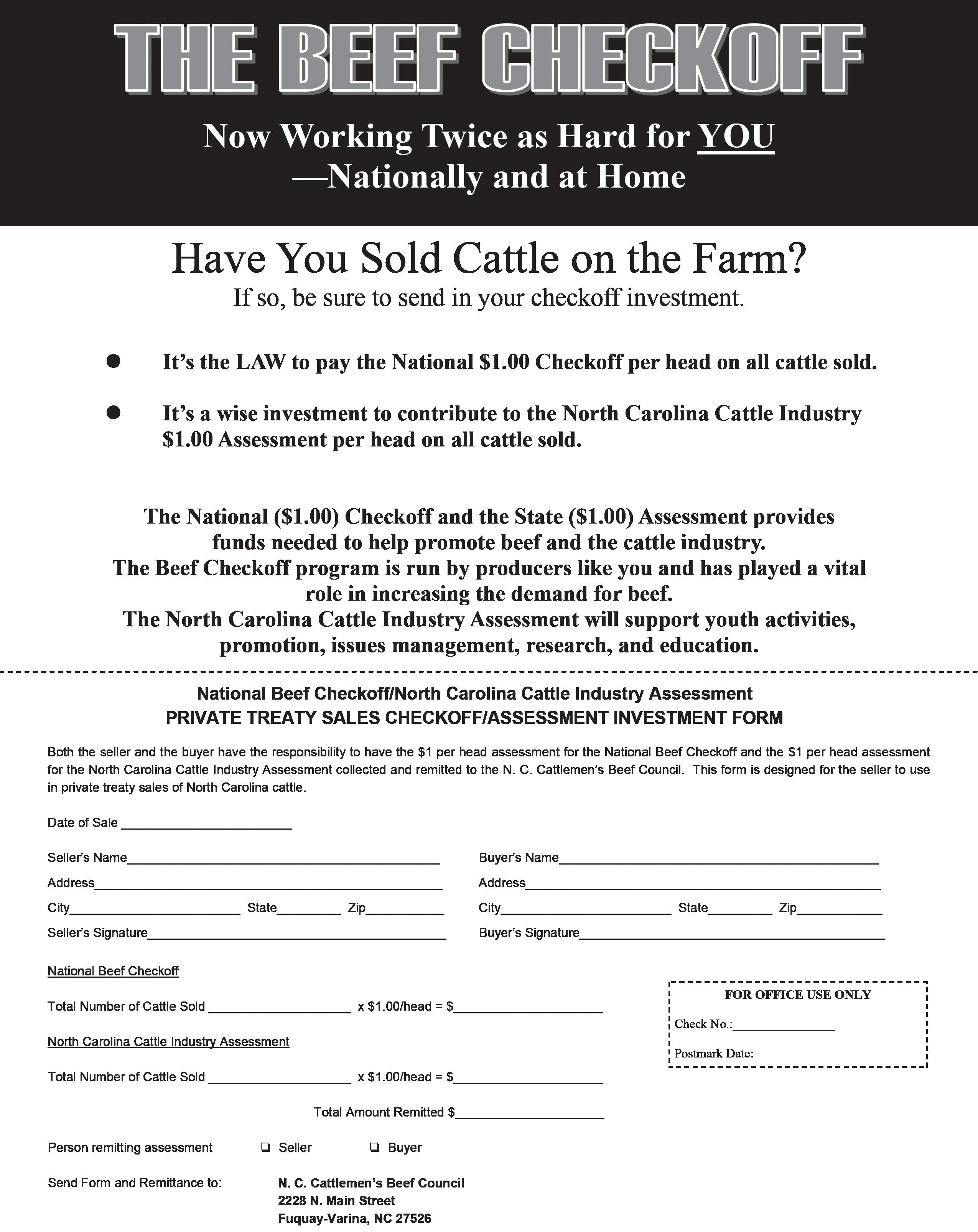
Faces of the Federation. For more than 60 years, grassroots producer engagement has driven the demand for beef through the Federation of State Beef Councils. States voluntarily invest in the Federation to build beef demand by inspiring, unifying, and supporting an effective and coordinated state and national Checkoff partnership. Ultimately, it is cattle producers from coast to coast who direct the Federation’s work, and we celebrate their dedication. These are the “Faces of the Federation.”
Sue Link
On the high plains of eastern Colorado, Sue Link and her husband live on their ranch, own a cow/calf operation, and sell grassfed beef. In addition to managing the ranch, the Links are involved with their community, including 4-H and cattlemen’s associations. Sue is the current Elbert County Noxious Weed Advisory Board chairman and works in partnership with fellow ranchers to fight the war on weeds in a fragile ecosystem while also educating newcomers how to be good stewards of their land. Sue’s participation in the Young Cattlemen’s Conference in 2005 elevated her volunteerism within the industry, and her passion continues to drive her work with the Federation of State Beef Councils.
How does the Federation of State Beef Councils impact the beef industry?
For more than seven years, I have served on the Colorado Beef Council board and as a Federation director on the Nutrition and Health Checkoff Committee. I appreciate learning about the different research projects, especially those concerning children, the lack of protein in their diets, and how that’s affecting them. Beef, like other animal proteins, is a complete protein that children, adolescents, and the elderly need in order to be healthy, not only physically but cognitively as well. I’m proud that we, as producers, are helping direct funds to this research.
The volunteer participation is truly grassroots. The Federation brings us together to focus on the common goal of building demand for beef. I’m definitely representing producers, just like myself. The producers at home often ask me what’s going on at meetings. It’s pretty exciting to take home all the information that we discussed, including industry challenges and authorization requests, as well as the numerous positive impacts
that Beef Checkoff funded work is having on the industry.
What are some of the benefits of investing in the Federation? The Colorado Beef Council really benefits from the Nutrition Seminar Program. Accredited nutrition speakers talk to our dietary interns and nurse practitioners about the benefits of beef in a healthy lifestyle. Currently, we are working with the Colorado High School Sports Association. We have a renowned speaker conducting webinars for parents, students, and coaches, talking specifically about the benefits of beef and the protein needed for these athletes to perform to the best of their ability. This program wouldn’t be possible without the collaboration of state beef councils and funding from the Beef Checkoff.
Why do you think the Federation continues to be vital? This is an exciting time to be a part of the Federation. After more than 60 years, it’s clear that this is something that works and that we need to continue. I said yes to serving on the Federation because I could see that it was a way for producers to come together and make sure things are done right, that we do have a voice, that there’s accountability, and that we can make positive decisions to drive demand for beef.
We’re all a bunch of independently minded people. We love what we do, and we think it’s the right thing to do. I want producers to know that there’s an opportunity for them here, to encourage them to get involved, make things better, and give back to the industry. I also know they’d see that the Beef Checkoff dollar really does make a difference.
What is the most important message you’d like to share about the Federation? The work we do isn’t just for us today. It’s also for our children, our grandchildren, and others in the future. My granddaughter is 13, and she absolutely loves to be on horseback in the pasture with me. She loves to check cattle, count cattle, and make sure we have the right number of calves. This was her first year participating in the junior cattlemen’s group, and she wants to come back. My hope is that she can see that the people involved in the industry are the ones who are passionate and know they can make a difference, even in challenging times. The reason I’m here doing the work with the Federation is to make sure that my granddaughter and
others have a future in the industry.
Watch the Faces of the Federation segments on Cattlemen to Cattlemen at www.youtube.com/user/ Cattlementocattlemen
New Online Resources Help Producers Promote Beef. Producers are the backbone of the beef industry. No one is more dedicated to raising healthy cattle and stewarding the land than a farmer or rancher. To help producers share their stories and promote beef to their customers, NCBA, a contractor to the Beef Checkoff, created a new portal on the www.BeefItsWhatsForDinner.com website that provides access to a variety of assets and resources.
“We are here to serve producers, and we want resources to be readily available to make it easy for them to share information,” said Rashanda Cobbins, NCBA’s director of content strategy. “These materials will help drive a consistent message as well as drive
demand for beef.”
An extensive library of Beef Checkoff funded images, media, recipes, and infographics is accessible to beef producers and stakeholders to assist in marketing and promoting beef. These resources, including beef cut and recipe imagery, lifestyle photography, how-to videos, fact sheets, and more are available for free through the Producer Resource portal. Whether direct marketing beef, educating consumers at an event or networking with fellow producers, the Producer Resource portal is the one place to go for materials.
Content will be updated regularly, highlighting beef throughout the seasons, from summer grilling to holiday feasts. Additional resources will be added based on producer feedback and requests. Accessing assets is free and easy; simply visit www.beefitswhatsfordinner.com/ resources/producer-resources to complete a short form.







By RYAN MOOREHOUSE, 2024 CBB Vice Chair
Beef country is in my blood. My wife and I live in Amarillo now, but I grew up near Benjamin in North Central Texas on my grandfather’s cow/calf and stocker operation. After graduating from Texas A&M in 1998, I went to work in the feedyards just to learn more about the beef industry and ended up making a career with Five Rivers Cattle Feeding. Today, in addition to working at Five Rivers, I also manage my portion of the family’s dryland wheat and grass stocker operation with a business partner.
One thing I’ve learned over my years
in this industry is that there is a need for producers to stand up and let their voices be heard. As the current vice chair of the Cattlemen’s Beef Board (CBB), I’m able to help represent all phases of the industry, from cow/calf to cattle feeder, using my experience to help promote beef. I try to talk with producers all over the country — generational or new to the business — and understand their points of view.
When those producers learn about my role on the CBB, we often end up discussing the Beef Checkoff. We ask
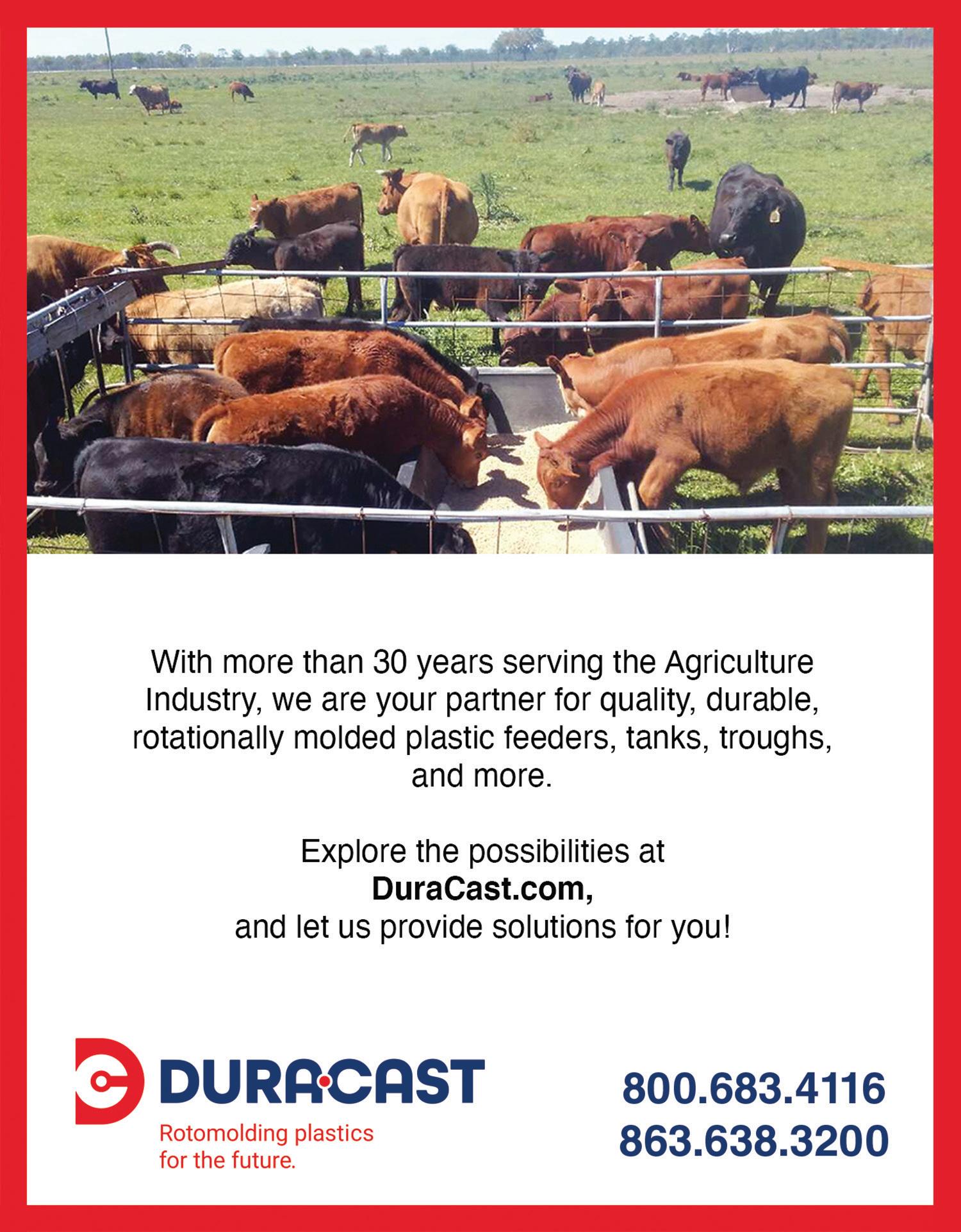
you to invest your hard earned money to advance the entire beef industry, so many of you want to share your opinions about the Checkoff and its value. Lately, I’ve been referring producers to the results of the recent independent, third-party return on investment (ROI) study.
Every five years, all U.S. commodity boards commission an independent study to evaluate their programs’ effectiveness, a requirement of the USDA’s Agricultural Marketing Service (AMS) oversight of these programs. Even if the CBB wasn’t required to commission this study, this information is essential. You wouldn’t invest money without expecting — and deserving — updates on your investment’s performance. Checkoff investments should be no different.
Released in early July, the latest ROI study, conducted by Dr. Harry Kaiser of Cornell University, found that each dollar invested in national Beef Checkoff demand driving activities from 2019 to 2023 positively impacted domestic beef demand and U.S. beef exports. In fact, it created a total financial benefit of $13.41 for producers and importers who paid into the program.
Dr. Kaiser’s analysis also examined what beef demand would have been over the past five years without investments in the national Beef Checkoff. The study found that total domestic beef demand would have been 8.5 percent lower per year, steer prices would have been 7.8 percent lower per year and U.S. export beef demand would have been 11.5 percent lower. All in all, the national Beef Checkoff added an incremental $3.3 billion to the beef industry
in 2023 alone. That $3.3 billion also had positive indirect effects by adding $4.1 billion to the U.S. economy and generating a nearly $9.5 billion increase in the U.S. GDP (Gross Domestic Product).
CBB’s hope is that the study’s findings will give more producers confidence in the Beef Checkoff and help you all trust that we’re spending your money wisely. We want producers to know that by investing our national Checkoff dollars into bigger and better demand-driving promotional, research, and educational programs, we’re creating opportunities to increase overall revenue for those who pay into the program, which can lead to greater financial benefits for everyone involved over time.
But the value of the ROI study doesn’t end there. The CBB takes this data very seriously, and while a return of $13.41 sounds great, we want to do even better. The ROI study isn’t simply a platform for the CBB and the national Beef Checkoff to rest upon. It gives us information that we can use, in coordination with organizational long term goals and the strategic initiatives of the Beef Industry Long Range Plan (LRP), to help shape current and future national Beef Checkoff programs.
As we move into the last month of FY 2024 and begin allocating national Beef Checkoff program funds for FY 2025, the ROI study’s data will be a tool to help make the best possible decisions on behalf of beef producers and importers, with the goal that those decisions will continue to propel the industry forward.

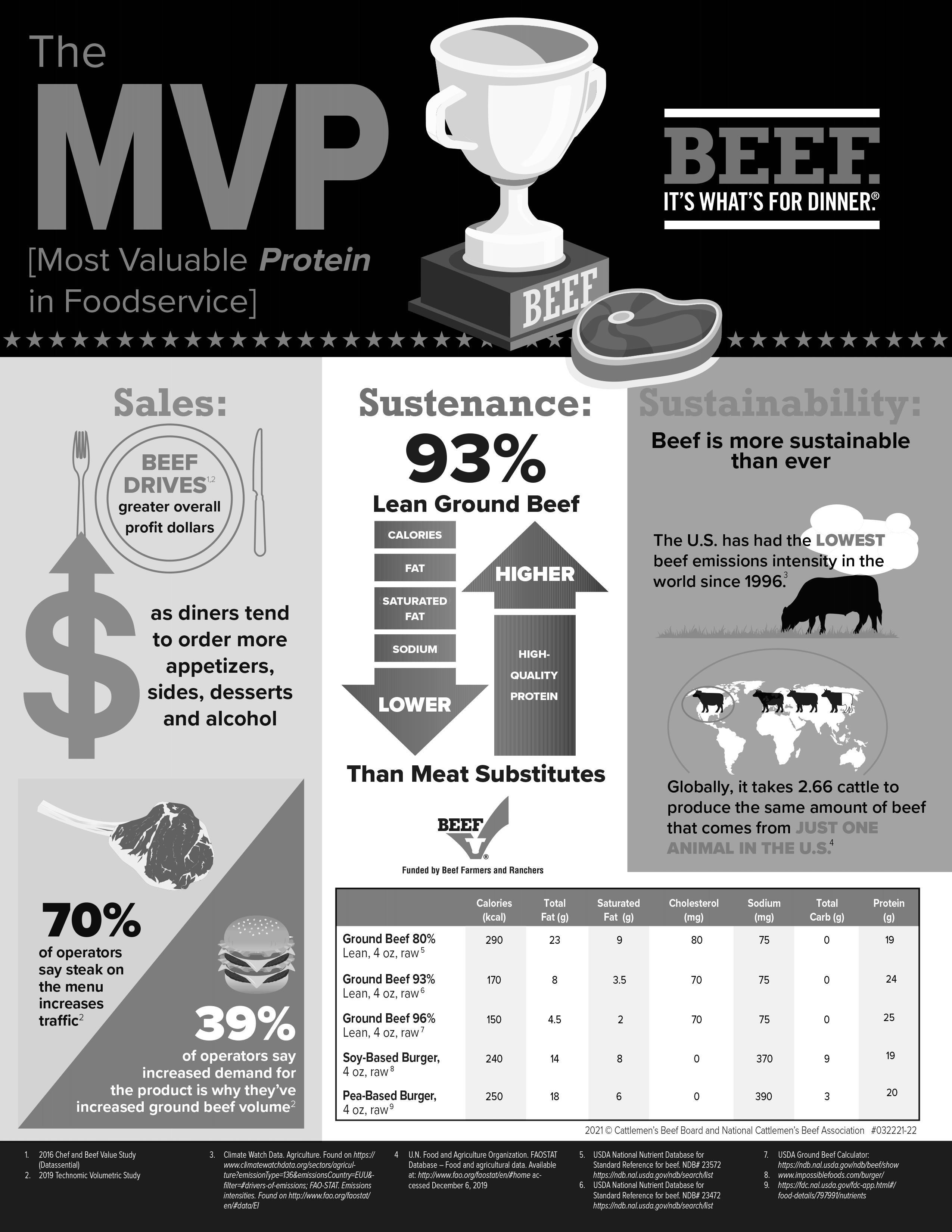

Khala Campbell Joins BioZyme Sales Team. Khala Campbell, Meadowview, Virginia, is the new Area Sales Manager for BioZyme Inc. in Virginia, North Carolina, and South Carolina. In her role, she will work with our dealer network, promote the BioZyme family of brands, and collaborate with dealers and customers. As with everyone at BioZyme, her goal is to empower our customers and partners as they improve their animals’ health and nutrition.
ASMs identify and cultivate new customers, partner and grow opportunities, work associated trade shows, and attend events to help grow the business of the assigned territory.
Campbell is a native of southwest Virginia. She has used BioZyme products in a progressive stocker operation and sold them in a BioZyme dealership, where she worked as facility manager. She is excited to get back out among the people and livestock and share her personal experiences with customers to help animals perform to their optimum and feel their best.
Learn More About Khala Campbell – “My true happiness is with animals. I’m really excited to help animals and be back out among them and show the producers that these products do what they say they do,” Campbell said. “It will also be exciting to help the dealers and work with them to grow their business, especially in an area where they haven’t had anyone for a while.”
Campbell is a devoted livestock and youth supporter and enthusiast. She was active in 4-H and FFA and earned her State FFA Degree. She studied farm business management and accounting at Virginia Highlands Community College. Her pride and joy are her two children, Ryan and Ryleigh, who are also involved in FFA, horses, and rodeo. Campbell enjoys spending time with her kids and their activities, friends, and a good book.
“Khala brings a renewed enthusiasm to the Carolinas and Virginia that our dealers and customers should appreciate. She loves helping people and animals, and she embodies care that comes full circle,” said Paul Hill, Director of National Sales.
“Additionally, Khala has personal experience using these products and knows how they work. So, she is selling them with experience, not just from a training manual.”
The American Rancher Features KT Cattle Inc., VitaFerm. When ranching is in your blood, you go where you are called. That’s true even if where you are called is the sparse land of southern Arizona, where average rainfall is minimal and the cows outnumber the people. For the Best family, that call to move from New Mexico and West Texas happened in 1996, and they have not looked back.
KT Cattle Inc., Douglas, Arizona, named after brothers Klancy and Trey Best, features the fourth and fifth generations raising cattle and horses on their ranches in Arizona and New Mexico. The sixth generation is also on the ranch, at 5 and 3 years old, with aspirations of taking the reins someday. Klancy, Trey, their parents, Kyle and Amy Best, and their significant others, Klancy’s wife, Kaysha, and Trey’s fiancé, Kasey, make up the day-to-day operations. Another cousin helps operate the ranch near Farmington, New Mexico.
“Raising Diamonds in the Rocks” is the KT Cattle motto, and they do just that. With rugged terrain in a big, spread out country, the cattle and horses that the Best family raise don’t get any pampering. They browse the brush for forage, and cattle might walk 3–4 miles for a water source. They do all that in the desert heat while still experiencing breedbacks close to 95 percent.
The Difference Quality Mineral Can Make – “Before we used Concept•Aid, our breed up would be in the 80s, somewhere between 80 and 85 percent. And when we started using Concept•Aid even in bad years, we can still get it up toward the mid-90s. You’ve got to understand that a lot of these cows that we have are sale barn cows…and people don’t think that it’s possible. You can take a sale barn cow and have her on the right nutrition, and that cow will breed back just like a cow… raised on that ranch,” said Kyle Best, patriarch of the ranch.
“And I’m talking about all of our cows. We get 92–95 percent [conception rate] every year, year in and year out. With the same program, nothing changed besides feeding them the Concept•Aid.”
KT Cattle feeds VitaFerm Concept•Aid HEAT with ClariFly, VitaFerm 30-13 percent Protein Tubs, and VitaFerm Concept•Aid. In addition to feeding the BioZyme products, Kyle and Amy are also BioZyme dealers.
The Best family gives a lot of credit
to the AO-Biotics Amaferm, the key ingredient in the VitaFerm products. Amaferm is how VitaFerm is so effective at helping your herd thrive. Amaferm is a prebiotic research proven to enhance digestibility. It helps convert what little forage their cows do find into usable nutrition.
“You know, the more you can get them to graze, the more they milk, and the more yearlings gain. I mean, grazing is what it’s all about. And as long as you have something for them to graze on, if they are grazing, then you’re gaining,” Kyle said.
KT Cattle sells bulls across the Western United States. They also market their calves through Superior. KT Cattle was named the 2022 AQHA Ranching Heritage Breeder of the Year. They raise their horses much like they raise their cattle — on the rough terrain around cattle to be ranch horses.
Protein Tubs for Cattle Offer
Convenient Nutrition. Time and labor — two precious resources that every cattle producer wishes they had more of. The two go together not just in production agriculture but in life. There’s always more to get done, but not enough time to do it. On a ranch, in particular, it’s an age old struggle.
What if we told you there is a way to supplement your herd with the added nutrition and protein they need that could save time and labor? And those are just a few advantages that a protein tub offers.
Protein tubs for cattle offer convenient nutrition as well as the complete sources of nutrition that your cow herd needs. How do we know that?
We here on the VitaFerm Team are cattle producers just like you. We understand the importance of quality nutrition and know that time is a precious commodity. That’s why we wanted to share this information about the convenient nutrition that protein tubs offer.
Benefits of Protein Tubs for Cattle
– Protein tubs for cattle offer several benefits, particularly in situations where traditional feeding methods might not be practical or efficient. Here are some of the key benefits:
Convenience & Labor Savings
• Low Maintenance – Protein tubs require less labor compared to daily feeding. You can save time and reduce labor costs by not needing to mix, prepare, or deliver the protein. The primary advantage of feeding protein supplements to cattle in tubs is convenience.
Producers have a self contained product that is easy to distribute. Our 200 pound tubs are relatively easy to scatter across large pastures, and their bright orange color makes them highly visible to the producer.
• Weather Resistant – Most protein tubs are weather resistant, meaning they can be left out in the pasture without concern for spoilage, even in harsh weather conditions.
Consistent Protein Intake
• Self Regulation – Protein tubs allow cattle to self regulate their intake, ensuring cattle receive consistent amounts of protein without the need for daily feedings.
Other companies use a chemically hardened method, adding corn syrup and other ingredients to bind the minerals together. VitaFerm tubs include a cooked tub technology that relies on molasses, which helps regulate your herd’s intake.
“The advantage of cooked molasses in the VitaFerm tubs is that the only way to soften the tub is moisture in the air, giving it a unique way to soften and control intake. The cows can lick all day on the tub, but until it softens, they won’t get more of it. If managed correctly, with the right number of cows, our tubs control intake practically by themselves,” said Chris Cassady, Ph.D., BioZyme Director of Beef Technical Sales.
• Continuous Availability – Protein tubs are available 24/7, allowing cattle to consume protein as needed. This is especially beneficial during times when forage quality is low.
Improved Forage Utilization
• Enhanced Digestibility – Protein tubs often contain ingredients that improve rumen function, increasing the digestibility of low quality forages. This helps cattle make better use of available forage, leading to better overall nutrition.
VitaFerm protein tubs are powered by AO-Biotics Amaferm, a prebiotic research proven to enhance digestibility. Therefore, in addition to the protein and other nutrients, Amaferm helps increase digestibility in your animals, which leads to our next point.
• Encourages Grazing – By providing supplemental protein and Amaferm, our protein tubs for cattle encourage more extensive grazing, even on poor quality pastures, thereby improving overall forage intake.
Supports Health & Productivity
• Boosts Immune Function – Adequate protein is essential for maintaining a strong immune system, which helps in disease prevention, especially during stressful periods like calving or weaning.
• Enhances Reproductive Performance – Protein supplementation supports better reproductive health, leading to improved conception rates and healthier calves.
Supports Weight Gain – Especially during the winter or drought conditions when forage is less available, protein tubs help maintain or even increase weight gain in cattle by providing essential
Flexibility in Supplementation –Protein tubs are versatile and usable in various situations. You can get the most out of tubs during dry seasons, in areas with poor pasture quality, or when cattle are on a maintenance diet with minimal supplemental feed.
VitaFerm Offers Protein Tubs for Cattle – At VitaFerm, we know that producers want options. That’s why, in addition to the loose mineral that you can feed free choice or mix in with your TMR, we also offer three options of protein tubs. All tubs contain Amaferm, a prebiotic research proven to enhance digestibility.
VitaFerm Concept•Aid Protein Tub
– VitaFerm Concept•Aid Protein Tub is a premium protein tub with vitamins and minerals for beef cattle on grass pasture. It supports reproductive success in cattle on low protein forage.
• Includes 20 percent natural protein along with organic copper, iodine, and zinc for maximum bioavailability, innate immunity, and hoof health.
• High levels of Vitamin E support reproductive tract repair and milk quality.
VitaFerm 30–13% Protein Tub – For producers seeking an affordable solution, there’s VitaFerm 30–13% Protein Tub. Our 30–13% Tub supports beef cattle with urea and natural protein designed to support herd health and performance while conserving cost.
• Includes 30 percent urea protein with no more than 13 percent equivalent crude protein from non-protein nitrogen.
• Features a complete, but economical vitamin and mineral package.
VitaFerm Conserve Protein Tub
– We offer VitaFerm Conserve Protein Tub, a natural protein tub for beef cattle designed to support herd health and performance while conserving cost.
• Includes 20 percent natural protein.
• Features a complete, but economical vitamin and mineral package.
“Providing cattle with a proper supplement that contains adequate minerals is important, as it serves as an insurance policy for seasonal fluctuations in forage quality and can keep cattle
from becoming deficient or imbalanced in energy, protein or mineral status,” Cassady said.
BioZyme Products are Research Proven – Amaferm is the key additive in all VitaFerm products. It has over 111 published and/or presented research studies, proving its increase in digestibility and, ultimately, its impact on the animal’s health and performance.
“Research proves that cattle fed Amaferm synthesize 100 more grams of microbial protein each day. That’s enough protein, equivalent to a pound of supplemented soybean meal, available for the cow or heifer. This additional protein generated from Amaferm in a yearround supplemental program can help producers reduce their need for additional protein by up to 30 percent annually, a huge continuous savings on feed costs,” Cassady said.
Get Your VitaFerm Protein Tubs Today – Providing adequate protein supplements for cattle is paramount to your herd’s success in all phases of production. At BioZyme, we give you
options within the VitaFerm brand. Not sure what to feed cows when it comes to VitaFerm? Check out our Concept•Aid Product Navigator.
About BioZyme Inc. BioZyme Inc., founded in 1951, develops and manufactures natural, proprietary products focused on animal nutrition, health, and microbiology. With a continued commitment to research, BioZyme offers a complete line of feed additives and high density, highly available vitamin, mineral, trace mineral, and protein supplements for a variety of animals.
The species we serve include cattle, pigs, poultry, sheep, goats, horses, and dogs. BioZyme brands include AO-Biotics, VitaFerm, Gain Smart, Sure Champ, Vitalize, DuraFerm, and Backyard Boost. With headquarters in St. Joseph, Missouri, the company reaches a global market of customers that stretches into countries across five continents. For more information about BioZyme, visit www.biozymeinc.com


Parasite management is a foundation for herd health at Buford Ranch. Efficiency and efficacy are the two things Doug Branch is looking for in a parasite control program. As manager of the Buford Ranch Osage Division in Oklahoma, Branch oversees a registered herd of Hereford cattle, a large part of the ranch’s commercial cow/calf herd, and a registered Quarter Horse operation. Keeping the cows and calves healthy with a solid vaccination and parasite management program is important to the ranch’s success.
“With spring calving and fall calving herds, we are always doing something with the cattle,” said Branch. “We are fortunate that the cattle can graze the majority of the year, so managing our forages is critical. That is also why parasite management is so important for our operation.”
Branch noticed some rough hair coats showing up, and it just didn’t seem like cattle were responding the same way after being treated with parasite control products. “I suspected that we had some resistance, but I wasn’t sure,” said Branch. “We agreed to participate in an Oklahoma State University research project about the prevalence of resistant parasites in Oklahoma cowherds.”
As part of the project, university researchers pulled individual fecal samples from the ranch’s spring born bred Hereford heifers to conduct fecal egg count reduction tests (FECRT). Half
the heifers were treated with Dectomax Injectable, and the other half received Ivomec Plus. Then, 14 days later, fecal samples were pulled again. “The reduction of egg counts wasn’t as high as it should have been, indicating we were seeing some resistance issues with our parasite management program,” said Branch.
With that knowledge, Branch reached out to his Zoetis sales representative, Dalton Brown, his local veterinarian, Dr. Trace Lenaburg, and the local Oklahoma State University extension agent, Rick Clovis, to discuss options. “I believe in pooling the best information from trusted experts when making decisions about herd health and nutrition,” said Branch.
Brown met with the ranch team and their veterinarian to tell them about Valcor ( doramectin and levamisole injection), its two active ingredients, and how the ingredients work together for effective parasite control.
In August 2023, Branch made the decision to use Valcor on the fall calving cows, about a month before they began calving. “We needed a person on each side of the chute to split the dosage, but it was still more convenient to use one product with a single administration type,” said the ranch manager. “It was also less stressful not needing to catch heads to administer an oral drench along with a topical product like we had done before under our veterinarian’s direction.”
The ranch also did another FECRT
on the spring heifers, following the same protocol as the university research study. This time, Branch treated the heifers with Valcor and saw a 99 percent reduction in fecal egg counts.
“The product works well, and we saw great results with our early use,” said Branch. “The cost to use Valcor is 70¢ more per head than using an oral drench and a topical parasite control product, but the convenience of using one product that is effective against potentially tough worms more than outweighs the additional cost.”
The results at Buford Ranch are similar to the results from research done on the product prior to and after it came to market. Valcor consistently exceeded 99 percent fecal egg count reduction in studies with more than 6,300 head of cattle in multiple locations across the country.1-6
For more information on Valcor, visit your local veterinarian or go to www. ValcorTough.com
1 Data on file, Study Report No. A131R-US-21-940, Zoetis Inc.
2 Data on file, Study Report No. A131C-US-16-504, Zoetis Inc.
3 Data on file, Study Report No. A131C-US-17-538, Zoetis Inc.
4 Data on file, Study Report No. A136C-US-17-554, Zoetis Inc.
5 Data on file, Study Report No. A131R-US-20-812, Zoetis Inc.
6 Data on file, Study Report No. 22CRGPAR-01-01, Zoetis Inc.
Capitalize on calf prices with a strong preconditioning program. A successful preconditioning program will set calves up for optimal future health and performance while enabling producers to command full market value on their calves, said Phillip Kesterson, DVM, with
Zoetis beef technical services and based in western Nebraska. Preconditioned calves are four times less likely to get sick in the feedyard, so it’s the right thing to do from an animal stewardship perspective, too.1
“A strong preconditioning sets animals up for success in their next production stage,” added Jeffrey Sarchet, DVM, Zoetis beef technical services. Sarchet works with cattle producers across sectors in Texas, Oklahoma, and Kansas. He often sees firsthand how preconditioning programs pay off.
“Preconditioned calves are more equipped to handle stressful situations and will shrink approximately half as much as non-preconditioned calves,” Sarchet said. “When we get paid by the pound, the extra pounds really pay.”
And as calf prices continue to go up, preconditioning can add even more value.
“We’re coming off a mild winter and a good forage year. Winter feed costs were down, and current calf prices are promising,” Kesterson said. “Cow/calf producers can capitalize on this window of opportunity with a properly timed and well executed calf vaccination program.”
Here are some of the veterinarians’ top tips for ensuring preconditioning programs pay off:
1. Allow time for vaccinations to do their job. Administer vaccines between three and eight weeks prior to weaning to allow calves enough time to mount an effective immune response.
If calves are initially vaccinated at weaning or only a week ahead of weaning, the time interval isn’t adequate for a complete immune response. “Weaning is a stressful time for calves, and administering vaccines during that time is going to make it more difficult to achieve the level of immunity that
we can achieve in a true pre-weaning preconditioning program,” Kesterson said.
2. Select vaccines with proven efficacy against core diseases. During the pre-weaning stage of your calf’s life, they’re beginning to rely on their own immune system. Vaccinating against core diseases at this time can result in a better response and a greater boost to their immune system for the next, more stressful phases of their life.
“This is an area where it’s important to consult your local veterinarian,” Kesterson said. “He or she will bring a lot of regional wisdom and can help you develop a preconditioning strategy with the appropriate products, timing, and dosage.”
3. Ensure proper handling and storage of vaccines. One of the greatest threats to vaccine efficacy, and ultimately animal performance, is mishandling before the product is ever administered. “Far too often we use an old refrigerator that wasn’t adequate for the house, and we dedicate that as a vaccine storage refrigerator,” Kesterson said. One University of Arkansas study tested 191 on-farm refrigerators and found 76 percent were unacceptable for storing pharmaceuticals because temperatures were not consistently maintained between 35°F and 45°F.2
4. Identify ways to add value and protect calf well being. “Vaccination timing can easily coincide with internal parasite control or implanting for greater labor efficiencies,” Kesterson said. Administering a dewormer is a great way to protect calves against internal parasites that threaten weight gain and profit potential.
And depending on your operation’s goals, you can drive additional calf value by implanting during this time. “A common misconception is that preconditioned calves get too soft or too fleshy and bring less money,” Sarchet said. “Implants are an easy workaround to this scenario because they enhance lean muscle development and help increase overall growth.”
5. Consider alternative marketing options. The truth is that calves will get sold whether they are preconditioned or not, especially in this market. However, there are multiple ways that you can command greater value for your preconditioned calves. “One option is a SelectVAC program,” Sarchet said.
Selling cattle with a history in a verified preconditioning program, such as SelectVAC, provides transparency to buyers because the program documents which products were administered and when.
Western Video Market data shows the value of calves enrolled in SelectVAC over a recent five year period — Calves enrolled in WeanVAC earned $17.27 per head more than non-enrolled calves, and calves enrolled in PreVAC+ earned $10.85 per head more than non-enrolled calves.3
Another simple marketing strategy that’s growing in popularity is price insurance,” Sarchet said. “If you’re hesitant to hold calves, this method can help ensure you get the price you want for the calves when you’re ready to sell them.”
6. Consult local experts. “A preconditioning program is not as simple as checking a box on a sale listing,” Kesterson concluded. Preconditioning programs do require some additional planning and, in many cases, an analysis of the market in your area.
“In addition to working with your local veterinarian, consult other producers who have seen success in preconditioning calves,” Sarchet added. “They can tell you what works, what doesn’t work, and what they’re doing to ensure their calves bring a profit.”
To learn more about developing a strong preconditioning program, visit with your local veterinarian or go to BuildingHealthyHerds.com References
1Seeger J.T., Grotelueschen D.M., Stokka G.S., and Sides G.E. Comparison of the feedlot health, nutritional performance, carcass characteristics, and economic value of unweaned beef calves with an unknown health history, and weaned beef calves receiving various herd of origin health protocols. Bov Pract. 2008;42(1):1-13.
2 Troxel T.R., Barham B.L. Case Study: The Temperature Variability of Refrigerators Storing Animal Health Products, The Prof. Ani. Scientist. 2009;25:202–206.
3Western Video Market data from 2018 to 2022 supporting value of calves enrolled in SelectVAC.
About Zoetis. As the world’s leading animal health company, Zoetis is driven by a singular purpose: to nurture our world and humankind by advancing care for animals. After innovating ways to predict, prevent, detect, and treat animal illness for more than 70 years, Zoetis continues to stand by those raising and caring for animals worldwide –from veterinarians and pet owners to livestock farmers and ranchers. The company’s leading portfolio and pipeline of medicines, vaccines, diagnostics, and technologies make a difference in over 100 countries. For more information, visit www.zoetis.com

Renovo Seed announces 2025 elite alfalfa lineup backed by extensive trials. Renovo Seed will offer eight elite alfalfa varieties and three of their famous AlfaGrass mixes in their 2025 product lineup. The products, which are tested in multi-year, multi-harvest plots prior to release, are poised to fit the specific forage needs of farmers and ranchers.
“We’re very excited about this year’s alfalfa and AlfaGrass lineup,” shared Justin Fruechte, Ag Product Expert for the brand. “It’s an interesting time in the alfalfa market. Many brands are backing away from, or even completely eliminating, their alfalfa offering. Renovo is making sure we have excellent options. We have been a steady alfalfa supplier for many years, and we’ll continue offering it for decades to come,” he continued.
Renovo Seed invests many years into alfalfa trials, ensuring the varieties in their lineup can be trusted for quality forage and strong persistence.
“I’ve seen a lot of alfalfa in my days, but I’ve rarely seen a seed company invest this much into their alfalfa vetting process. We take the time to make sure the Renovo Seed alfalfa varieties are top tier, no matter what your conditions are. Whether you’re in the western plains or the eastern corn belt, we have an alfalfa or AlfaGrass variety to fit your operation,” shares Matt Metzger, Sales Account Manager for Renovo Seed.
The Renovo Seed alfalfa lineup offers a variety of products, including everything from a Fall Dormancy 3 option for areas with harsh winters to a non-dormant alfalfa suitable for southern climates. With forage quality top of mind, Renovo Seed alfalfa and AlfaGrass mixes take yield and persistence to the next level.
The 2025 Renovo Seed alfalfa lineup includes:
• SurvivorPlus – A 3.0 fall dormancy blend with diversity to ensure a great stand in a variety of situations.
• Hopper Stopper – This option is highly resistant to potato leaf hopper pressure and comes in at a 3.7 fall dormancy.
• SalinityMax – Built for your high moisture acres, this product was selected from saline seeps. It is rated at a 4.0 fall dormancy.
• Prime Cut – This 4.2 fall dormancy
variety was selected for its lower lignin content and outstanding RFQ and digestible fiber scores.
• Final Answer – A yield leader when using conventionally bred alfalfa. This 4.3 fall dormancy is an excellent choice for beef and dairy producers.
• Paramount RR – If you need an alfalfa variety with Roundup Ready Technology, this 4.4 fall dormancy variety is for you.
• Full Throttle – This beautiful, bushy plant is a 6.0 fall dormancy and offers a full pest resistance package.
• Scorpion – Coming in at a level 9 fall dormancy, Scorpion is suitable for hot southern climates, extremely persistent, and has quick recovery.
Renovo Seed’s AlfaGrass options are:
• Haymaker – This combination of alfalfa, pubescent wheatgrass, intermediate wheatgrass, and meadow brome creates quality hay and consistently produces in challenging dryland conditions.
• The Hamilton – Designed for high salinity areas, this seven species combination is suitable for haying or grazing in otherwise unproductive areas.
• The Stockman – The Stockman combines the highest yielding and best quality grasses and alfalfa for excellent longevity and a great ratio of alfalfa to grass.
To learn more or to see agronomic details for each variety, visit RenovoSeed. com
About Renovo Seed. Renovo Seed is a visionary in the seed industry, focusing on positive land use solutions. Backed by Millborn’s powerful supply chain, Renovo Seed works to improve the resiliency of the land for generations to come with a robust seed lineup and an unmatched team of experts who design practical, tailored solutions for farmers, ranchers, and landowners. For more information, visit RenovoSeed.com
About Millborn. With high quality seed products, a unique, vertically integrated supply chain, and a team of experts who understand the industry, Millborn is the single source for agriculture, conservation, reclamation, and commercial seed needs. For more information, visit MillbornSeeds.com
By BLAKE LAYTON Mississippi State University
Fall armyworms are the most damaging insect pests in Mississippi hayfields and pastures. These caterpillars can destroy a cutting of bermudagrass in just a few days, and good bermudagrass can produce a few hundred dollars’ worth of hay per acre! Experienced cattle and hay producers know to look for fall armyworms throughout the growing season and to be ready to treat quickly when damaging infestations occur.
Fall armyworms are unpredictable pests. Some years, high populations do not occur until early fall, and the most heavily infested fields require only one or two sprays. Other years, damaging infestations appear as early as June, and some fields require six or more treatments. One reason they are so unpredictable is that fall armyworms cannot survive the winter here in Mississippi. Populations rebuild every year from moths that fly in from locations farther south, such as South America, the Caribbean Islands, and southern Florida. Some years, the moths arrive earlier than others or find better growing conditions once they get here. This is also the reason infestations usually occur earlier and more often in the southern part
of the state, and populations are highest in late summer and fall. After they fly in from the south, it usually takes them a few generations to build up to damaging numbers.
Identification – Fall armyworm caterpillars vary in color depending on their stage of development and diet. Most are green or tan, but some can be dark brown to almost black, especially late in the year when numbers are high, as seen in Figure 1. The body is punctuated with dark spots. Most notably, there are four spots at the rear of the body that form a square. Mature caterpillars are about 1½ inch long and are mostly slick bodied, with a few small, stiff hairs visible up close. The head capsule ranges from light brown to dark brown, and, on larger specimens, there is a distinct white inverted Y shape on the head. This Y and the square of four spots on the rear are two of the best ways to identify fall armyworm caterpillars, as seen in Figure 2.
Fall armyworm moths are about ¾ of an inch long when resting with their wings folded. The forewings are gray to dark brown, but the underwings are white, which causes the moths to appear pale when in flight. Males have more



2. Fall armyworm caterpillars have smooth bodies with a few stiff hairs. Note the inverted, white Y or V shape on the head. All caterpillars have this structure, but it is particularly obvious on fall armyworms.
white markings on their forewings than females do, as seen in Figure 3. Moths are active at night and spend the day resting in foliage. You will not often see the moths unless you go out at night with a spotlight to look for them or happen to flush one from its daytime resting place.
Caterpillars take about 14 days to complete their larval development, and it takes about a month to complete a generation, but the development rate varies considerably depending on temperature and other factors. As with most caterpillars, about 80 percent of

3. Male fall armyworm moths have light-colored markings on their forewings. Forewings of female moths are more uniformly gray. Moths of both sexes have light-colored hindwings. (Lyle Buss, Univ. of Florida, Bugwood.org)
Biology – Fall armyworm moths lay their eggs in clusters, or masses, containing around 50 eggs each. They cover each egg mass with light-colored scales from their bodies, giving the egg mass a white, fuzzy appearance. Eggs hatch in 2–5 days, and the newly emerged larvae scatter out and begin feeding, as seen in Table 1. They usually begin by feeding on the underside of the leaf blade, and at first, they do not feed through the clear upper epidermis. Their feeding habits result in tiny, white “windowpanes” in the leaf blades or a white frizzing of the leaf tips. Experienced cattle producers watch for this white frosting or frizzing of the leaf tips as an early warning of a fall armyworm infestation.
total leaf consumption occurs in the last 2–3 days of the caterpillar stage. This is why fall armyworm damage can occur so quickly; grass that looked fine Friday morning can be nothing but stems by Monday afternoon.
Fall armyworm caterpillars pupate by digging about an inch into the soil and forming a pupal chamber. Newly emerged female moths use pheromones to attract males. Mating occurs a few days after emergence, and females lay eggs about four days after emergence. Female moths live a couple of weeks and deposit around 1,500 eggs during their lifetimes. Depending on how early in the season fall armyworms arrive in an area, there can be two to five generations

Female moths live about 14 days and lay 1,000–2,000 eggs.
per year. Populations grow larger, often exponentially larger, with each generation. The moth flight of a given generation lasts a couple of weeks, and generations overlap by late summer. During heavy outbreaks, there can be almost continuous pressure, with new egg masses deposited every night.
Food Plants – Fall armyworms are primarily pests of grasses, including agricultural crops such as corn, sorghum, rice, and millet. They especially like bermudagrass, regardless of whether it is a dwarf variety growing on a golf green, a field of sports turf, or a forage variety being grown for hay. Lush, well fertilized grass is particularly attractive to egg laying moths, and this is why infestations are so common in well managed bermudagrass hayfields. Fall armyworms will eat other types of forage grass, and fields of bahiagrass, dallisgrass and other grasses are sometimes heavily attacked. Again, such infestations are more likely on well managed, highly fertilized fields. Some wide leafed weedy grasses, such as barnyardgrass and broadleaf signalgrass, are more preferred than bermudagrass,
and cattlemen and hay producers learn to watch stands of these grasses as an early indicator of fall armyworm problems. Fall armyworms will also attack early planted winter grazing crops like wheat and ryegrass and sometimes destroy stands as these crops are emerging. Newly emerging crops can be seriously damaged by much lower populations than are required to damage established stands of perennial grasses.
Be Prepared – Don’t wait until the hay field is teeming with big caterpillars to start thinking about the equipment you are going to use to spray them. Get your sprayer ready early in the season: be sure it is cleaned, repaired, and calibrated. Then you can act quickly when it is time to treat. It is also a good idea to know ahead of time what insecticide you plan to use, where you can buy it, how much it costs, and how quickly you can get it. If you plan to use one of the pyrethroid insecticides, be sure your pesticide applicator certification is up-to-date.
Warning Signs – Experienced forage producers learn to recognize the early signs of fall armyworm feeding. Newly

hatched caterpillars are too small to feed all the way through a leaf blade. They begin by feeding on the underside of the leaf but leave the clear upper epidermis intact. This creates tiny “windowpanes” in the grass blades that appear silver or white, as seen in Figure 4. When large numbers of small larvae are just beginning to damage a field, the grass often has a subtle “frosted” appearance because of these windowpanes. This is easier to see on the wide leaf blades of barnyard grass, which is a favorite food of fall armyworms. Learning what this looks like on barnyard grass can help you recognize it on bermudagrass. Recognizing this early sign of infestation can help save a cutting of hay.
Many producers watch for egrets and other birds feeding in a field as an indicator of fall armyworm problems. If you see birds in the pasture, you definitely want to check out what they are feeding on, but do not use this as your only way to check for armyworms. This
sign often comes too late to avoid damage because the birds don’t show up until the caterpillars are big enough to attract their attention.
Producers also become concerned about fall armyworms if they notice large numbers of moths flying in the headlights as they are driving through a field after dark. However, there are many other species of moths that occur in and around grass fields, sometimes in large numbers. Seeing large numbers of moths flying around your pasture or hay field is not sufficient reason to start spraying, but it is a good reason to start checking the field more closely for caterpillars.
Scouting and Treatment Threshold – The best way to avoid losing a cutting of hay to fall armyworms is to visit fields every three or four days and check for fall armyworms. Get out of the truck,
Continued on the next page

get down on your hands and knees, and look closely. Scout for fall armyworms by vigorously ruffling the grass with your fingers and carefully counting the larvae that have fallen to the ground in a one square foot area. Do this at several locations in the field and average your results. Treatment is recommended when counts exceed three caterpillars that are ¼ inch or longer per square foot, as seen in Figure 5. Be sure to look carefully for small caterpillars. You want to find and treat them when they are small because small caterpillars are easier to control and, more importantly, have not eaten nearly as much as they are going to eat.
Like most caterpillars, fall armyworms do about 80 percent of their eating during their last two to three days as larvae — when they are “teenage” caterpillars. Therefore, if a field has reached the threshold on Friday but is not scheduled to be cut until the next week, it needs to be treated as soon as possible. A moderate to heavy population of large fall armyworm caterpillars can eat a whole field of grass in just a couple of days, as seen in Figure 6. Be sure to pay attention to preharvest intervals when choosing an insecticide to use on a field that is near cutting!
Deciding Whether to Spray or to Cut – One option for dealing with an infestation of fall armyworms in hay fields is to just go ahead and cut the field. This can be a good choice, but only if the field is nearly ready to cut anyway and the forecast promises good hay curing weather. Be careful with this decision. If there are a lot of big caterpillars, they will “cut the field” for you in another couple of days. If you decide to go ahead and cut the field, you need to do it that day or the next morning. If there are threshold numbers of caterpillars, and it will be two

days or more before you can cut the field, you probably need to go ahead and spray.
When to Stop Scouting for Fall Armyworms – They are called fall armyworms because their populations are usually highest in the fall. In other words, they can damage the last cutting of hay if you stop scouting too early. During heavy outbreak years, fall armyworms will even destroy stands of early planted winter grass crops, such as wheat and ryegrass. Delaying planting until later in the fall is one way to avoid this problem. If you do plant winter grazing crops in early fall, check fields often and treat promptly if you detect an infestation. Be especially vigilant during years when fall armyworm pressure has been high in hayfields and pastures. It takes fewer caterpillars to destroy a field of emerging ryegrass than to eat a lush field of bermudagrass.
Like all insects, fall armyworm development rate is greatly affected by temperature. In one laboratory study, conducted with caterpillars feeding on corn leaves at constant temperatures, the

diflubenzuron is also restricted use. The primary reason for the restricted use classification is because of buffer zones along streams and around other bodies of water. See labels for specific details.
larval stage lasted about 22 days at 70ºF, 14 days at 80ºF, and 10 days at 90ºF. As you can see, development rate is faster at higher temperatures, although it does begin to decline at temperatures above 93ºF. Fall armyworms cannot survive freezing temperatures. Populations usually begin to decline a little before the first frost because fall armyworms cannot develop at temperatures below about 50°F.
The bottom line here is that you need to be concerned about fall armyworms in late fall hayfields and early planted winter grazing pastures until you stop seeing fall armyworms. Some years, the threat of fall armyworm infestations lasts longer than others. It depends on the weather, and late infestations are more likely during warm, “late” falls.
Insecticides for Fall Armyworms
– Although some older fall armyworm products like Sevin and Malathion are still available, there are many new products that are cheaper, more effective, provide longer residual control, and/or have more favorable pre-harvest intervals. These include several pyrethroid insecticides (zeta-cypermethrin, cyfluthrin, and gamma-cyhalothrin) and two insect growth disruptors (methoxyfenozide and diflubenzuron), as well as several more caterpillar specific products (chlorantraniliprole and spinosad). Growers need to be aware of the relative strengths and fit for each of these groups of insecticides.
The pyrethroid insecticides are all restricted use products, which means you must have a current pesticide applicator certification card to be able to buy and use these products. If you have significant acreage, it is worth the time and effort to get this certification because pyrethroids are effective, low cost fall armyworm treatments. The growth regulator
In addition to the brand name pyrethroids listed in Table 2, there are many generic pyrethroid products that are also labeled for use in forage crops. However, growers should be aware that not all pyrethroid products are labeled for use in hayfields and pastures. Check labels carefully before purchasing and applying products to be sure they are labeled for the intended use. If the label does not give specific information on use rates, preharvest interval, and pre-grazing interval for hayfields and pastures, then the product is not labeled for use in hayfields and pastures.
Table 2 lists treatment options for fall armyworms in hayfields and pastures. Although a rate range is given for most products, the low to mid range rate is usually adequate in most situations. When selecting insecticides, pay close attention to the preharvest interval and note that preharvest intervals can vary depending on whether the grass will be grazed or cut for hay. Also note that “days to harvest” means days until cutting, not baling.
When purchasing insecticides, you may also want to consider the number of acres one gallon of product will cover, the size of container the product is sold in, and the size of the field you need to spray. When treating smaller fields, the most economical option may be to choose a product/container size that will best “fit the field.”
When treating large acreages, it is worthwhile to compare costs on a per acre basis. When comparing costs, keep in mind that some products provide longer residual control than others. During years of heavy fall armyworm pressure, this can make the difference between having to spray once or twice rather than two or three times to make a cutting of hay. In general, the growth disruptor products (methoxyfenozide and diflubenzuron) provide longer control than the pyrethroids (zeta-cypermethrin, cyfluthrin, and gamma-cyhalothrin), but growth regulators are slower acting and are best used when caterpillars are small. Because rapidly growing grass results in new, untreated leaf area and dilutes insecticide residues, few treatments will provide more than about two weeks of control. Residual control may be considerably shorter during heavy outbreaks or following frequent or heavy rainfall.
Since they became readily available for use in forage crops, pyrethroids alone have been the standard treatment for fall armyworms, because of their high efficacy and low cost. However, in the heavy outbreak year of 2021, many producers experienced reduced control with pyrethroids alone, and growers who shifted to combinations of products, such as a pyrethroid plus one of the growth regulators (Intrepid or Dimilin), or who used one of the other caterpillar products (chlorantraniliprole or spinosad), experienced better or longer lasting control.
In some situations, it may be beneficial to apply a tank mix of two different products, with the first
component of the tank mix being one of the pyrethroid insecticides (zetacypermethrin, cyfluthrin, or gammacyhalothrin) and the second component being one of the growth disruptors (methoxyfenozide or diflubenzuron). This takes advantage of the fast-killing effect of the pyrethroid and the longer residual control provided by the growth regulator product. For example, if you have to spray a field you expect to harvest within 10-14 days or so, including a growth disruptor with the pyrethroid may help you avoid having to spray again before harvest.
Although the caterpillar specific treatments (chlorantraniliprole and spinosad) are more costly than
pyrethroids alone, they become more cost competitive when compared to the cost of a pyrethroid plus a growth regulator. Because these products tend to provide high levels of relatively long lasting control when applied alone, it is not usually necessary to tank mix with one of the growth regulators.
Fall armyworms populations are cyclic and vary greatly from year to year. During years of unusually high populations, it is not unusual to have to spray multiple times on a single cutting of hay. This is not necessarily an indication of insecticide failure or resistance, but is more likely due to sustained immigration of egg laying moths and/or unusually high infestation levels. (For example, if there
are 30 caterpillars per square foot, even 90 percent control still leaves three per square foot, which is the threshold level.) During heavy outbreak years, it becomes even more important for growers to check fields regularly and be prepared to treat promptly.
This work is partially supported by Crop Protection and Pest Management, Extension Implementation Program grant no. 2017-70006-27200/project accession no. 1014037 from the USDA National Institute of Food and Agriculture. Any opinions, findings, conclusions, or recommendations expressed in this publication are those of the author(s) and do not necessarily reflect the view of the U.S. Department of Agriculture.

1When applied to pastures that are being grazed, Dimilin will provide approximately 2 weeks of control of horn flies emerging from manure patties.
2Use rate given on the main Prevathon label is 14–20 fl. oz./acre. But a FIFRA 2(ee) label allows use for fall armyworm control in Mississippi at 10–13 fl. oz./acre. Expires December 31, 2025. This 2(ee) label must be in the user’s possession when using this lower rate.
3Use rate given on the main Vantacor label is 1.2–2.5 fl. oz./acre. But a FIFRA 2(ee) label allows use for fall armyworm control in Mississippi at 0.9 to 1.1 fl. oz./acre. Expires December 31, 2026. This 2(ee) label must be in the user’s possession when using this lower rate.
*This information is for preliminary planning purposes only. Carefully read the label of any product you plan to use, and follow all label directions and restrictions.
By JULIA HERMAN, DVM
Cattle health is closely monitored in each sector of the beef industry, and continuous improvement is expected from within and outside the industry. Fitness for transport is an important concept that applies to all cattle stages, from calves to feeders to cull cows and bulls. This live animal evaluation is critical to deciding whether an animal is able to withstand the rigors of transport, including standing for long periods of time in variable weather. The most visible aspect of the cattle industry is when cattle are moved across the country on wheels every day. Each stakeholder, from the cattle owner to the transporter, should strive for responsible transport decisions.
The 2022 National Beef Quality Audit ( www.bqa.org/resources ) shows cattle, beef, or dairy, are transported at least once and up to six times during their lifetime, so ensuring the health and welfare of these animals at each transport opportunity is a great responsibility. Trips to the auction market, the next pasture, backgrounding or finishing feedyards, and others are each an opportunity to improve animal welfare through transportation and fitness for transport decisions. The Beef Checkoff funded Beef Quality Assurance Transportation (BQAT) program was designed for guidance on these topics. The following are a few important aspects to consider when determining whether cattle are fit for transport.
Evaluate Cattle History – Violative residues are created when animals are slaughtered before the labeled withdrawal period on the medication label. It is important to always check treatment records and confirm animals have cleared drug withdrawal times before transporting them for sale or slaughter. Never ship an animal you do not think can withstand the rigors of transport or marketing. This includes not shipping extremely emaciated animals (BCS 2 or less on either the beef or dairy scale) or cattle with a lameness score of 3 or more (according to the North American Meat Institute scale of 1-4). Having a plan for caring for or humanely euthanizing a nonambulatory animal should be part of your protocol, since these animals cannot be slaughtered.
Prep the Cattle – It is important to provide cattle access to water up until they load onto the trailer, as it improves health in the short term and upon arrival. A modest meal within 24 hours prior to transport, especially trips longer than four hours, has also been shown to improve
cattle response during travel and at the destination. This is especially important for younger calves that are more prone to dehydration in hot weather. The duration of transport can have significant animal welfare outcomes, and preparing cattle for the trip can improve response to transport stressors. In addition, cattle may have multiple segments of their trip, so ensuring cattle can handle all legs of the trip is an important consideration when deciding to ship that animal.
Watch the Weather – Temperature and humidity can burden or improve the transport process. Pre-trip planning can help ensure cattle are loaded or unloaded in the most ideal part of the day. Pay close attention to the Temperature-Humidity Index to determine the risk of moving or working cattle during hotter weather. Another consideration for younger and smaller cattle is that they will need different loading densities vs older cattle in warmer weather. For instance, high loading densities can cause limited airflow and bruising. Airflow is especially important for cattle welfare, so if the trailer or cattle pot is unable to move or is waiting in line, driving around to increase air circulation in the trailer is one option.
Move Cattle Slowly – Animal handling is an integral piece of cattle health, especially during transportation events. Moving animals in a low stress, gentle, and quiet manner reduces stress on the cattle during and after transport, reducing the risk of a heat stress event. Using acceptable handling tools, such as flags or sorting sticks, as an extension of yourself when needed can improve the efficiency of cattle movement. Cattle prods should not be routinely used and should only be used in specific circumstances. Any kind of abuse is not tolerated, including overuse of cattle prods. These practices also reduce the risk of cattle going down at the plant or auction market as well as product defects such as dark cutters, bruising, and wasted product.
Be Proactive in Culling Decisions
– Many cull cows and bulls are culled due to a decrease in productivity and illness, such as lameness. Fed animals are culled for similar reasons. When cattle are culled proactively, these animals are in a comparatively healthier state with a slightly higher body condition and have less risk of becoming lame or going down in the trailer. Producers are encouraged to work to cull animals earlier in the disease process, like cancer eye, pneumonia, or
lameness, as long as drug withdrawal times are met, so animals can safely make it to their final destination without the risk of being condemned. Proactive culling can improve the welfare of the animal in addition to having a better product. NCBA created the Right Way. Right Time. A guide to cull cow management handout using results from the most recent audit results. Producers and veterinarians can use this resource to evaluate their cull cattle management strategies and improve decision making with fitness for transport decisions. Train workers to understand when animals should be humanely euthanized rather than being shipped, as an animal should not make a long transport journey only to go down on the trailer or at the plant and be euthanized then.
Conduct Self Assessments – Even with experienced cattle producers and drivers, complacency can sink in when performance is not evaluated. Work with a herd veterinarian, extension agent, or BQA state coordinator to conduct a self assessment on essential skills such as humane cattle stockmanship or facility management. Each operation has the responsibility to train their employees
in cattle behavior and handling to improve cattle welfare, human safety, and work efficiency. BQA provides a solid foundation for cattle producers and their teams, so the ‘why’ is understood for quality cattle care. Continuous improvement through consistent training only improves cattle care, human safety, and the final product.
Fitness for transport decisions influence both animal and human safety, which can be adapted and improved based on the operation’s goals, workforce, and facilities. Other workshops, such as Stockmanship & Stewardship ( www.stockmanshipandstewardship. org ), provide live animal handling demonstrations for professional drivers, farmers, and ranchers to improve their stockmanship skills. The BQAT program provides guidance on fitness for transport for animals, in addition to providing preparation steps to ensure safe trips for transporters. More information on BQAT’s guidelines and the certification course can be found at www.bqa.org
This article was also published in the Winter 2024 issue of Protein Producers magazine.
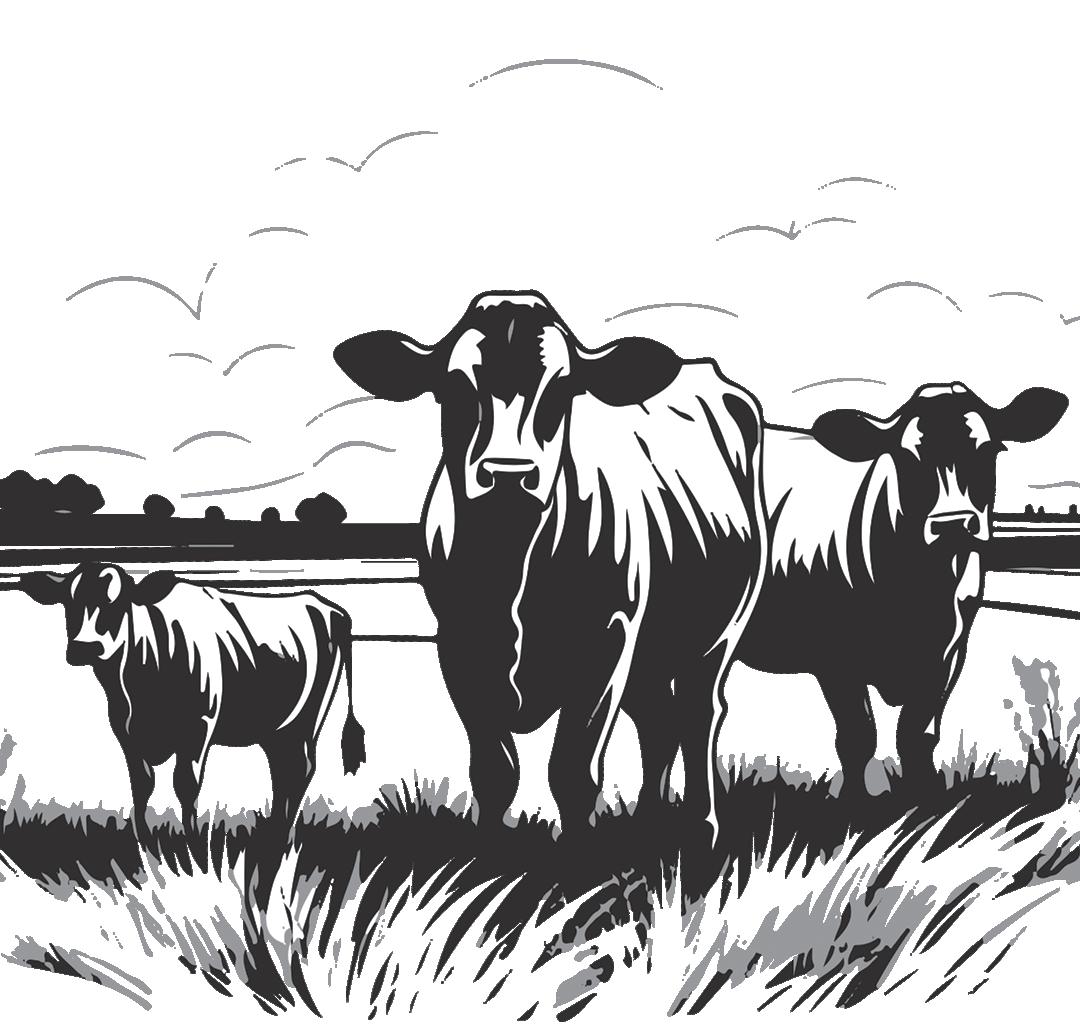

By COLIN WOODALL National Cattlemen’s Beef Association
In July’s edition of National Cattlemen, NCBA president Mark Eisele talked about the work we have done in fighting back against lab grown protein. This has been a priority issue for us, and Mark did an excellent job recapping recent developments. As I read his article, it got me thinking about all the work NCBA has done on the issue of fake meat, so I wanted to build on the piece he wrote.
In early 2019, Beyond Meat, Inc., was listed on NASDAQ with an initial public offering price of $25 per share. It started trading at almost twice that number, and, given the hype around their products, the stock price quickly rose to almost $235 per share by the end of July. Just a few weeks later, Burger King introduced their Impossible Whopper, and it seemed that was all we heard about for weeks. You, as our membership, made it clear that NCBA needed to step up and start punching. Thanks to the policy direction you gave us, we began our campaign and made the term “fake meat” one that was used in daily conversation. We illustrated how the ingredient lists of these products were similar to those of dog food. We pushed for accurate labels. More importantly, we were able to prove their claims about our environmental impact were absolutely false and misleading. From news stories to working with Congress, we were able to protect and defend beef.
The interesting thing about Beyond Meat and Impossible Foods is that they built their entire marketing campaigns around disparaging real beef. They forgot about the need to create a product the consumer actually wants and is willing to pay for. That became painfully clear to them during the pandemic when the consumer was cleaning out the beef case and leaving behind fully stocked displays of Beyond products. As I am writing this, Beyond Meat’s stock is trading around $6 per share. That is a drop of more than 95 percent from its high. As I was looking at the historical stock price chart, an article popped up about Beyond Meat with the

title “Some Ideas Are Too Bad To Invest In.” That pretty much sums up the state of plant based fake meat.
As Mark wrote about, though, we’re still in the game of defending our industry from lab grown protein. We’re not willing to call this stuff “fake meat” because we don’t know how it is produced. We know they take cells from cattle and put them in a bioreactor, along with a lot of other stuff that former NCBA President Todd Wilkinson famously calls “goop.” It is a good name, since the companies have not disclosed what it’s comprised of. Do you find it interesting that many of the people funding these companies are also the ones who are firmly against conventional agriculture and love to use the terms “factory farming” and “industrial agriculture?”
These companies have yet to create a product that imitates beef, but they haven’t given up. In the meantime, we have been successful in securing USDA’s role in inspecting these products. Lab grown protein companies like Upside Foods only wanted FDA to have jurisdiction over their manufacturing process. FDA uses a risk based inspection process, which means you might see an inspector once a week, once a month, or possibly once a year. Beef processing plants must have inspectors on the job every day. Since live bovine cells are being used in the bioreactor process, there is no reason to believe they would not be subject to many of the same foodborne threats we are. We succeeded in securing USDA’s role in the inspection process. That is a huge win for us. We must still work on ensuring these products are labeled accurately for the consumer, but that has not been an easy task with the Biden Administration.
In the meantime, the lab grown protein companies aren’t finding much love. Upside Foods cut its workforce and restructured its leadership team. SCiFi Foods, a California company focused only on lab grown protein from cattle cells, went out of business. Earlier this
summer, we discovered that the U.S. Department of Defense (DoD) was preparing to spend your tax dollars to fund another California company called BioMADE in developing a lab grown protein that would provide nutrient dense military rations for our men and women in the armed forces. There is no way NCBA was going to allow our troops to be treated like lab rats when beef is already a nutrient dense food available today. NCBA was on just about every news station talking about this waste of tax dollars and mistreatment of our armed forces personnel. We had a long line of Senators and Members of Congress

offering amendments to stop this. Retired Air Force Brigadier General Don Bacon represents the 2nd Congressional District of Nebraska and made it clear that this action by DoD was unacceptable to him as a Congressman and an Air Force veteran. I’m pleased to let you know NCBA killed that DoD project.
Nothing beats beef the way nature intended it to be. The consumer knows it and is showing their support through strong beef demand. The fake meat and lab grown companies continue to learn this lesson the hard way. This fight is far from being over, but NCBA will continue to lead in defending you.
Ranchers Support Legislation to Boost Conservation Under the ESA. Recently, the National Cattlemen’s Beef Association (NCBA) and Public Lands Council (PLC) announced their strong support for the ESA Amendments Act of 2024, introduced by Representatives Dan Newhouse (R-Wash.) and Bruce Westerman (R-Ark.). This legislation would reform the Endangered Species Act (ESA) to provide more timely conservation efforts on America’s rangeland.
“For too long, the Endangered Species Act has been weaponized to list species under non-science based criteria to the detriment of real conservation. Farmers and ranchers have witnessed the harm that comes from politically motivated species listings and the dangers that come from recovered predators that become a direct threat to producers’ personal safety and economic success,” said NCBA President and Wyoming rancher Mark Eisele. “NCBA is proud to endorse the ESA Amendments Act of 2024 and thanks Representatives Dan Newhouse and Bruce Westerman for their work to improve the ESA. This bill will make the ESA a real tool for conservation, foster transparency and accountability, and ensure that the environmental contributions from farmers and ranchers are properly recognized.”
As the ESA has had its scope widened over the years, it is now coming in direct conflict with established science on wildlife conservation. There are now peer reviewed studies showing that cattle help wildlife and the landscape by building robust habitat and increasing available forage through grazing. Current ESA rules
can reduce critical conservation work, limit the presence of cattle on working lands, as well as hurting wildlife and the overall ecosystem. The ESA Amendments Act is the product of years of stakeholder meetings and input, designed to provide regulatory relief to ranchers and help support rural communities that can be negatively impacted by the ESA.
“Since it was passed into law over 50 years ago, the Endangered Species Act has undergone several rulemakings that have weaponized this conservation tool against ranchers and working lands. The ESA Amendments Act of 2024 will safeguard the efficient operation of farms and ranches across the West and stop government red tape from getting in the way of extensive, voluntary conservation work already happening on our public lands,” said PLC President and Colorado rancher Mark Roeber. “This bill would modernize the ESA and help reform the law to make it an effective conservation tool once again. The Public Lands Council and ranchers across the West thank Reps. Dan Newhouse and Bruce Westerman for introducing this legislation to give significant regulatory relief to livestock producers.”
About the National Cattlemen’s Beef Association. NCBA has represented America’s cattle producers since 1898, preserving the heritage and strength of the industry through education and public policy. As the largest association of cattle producers, NCBA works to create new markets and increase demand for beef. Efforts are made possible through membership contributions. To join, contact NCBA at 866-BEEF-USA or membership@beef.org
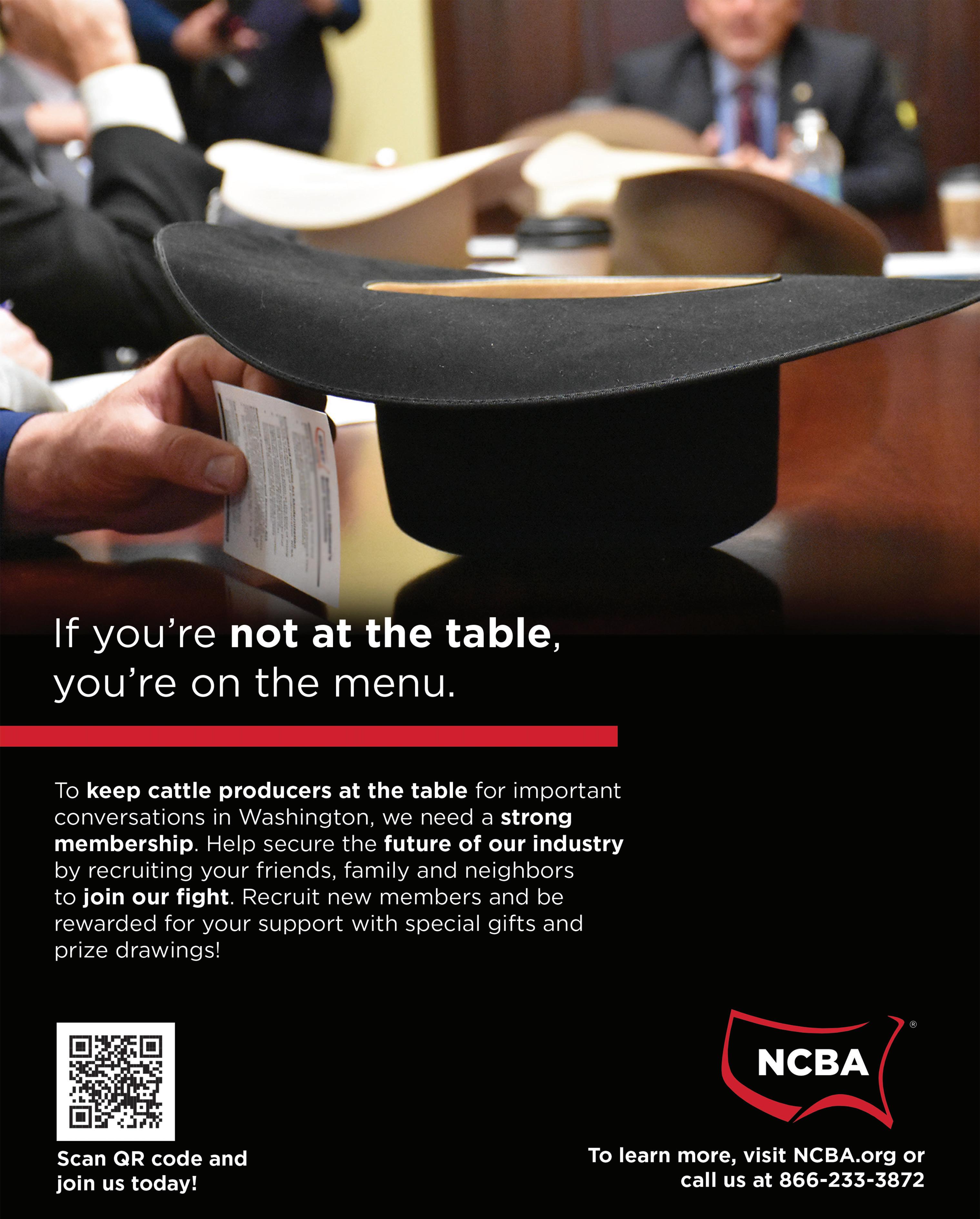


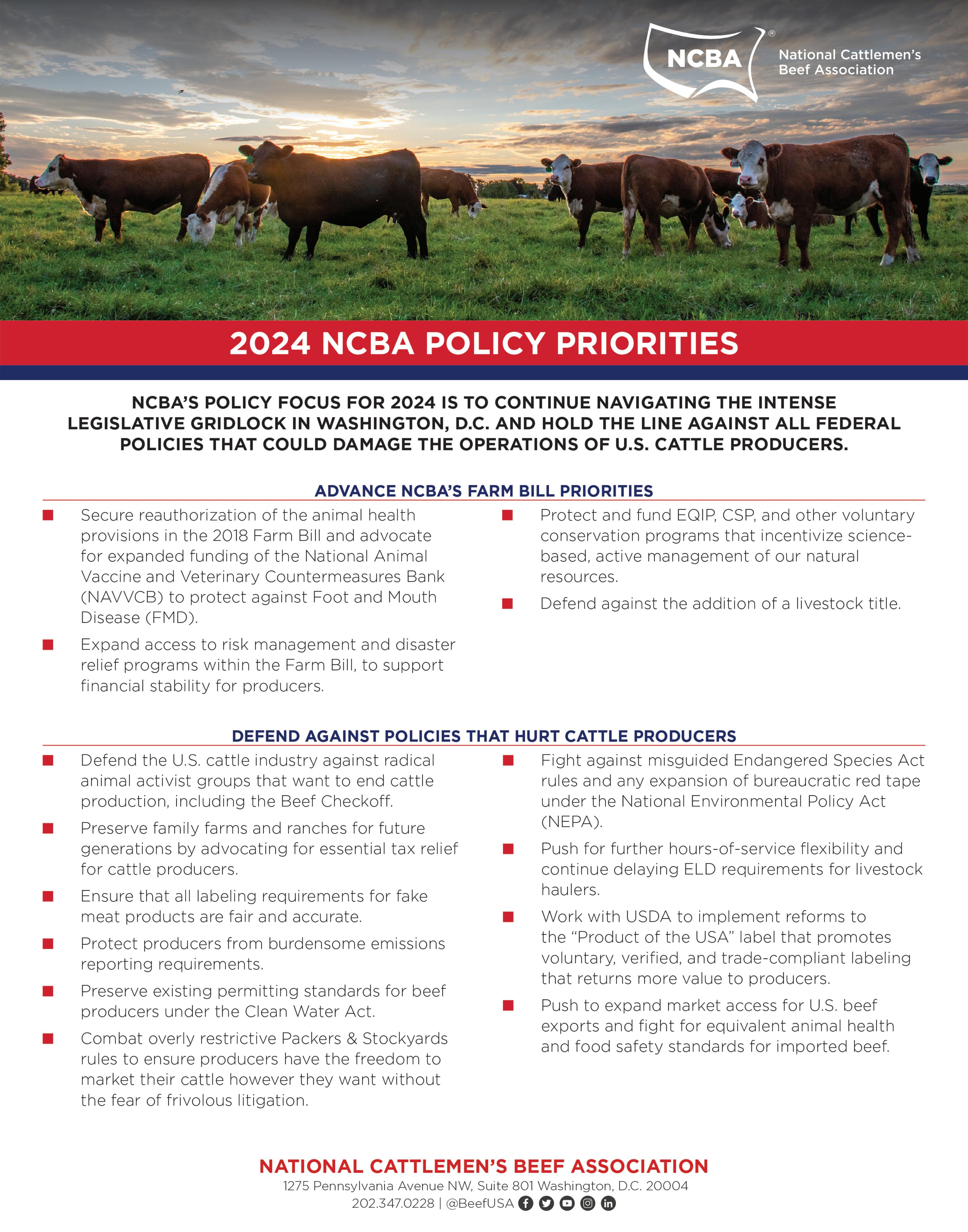
By MARK EISELE National Cattlemen’s Beef Association
The future of the U.S. cattle industry hinges on our ability to swiftly respond to disease outbreaks. Yet, some groups and individuals continue to fight the tools that could protect our livelihoods. The most recent rule to come under fire is USDA’s animal disease traceability regulation.
In the face of a potential foot-andmouth disease (FMD) outbreak, every minute counts. The choice between outdated methods and advanced technology could mean the difference between a controlled situation and a nationwide
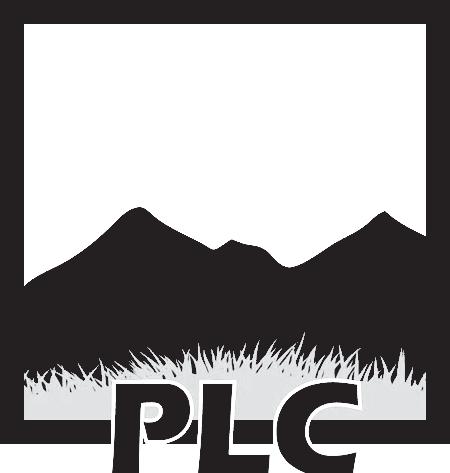
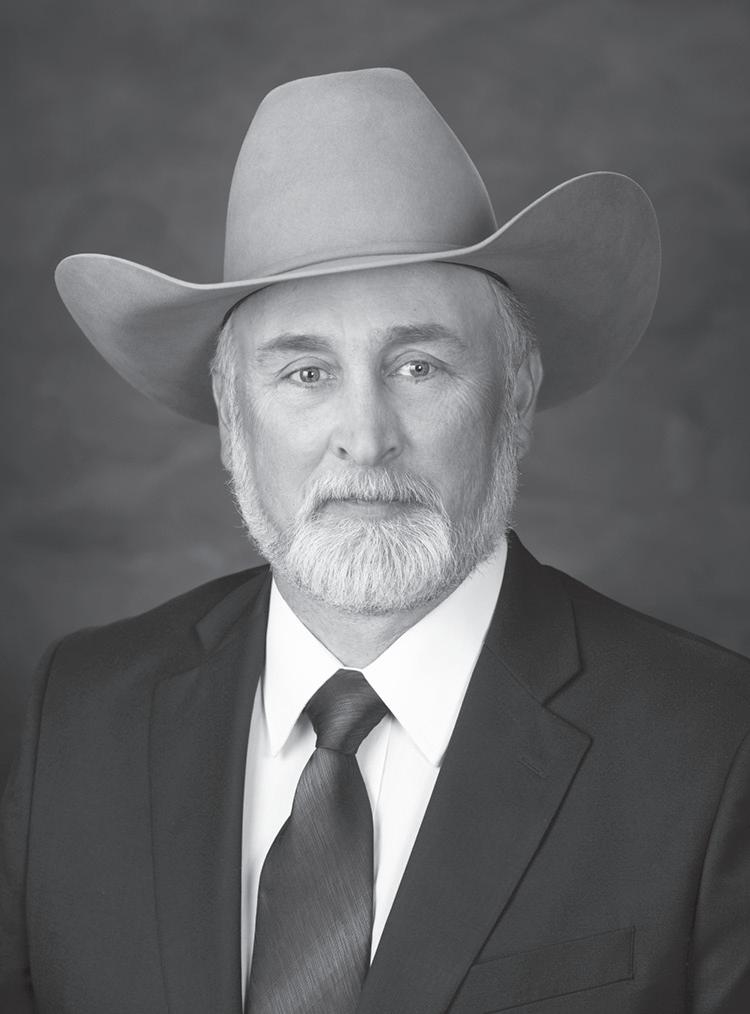
catastrophe. Imagine the chaos of an FMD outbreak, with markets shuttered and producers frantically searching for nearly illegible metal bright tags in the pouring rain. This is not a future we can afford. Some argue these changes are unnecessary or burdensome, but the reality is that clinging to outdated ideas, practices, and technology puts our entire industry at risk. USDA’s new rules call for the use of an electronic identification (EID) tag in breeding cattle, 18 months of age and older, being transported across state lines.
The 56 th PLC Annual Meeting Opens in Grand Junction. The Public Lands Council (PLC) opened up its 56 th Annual Meeting on September 18. This is where ranchers, policymakers, administration officials, and industry stakeholders from across the country meet to discuss the most urgent issues facing the public lands ranching industry. For two days, federal grazing permittees had the opportunity to shape PLC policies for the next year and heard from influential decision makers including the U.S. Department of Agriculture’s Wendy Anderson, the Bureau of Land Management’s Katie Stevens, and the U.S. Fish and Wildlife Service’s Matt Hogan.
“The annual meeting is where ranchers come together to tackle the issues our industry faces and how we can improve moving forward. Ranching on federal lands is not an easy job, and it gets tougher every year, but this is the meeting where we work to strengthen the ranching industry
This class of cattle has required an ID tag for more than a decade. USDA is simply changing the technology from a metal bright tag to an updated EID tag. Innovation has always been the backbone of American agriculture. The use of EID tag technology is not just a step forward; it’s a necessity for an industry that must be prepared for anything in a time of porous borders and uncertain global politics. USDA’s rule will allow cattle to be tracked more quickly in the event of FMD or a similar emergency when time is critical. We all know the metal clips in the ears of cattle are nearly impossible to read after a year or two. We also know that reading them, writing down the information from the tag, and transferring it to a database is slow, cumbersome, and subject to human error. These issues can be alleviated by simply running a wand over an EID tag, making traceability faster and less error prone.
There are still issues and concerns with USDA’s effort to upgrade technology. One of the issues that must be addressed is how data is gathered and stored. Producer privacy is paramount to this effort. NCBA has long advocated for tag data to be held by private, third party companies, like CattleTrace,
rather than USDA. A third party holder of information helps protect producer privacy while also allowing the rapid traceback required in the event of a disease outbreak. Cost is the other factor NCBA has worked to alleviate. To help lower the costs of USDA’s rule, NCBA was able to secure $15 million in funding for the purchase of EID tags to ensure cattle producers aren’t saddled with added compliance costs.
None of us in the agriculture community desire more government intrusion into our businesses or our lives. NCBA has stood on the front lines fighting, and, might I say, winning, many of those issues for decades. We have always stood for industry solutions to industry problems and worked to be proactive in creating those solutions. Those whose only answer is “no,” and those individuals and groups who would allow “perfect” to be the enemy of good, have created a vacuum that the government is more than happy to fill. It is past time for us, as cattle producers, to create an industry led and industry controlled solution to disease traceability. Our current system and its ability to rapidly respond to a real disease outbreak is insufficient to protect each of us and our livelihoods. Now is the time for the cattle industry to lead, not lag.
for future generations,” said PLC President Mark Roeber. “Each year, there are always advancements that can improve our production practices and make us better ranchers. This event is the premier event to meet the western grazing community and learn from experts, no matter if you are a veteran permittee or managing your first allotment.”
This year’s meeting took place as grazing permittees are facing deadly wildfires and a host of other extreme weather conditions across the West, as well as several federal rulemakings that seriously threaten ranchers’ ability to reliably access public lands.
“PLC’s Annual Meeting is the industry’s best opportunity to address generational issues that affect access to and management of federal lands. This year is a perfect example: grazing permittees are dealing with wildfire, increased regulatory burden, and uncertainty from new uses of federal land that have put additional pressure on grazing operations,” said PLC Executive Director Kaitlynn Glover.
“The direction we receive from permittees guides how PLC engages with lawmakers, agencies, and federal courts for the coming year. I look forward to robust policy debates during this week, so PLC and federal grazing permittees are well equipped for the political realities in the year ahead.”
Colorado Rancher Named New PLC President as Annual Meeting Closes. The Public Lands Council (PLC) closed out their 56 th Annual Meeting by announcing Colorado rancher Tim Canterbury as the new PLC President. Tim owns and operates his family ranch in Howard, Colo., where his family has been ranching since 1879. He has previously served as a member of the PLC Board of Directors, President of the Colorado Cattlemen’s Association (CCA), and chair of the Colorado Public Lands Council.
“As a fifth generation rancher who has been involved in livestock associations for decades, I could not be more honored to serve as president and continue fighting for federal lands ranchers,” said PLC President Tim Canterbury. “We are at a critical period in our industry, where it seems like every agency rulemaking will make it harder to continue ranching on public lands. At the same time, there are more scientific studies than ever showing the benefits ranching has on wildlife, native plants, and the landscape. It is important that we protect this industry from false narratives and defend the principles of multiple use against those that want to push
livestock off of the landscape because we are proud to be stewards of these working lands.”
“Tim is the consummate rancher and advocate for this industry, who always finds the time to promote public lands ranching. We have seen incredible engagement at the annual meeting this week, with ranchers from every western state weighing in on policy that will affect the direction of PLC and the work the new officer team will take on,” said PLC Executive Director Kaitlynn Glover. “The annual meeting provides the perfect forum for ranchers from across the West to come together and decide how we tackle the distinctive issues that unnecessarily complicate the lives of permittees. Thank you to the attendees who did the hard work to guide PLC for this coming year.”
The 2024–2025 PLC officer team, approved by the PLC General Voting Delegates, assumed their new roles at the end of this year’s Annual Meeting. Ron Cerri of Nevada was named Vice President, and Robbie LeValley of Colorado was named Secretary.
About the Public Lands Council. PLC represents public lands ranchers in Washington, D.C. Since 1968, PLC has worked with Congress and the federal land management agencies to maintain a stable business environment in which livestock producers can conserve the West and feed the nation and world. Visit www. publiclandscouncil.org to learn more.




• www.blackcrestfarm.com

Walter D. Shealy III and Family 20977 US Hwy 76 • Newberry, SC 29108 Walter Shealy
803-924-1000 Dixon Shealy • 803-629-1174 walter@blackgrove.com • dixon@blackgrove.com www.blackgrove.com





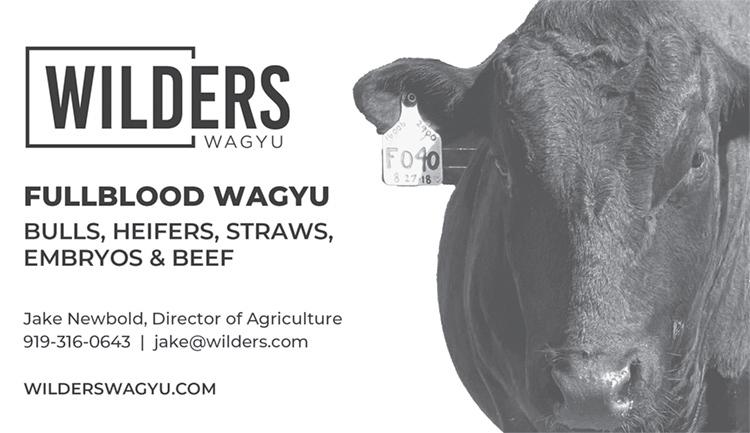

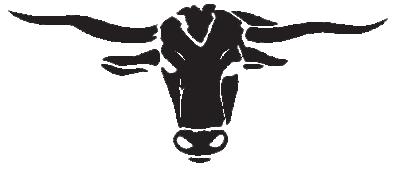


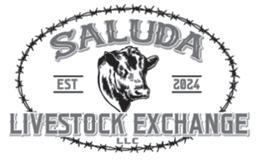







ANGUS
Oct. 12 — Chessie Creek Farm & Partners
3rd Annual Fall Bull Sale, Walterboro, S.C.
Oct. 17 — Palmetto Cattlemen’s Showcase, via DVAuction.com
Oct. 19 — Fred Smith Company Ranch
Extra Effort Fall Sale, Clayton, N.C.
Oct. 19 — Whitestone Farm Brand of Quality Angus Sale, Adie, Va.
Oct. 25 — Virginia Tech 30th Annual Hokie Harvest Sale, Blacksburg, Va.
Oct. 25 — Yon Family Farms Maternal Roots Fall Female Sale, Ridge Spring, S.C.
Oct. 26 — Yon Family Farms Maternal Roots Fall Bull Sale, Ridge Spring, S.C.
Nov. 2 — Barnett Angus Ranches
5th Annual BAR Production Sale, Washington, Ga.
Nov. 2 — Châtel Farms Fall Bull Sale, Reidsville, Ga.
Nov. 2 — 16th Annual SimAngus Solution Bull & Replacement Female Sale, Burlington, N.C.
Nov. 2 — TJB Gelbvieh & Balancer Maternal Magic XIII Annual Bull Sale, Chickamauga, Ga.
Nov. 9 — 23rd Annual E.B. & Shane Harris
Influence Female & Bull Sale, Oxford, N.C.
Nov. 9 — Gibbs Farms 19th Annual Bull & Replacement Female Sale, Ranbourne, Ala.
Nov. 14 — The Bull Sale at Circle “G” Ranches, Adel, Ga.
Nov. 16 — Southeast Bull Expo & Sale, Asheboro, N.C.
Nov. 23 — McMahan Farm & Hancock
Angus Annual Registered Angus Bull Sale, Mocksville, N.C.
Nov. 30 — 8th Annual Boys from the South Bull Sale, Lebanon, Tenn.
Dec. 6 — Knoll Crest Farm Total Performance Bull Sale, Red House, Va.
Dec. 7 — 49th Annual Union County Performance Tested Bull Sale, Monroe, N.C.
Dec. 14 — Brushy Mountain Genetics Sale, Taylorsville, N.C.
2025
Jan. 4 — EBS Farms Select Bull & Female Sale, Norwood, N.C.
Feb. 1 — Clemson Bull Test Sale, Clemson, S.C.
Feb. 13 — 32nd Edition of the UGA Focus on Genomics Enhanced EPDs Bull Sale, Athens, Ga.
Feb. 15 — Yon Family Farms Spring Bull & Female Sale, Ridge Spring, S.C.
Apr. 12 — Knoll Crest Farm Spring Bull & Female Sale, Red House, Va.
Brahman
Oct. 11 — Circle F Farms Annual Dinner, Baxley, Ga.
Oct. 12 — Circle F Farms Fall Sale, Baxley, Ga.
Brangus
Oct. 11 — Circle F Farms Annual Dinner, Baxley, Ga.
Oct. 12 — Circle F Farms Fall Sale, Baxley, Ga.
Oct. 25 — Yon Family Farms Maternal Roots Fall Female Sale, Ridge Spring, S.C.
Oct. 26 — Yon Family Farms Maternal Roots Fall Bull Sale, Ridge Spring, S.C.
2025
Feb. 1 — Clemson Bull Test Sale, Clemson, S.C.
Feb. 15 — Yon Family Farms Spring Bull & Female Sale, Ridge Spring, S.C.
Charolais
Oct. 5 — Southern Connection Sale, Knoxville, Tenn.
Oct. 24 — JMAR Genetics “Quality Over Quantity” Charolais Bull & Female Sale, via DVAuction.com
Oct. 25 — Virginia Tech 30th Annual Hokie Harvest Sale, Blacksburg, Va.
GELBVIEH
Nov. 2 — TJB Gelbvieh & Balancer
Maternal Magic XIII Annual Bull Sale, Chickamauga, Ga.
Nov. 30 — 8th Annual Boys from the South Bull Sale, Lebanon, Tenn.
Dec. 6 — Knoll Crest Farm Total
Performance Bull Sale, Red House, Va.
Dec. 7 — 49th Annual Union County
Performance Tested Bull Sale, Monroe, N.C.
2025
Feb. 1 — Clemson Bull Test Sale, Clemson, S.C.
Oct. 21 — White Hawk Ranch & Mead Cattle - Georgia’s Fall Big Event, Buchanon, Ga.
Oct. 25 — Virginia Tech 30th Annual
Hokie Harvest Sale, Blacksburg, Va.
Nov. 23 — Southern Partners in Performance Sale, Union Grove, N.C.
Dec. 6 — Knoll Crest Farm Total Performance Bull Sale, Red House, Va.
Dec. 14 — Brushy Mountain Genetics Sale, Taylorsville, N.C.
2025
Feb. 1 — Clemson Bull Test Sale, Clemson, S.C.
Mar. 22 — 57th Annual N.C. Hereford
Classic Sale, Union Grove, N.C.
Apr. 12 — Knoll Crest Farm Spring Bull & Female Sale, Red House, Va.
Red angus
Oct. 10 — Bieber Fever in the Southeast, Swainsboro, Ga.
Oct. 17 — Palmetto Cattlemen’s Showcase, via DVAuction.com
Nov. 9 — 23rd Annual E.B. & Shane Harris
Influence Female & Bull Sale, Oxford, N.C.
2025
Feb. 1 — Clemson Bull Test Sale, Clemson, S.C.
santa Gertrudis
Nov. 9 — 23rd Annual E.B. & Shane Harris Influence Female & Bull Sale, Oxford, N.C.
SIMMENTAL
Oct. 12 — Chessie Creek Farm & Partners 3rd Annual Fall Bull Sale, Walterboro, S.C
Oct. 19 — Fred Smith Company Ranch Extra Effort Fall Sale, Clayton, N.C.
Oct. 25 — Virginia Tech 30th Annual Hokie Harvest Sale, Blacksburg, Va.
Oct. 25 — Yon Family Farms Maternal Roots Fall Female Sale, Saluda, S.C.
Oct. 26 — Yon Family Farms Maternal Roots Fall Bull Sale, Saluda, S.C.
Nov. 2 — 16th Annual SimAngus Solution Bull & Replacement Female Sale, Burlington, N.C.
Nov. 9 — 23rd Annual E.B. & Shane Harris Influence Female & Bull Sale, Oxford, N.C.
Nov. 9 — Gibbs Farms 19th Annual Bull & Replacement Female Sale, Ranbourne, Ala.
Dec. 7 — 49th Annual Union County Performance Tested Bull Sale, Monroe, N.C.
2025
Feb. 1 — Clemson Bull Test Sale, Clemson, S.C.
Feb. 15 — Yon Family Farms Spring Bull & Female Sale, Ridge Spring, S.C.
Nov. 17 — Wilders Wagyu StayWILD Now Fullblood Wagyu Online Genetics Sale
Nov. 2 — Châtel Farms Fall Bull Sale, Reidsville, Ga.
Nov. 9 — 23rd Annual E.B. & Shane Harris Influence Female & Bull Sale, Oxford, N.C.
2025
Nov. 1 — Wilders Wagyu StayWILD ‘25 Production Sale, Turkey, N.C.
OTHER EVENTS
Oct. 3 — Forage & Grassland Management Webinar Series
Oct. 9-20 — S.C. State Fair, Columbia, S.C.
Oct. 17-26 — N.C. State Fair, Raleigh, N.C.
Oct. 30 — North Carolina Cattle Industry Assessment Referendum
Nov. 1 — Multi-Species Forage & Grazing Fall Field Day, Deep Run, N.C.
Nov. 14 — Graded Feeder Calf Sale, Norwood, N.C.
Livestock market sales
Oct. 1 — Mid-Atlantic Cattle Sales Video Auction, via macsvideo.com
Oct. 2 — Stanly County Livestock Market Weekly Sale, Norwood, N.C.
Oct. 7 — Harward Brothers Livestock Market Weekly Sale, Statesville, N.C.
Oct. 7 — Saluda Livestock Exchange Weekly Sale, Saluda, S.C.
Oct. 9 — Stanly County Livestock Market Weekly Sale, Norwood, N.C.
Oct. 14 — Harward Brothers Livestock Market Weekly Sale, Statesville, N.C.
Oct. 14 — Saluda Livestock Exchange Weekly Sale, Saluda, S.C.
Oct. 15 — Mid-Atlantic Cattle Sales Video Auction, via macsvideo.com
Oct. 16 — Stanly County Livestock Market Weekly Sale, Norwood, N.C.
Oct. 21 — Harward Brothers Livestock Market Weekly Sale, Statesville, N.C.
Oct. 21 — Saluda Livestock Exchange Weekly Sale, Saluda, S.C.
Oct. 23 — Stanly County Livestock Market Weekly Sale, Norwood, N.C.
Oct. 28 — Harward Brothers Livestock Market Weekly Sale, Statesville, N.C.
Oct. 28 — Saluda Livestock Exchange Weekly Sale, Saluda, S.C.
Oct. 30 — Stanly County Livestock Market Weekly Sale, Norwood, N.C.
Nov. 4 — Harward Brothers Livestock Market Weekly Sale, Statesville, N.C.
Nov. 4 — Saluda Livestock Exchange Weekly Sale, Saluda, S.C.
Nov. 5 — Mid-Atlantic Cattle Sales Video Auction, via macsvideo.com
Nov. 6 — Stanly County Livestock Market Weekly Sale, Norwood, N.C.
Nov. 11 — Harward Brothers Livestock Market Weekly Sale, Statesville, N.C.
Nov. 11 — Saluda Livestock Exchange Weekly Sale, Saluda, S.C.
Nov. 13 — Stanly County Livestock Market Weekly Sale, Norwood, N.C.
Nov. 18 — Harward Brothers Livestock Market Weekly Sale, Statesville, N.C.
Nov. 18 — Saluda Livestock Exchange Weekly Sale, Saluda, S.C.
Nov. 19 — Mid-Atlantic Cattle Sales Video Auction, via macsvideo.com
Nov. 21 — Stanly County Livestock Market Weekly Sale, Norwood, N.C.
Nov. 25 — Harward Brothers Livestock Market Weekly Sale, Statesville, N.C.
Nov. 25 — Saluda Livestock Exchange Weekly Sale, Saluda, S.C.
